
THE AYURVEDIC PHARMACOPOEIA
OF INDIA
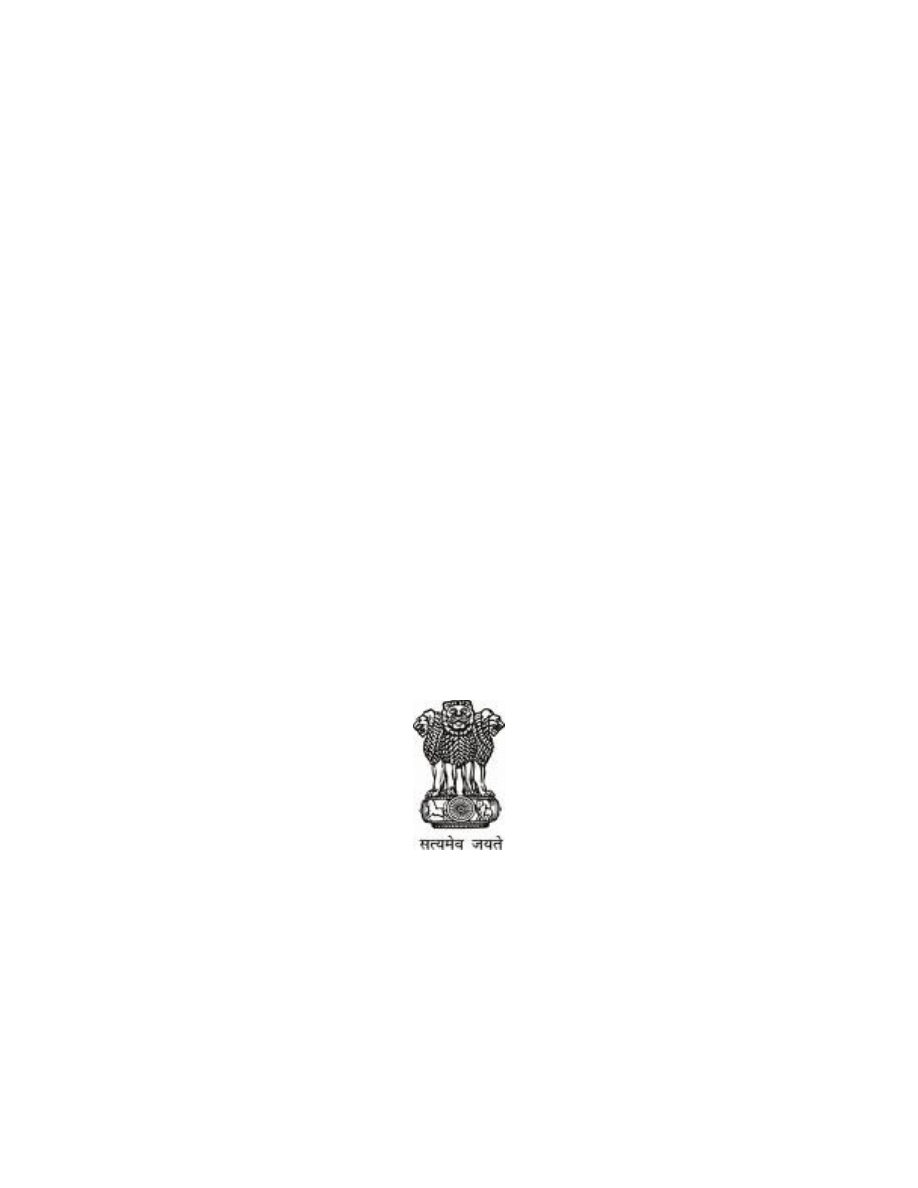
THE AYURVEDIC PHARMACOPOEIA
OF INDIA
PART - II (FORMULATIONS)
VOLUME - I
First Edition
GOVERNMENT OF INDIA
MINISTRY OF HEALTH AND FAMILY WELFARE
DEPARTMENT OF AYURVEDA, YOGA & NATUROPATHY,
UNANI, SIDDHA AND HOMOEOPATHY,
NEW DELHI
2007

CONTENTS
PAGE
LEGAL NOTICES
-
-
XII
GENERAL NOTICES
-
-
XIII
PREFACE
-
-
XXIII
INTRODUCTION
-
-
XXX
MONOGRAPHS
Avaleha:
General Description
1
1. A
¾°
ā
¬
gāvaleha
( A.F.I. - II )
2
2. Bhallātakādi Modaka
( A.F.I. - I )
4
3. Bilvādi Leha
( A.F.I. - I )
7
4. Citraka Harītakī
( A.F.I. - I )
10
5. Cyavanaprāśa
( A.F.I. - I )
13
6. Kalyā
´
aka leha
( A.F.I. - II )
17
7. Kūsmāndaka Rasāyana
( A.F.I. - I )
20
8. Mrdvīkādi lehya
( A.F.I. - I )
23
9. Pūga Kha
´²
a
( A.F.I. - I )
26
10. Sū
¨
anāvaleha
( A.F.I. - I )
29
11. Vāsāvaleha
( A.F.I. - I )
32
12. Vyāghrī Harītakī
( A.F.I. - II )
35
Cūr
´
a:
General Description
38
13. Āmalakyādi Cūr
´
a
( A.F.I. - I )
39
14. Avipattikara Cūr
´
a
( A.F.I. - I )
41
15. Bālacāturbhadrikā Cūr
´
a
( A.F.I. - I )
43
16. Elādi Cūr
´
a
( A.F.I. - I )
45
17. Hi
¬
gva
¾°
aka Cūr
´
a
( A.F.I. - I )
47
18. Navāyasa Cūr
´
a
( A.F.I. - I )
49
19. Nimbādi Cūr
´
a
( A.F.I. - I )
51
20. Pañcasama Cūr
´
a
( A.F.I. - I )
53
21. Pu
¾
yānuga Cūr
´
a
( A.F.I. - I )
55
22. Tālīsādya Cūr
´
a
( A.F.I. - I )
57
23. Vaiśvānara Cūr
´
a
( A.F.I. - I )
59
Gh
¨
ta:
General Description
61
24. Brāhmī Gh
¨t
a
( A.F.I. - I )
63

25. Daśamūla Gh
¨°
a
( A.F.I. - I )
65
26. Daśamūla
¾
a
°
palaka Gh
¨°
a
( A.F.I. - I )
68
27. Dhātryādi Gh
¨°
a
( A.F.I. - I )
71
28. Jātyādi Gh
¨°
a
( A.F.I. - I )
73
29. Kalyā
´
aka Gh
¨°
a
( A.F.I. - I )
75
30. Pañcagavya Gh
¨°
a
( A.F.I. - I )
78
31. Pañcatikta Gh
¨°
a
( A.F.I. - I )
80
32. Phala Gh
¨°
a
( A.F.I. - I )
82
33. Sārasvata Gh
¨°
a
( A.F.I. - I )
85
34. Traika
´°
aka Gh
¨°
a
( A.F.I. - I )
87
35. Triphalā Gh
¨°
a
( A.F.I. - I )
90
Guggulu:
General Description
93
36. Kaiśora Guggulu
( A.F.I. - I )
94
Gutika:
General Description
97
37. Maricādi Gut#ikā
(A.F.I. - I )
98
āra$Ks / Lava
´
a
General Description
100
38. Apāmārga Ks$āra
( A.F.I. - I )
101
39. Arka Lava
´
a
( A.F.I. - I )
103
40. Kalyā
´
aka Ks$āra
( A.F.I. - I )
105
41. Mūlaka Ks$āra
( A.F.I. - I )
107
42. Palāśa Ks$āra
( A.F.I. - I )
109
43. Yava Ks$āra
( A.F.I. - I )
111
Taila:
General Description
113
44.
Balāgu
²
ūcyādi Taila
( A.F.I. - I )
115
45.
Dhānvantara Taila
( A.F.I. - I )
117
46.
Gandharvahas
°
a Taila
( A.F.I. - I )
120
47.
Ko
°°
amcukkādi Taila
( A.F.I. - I )
122
48.
K
¾
īrabalā Taila
( A.F.I. - I )
124
49.
Saindhavādi Taila
( A.F.I. - I )
126
Lepa:
General Description
128
50.
Dārvī Malahara (Gel)
(Based on Charaka Chi. 25/93)
129
APPENDIX – 1. Apparatus for Tests & Assays
133

1.1 Nessler Cylinders
133
1.2 Sieves
133
1.3 Thermometers
134
1.4 UV Lamps
134
1.5 Volumetric Glassware
135
1.6 Weights and Balances
135
1.7 Muslin Cloth
135
APPENDIX – 2. Tests and Determinations
136
2.1 Microscopic Identification
136
2.2 Determination of Quantitative Data
140
2.2.1 Net Content
140
2.2.2 Foreign Matter
140
2.2.3 Total Ash
140
2.2.4 Acid-Insoluble Ash
140
2.2.5 Water-Soluble Ash
140
2.2.6 Sulphated Ash
140
2.2.7 Alcohol-Soluble Extractive
141
2.2.8 Water-Soluble Extractive
141
2.2.9 Ether-Soluble Extractive (Fixed Oil Content)
141
2.2.10 Moisture Content (Loss on Drying)
141
2.2.11 Volatile Oil in Drugs
142
2.2.12 Special Processes Used In Alkaloidal Assays
143
2.2.13 Thin Layer Chromatography (TLC)
144
2.2.14 Starch Estimation (Mont Gomery, 1957)
146
2.2.15 Sugar Estimation (Mont Gomery, 1957)
147
2.2.16 Fatty oil Estimation
147
2.2.17 Protein Estimation (Lowry et al, 1951)
147
2.2.18 Method for Alkaloid Estimation
147
2.3 Limit Tests
147
2.3.1 Limit Test for Arsenic
148
2.3.2 Limit Test for Chlorides
153
2.3.3 Limit Test for Heavy Metals
153
2.3.4 Limit Test for Iron
156
2.3.5 Limit Test for Lead
156
2.3.6 Limit Test for Sulphates
158
2.3.7 Heavy Metals by Atomic Absorption Spectrophotometry
158
2.4. Microbial Limit Tests
163
2.4.1. Total Aerobic Microbial Count
172
2.4.2. Tests for Specified Micro-organisms
175
2.5. Pesticide Residues
179

2.5.1 Qualitative and Quantitative Analysis of Pesticide Residues
181
2.5.2. Test for Pesticides
182
2.5.3. Quantitative Analysis
183
2.6. Gas Chromatography
186
2.7. Test for Aflatoxin
188
APPENDIX – 3. Physical Tests and Determinations
190
3.1. Refractive Index
190
3.2. Weight per Millilitre and Specific Gravity
190
3.3. Determination of pH Value
191
3.4. Determination of Melting and Congealing Range
191
3.4.1 Determination of Melting Range
191
3.4.2 Determination of Congealing Range
194
3.5 Determination of Boiling Range
195
3.6. Determination of Optical Rotation
196
3.7. Determination of Viscosity
198
3.8. Determination Total Solids
199
3.9 Solubility in Water
199
3.10. Determination of Saponification Value
199
3.11. Determination of Iodine Value
200
3.12. Determination of Acid Value
201
3.13. Determination of Peroxide Value
201
3.14. Determination of Unsaponifiable Matter
202
3.15. Detection of Mineral Oil (Holde’s Test)
202
3.16. Rancidity Test (Kreis Test)
203
3.17. Determination of Alcohol Content
203
APPENDIX – 4. Reagents and Solution
207
APPENDIX – 5. Chemical Tests and Assays
239
5.1.1. Estimation of Total Phenolics
239
5.1.2. Estimation of Total Tannins
239
5.1.3. Estimation of Sugars
239
5.1.3.1. Reducing Sugars
240
5.1.3.2. Total Sugars
240
5.1.3.3. Non-reducing Sugars
240
5.1.4. Estimation of Curcumin by TLC Densitometer
241
5.2.1. Determination of Aluminium
241
5.2.2. Determination of Borax
242
5.2.3. Determination of Calcium
242
5.2.4. Determination of Copper
243
5.2.5. Determination of Iron (Fe)
243
5.2.6. Determination of Magnesium
244

5.2.7. Determination of Mercury
244
5.2.8. Determination of Silica (SiO2)
245
5.2.9. Estimation of Sodium and Potassium by Flame Photometry
245
5.2.10. Determination of Sodium chloride
246
5.2.11. Determination of Sulphur
246
5.2.12.- Qualitative Reactions of some Radicals:
246
APPENDIX – 6. Ayurvedic Definition and Methods
248
6.1. Kalpanā Paribhāsā
248
6.1.1. Kalka
248
6.1.2. Kvātha / Ka
¾
āya
248
6.1.3. Cūr
´
a
248
6.1.4. Pu
°
apāka Svarasa
248
6.1.5. Svarasa
248
6.1.6. Hima Ka
¾
āya
248
6.2. Sāmānya Paribhā
¾
ā
249
6.2.1. Kajjal
ī
249
6.2.2. Kā
®
jika
249
6.2.3. K
¾
āra
249
6.2.4 Cūr
´
odaka
249
6.2.5. Prak
¾
epa
249
6.2.6. Bhāvanā
250
6.2.7. Śodhana
250
6.2.7.1. Godanti Śodhana
250
6.2.7.2. Gairika Śodhana
250
6.2.7.3. Gandhaka Śodhana:
251
6.2.7.4. Guggulu Śodhana:
251
6.2.7.5.
¯
a
¬
ka
´
a Śodhana:
251
6.2.7.6. Tuttha Śodhana:
251
6.2.7.7. Bhallātaka Śodhana:
252
6.2.7.8. Manaªśilā Śodhana:
252
6.2.7.9. Vatsanābha Śodhana:
252
6.2.7.10. Śilājatu Śodhana:
252
6.2.7.11. Haritāla Śodhana:
253
6.2.7.12. Hi
¬
gu Śodhana:
253
6.2.7.13. Pārada Sāmānya Śodhana:
253
6.2.7.14. A
¾°
asa
¼
skāra of Pārada
254
6.2.8. Mūrchana
257
6.2.8.1. Mūrchana of Era
´²a
Taila
258
6.2.8.2. Mūrchana of Gh
¨
ta
258

6.2.8.3. Mūrchana of Taila
259
6.3. Yantra Paribhā
¾
ā
259
6.3.1. Khalva Yantra
260
6.3.2. Tiryak pātana Yantra
260
6.3.3.
±
amarū Yantra
260
6.3.4. Dolā Yantra
260
APPENDIX – 7. Weights and Measures.
261
7.1 Metric Equivalents of Classical Weights and Measures.
261
7.2 Metric System.
262
APPENDIX – 8. Classical Ayurvedic References.
263
APPENDIX – 9. List of Single Drugs used in Formulation, with Latin
276
Nomenclatures
APPENDIX – 10. Bibliography.
280

LEGAL NOTICES
In India there are laws dealing with drugs that are the subject of monographs
which follow. These monographs should be read subject to the restrictions imposed by
these laws wherever they are applicable.
It is expedient that enquiry be made in each case in order to ensure that the
provisions of the law are being complied with.
In general, the Drugs & Cosmetics Act, 1940 (subsequently amended in 1964 and
1982), the Dangerous Drugs Act, 1930 and the Poisons Act, 1919 and the rules framed
thereunder should be consulted.
Under the Drugs & Cosmetics Act, the Ayurvedic Pharmacopoeia of India
(A.P.I.), Part-II, Vol. I, is the book of standards for compound formulations included
therein and the standards prescribed in the Ayurvedic Pharmacopoeia of India, Part-II,
(Formulation) Vol. I, would be official. If considered necessary these standards can be
amended and the Chairman of the Ayurvedic Pharmacopoeia Committee’s authorised to
issue such amendements. Whenever such amendments are issued the Ayurvedic
Pharmacopoeia of India, Part-II (Formulation), Vol. I, would be deemed to have been
amended accordingly.

GENERAL NOTICES
Title : The title of the book is “Ayurvedic Pharmacopoeia of India, Part-II (Formulations)
Volume-I. Wherever the abbreviation “API, Pt.-II,Vol.-I” is used, it may be presumed to
stand for the same and the supplements or amendments thereto.
Name of the Formulation: The name given on top of each monograph is in Samskrt, as
mentioned in the Ayurvedic Formulary of India (AFI) and will be considered official.
These names have been arranged in English alphabetical order under each category of
dosage form.
Ingredients and Processes: Formulations are prepared from individual ingredients that
comply with the requirements for those individual ingredients for which monographs are
provided in the volumes of API, Part-I. Where water is used as an ingredient it should
meet the requirements for Potable Water covered by its monograph in the Ayurvedic
Pharmacopoeia of India-Part-I.
Monograph for each formulation includes the full composition together with
directions for its preparation. Such composition and directions are intended for
preparation of small quantities for short-term supply and use. When so prepared, no
deviation from the stated composition and directions is permitted. However, if such a
preparation is manufactured on a large scale with the intention of sale or distribution,
deviations from the directions given are permitted, but maintaining the same ratio as
stated in the monographs with the ingredients complying with the compendial
requirements, and also that the final product meets the following criteria:
(a) complies with all of the requirements stated in the monograph on compound
formulations,
(b) in the composition of certain formulations it has been allowed that a specified part of
the plant may be substituted by another part of the same plant. In such cases the
manufacturer should mention on the label the actual part of the plant used in the
formulation.
(c) wherever an ‘official substitute’ is provided for, deviation from the original
formulation is permitted, using the ‘official substitute’.
(d) wherever a formulation composition specifies a drug that is banned from commerce,
this may be omitted, and the fact mentioned on the label.
If a preparation is intended to be stored over a period of time, deterioration due to
microbial contamination may be inhibited by the addition to the formula of a permitted
preservative. In such circumstances the label should state the concentration of the
preservative and the appropriate storage conditions. It is implied that such a preparation
will be effectively preserved according to the appropriate criteria applied.

The direction that an ingredient in a formulation must be freshly prepared
indicates that it must be prepared and used within 24 hours.
Monograph: Each monograph begins with a definition and introductory paragraph
indicating the formulation composition, scientific names of the drugs used with their
botanical parts along with a brief account of the method of preparation.
The requirements given in the monographs are not framed to provide against all
impurities, contaminants or adulterants; they provide appropriate limits only for possible
impurities that may be permitted to a certain extent. Material found to contain an
impurity, contaminant or adulterant which is not detectable by means of the prescribed
tests are also to be considered as impurity should rational consideration require its
absence.
Standards: For statutory purposes, the following shall be considered official standards:
Definition, Formulation composition, Identification, Physico-chemical parameters, Assay
and Other requirements.
Added Substances: A formulation contains no added substances except when
specifically permitted in the individual monograph. Unless otherwise specified in the
individual monograph, or elsewhere in the General Notices, suitable substances may be
added from the approved list of Drugs and Cosmetics Rules, under Rule 169 to a
formulation to enhance its stability, usefulness, elegance, or to facilitate its preparation.
Such auxiliary substances shall be harmless in the amounts used, shall not exceed the
minimum quantity required to provide their intended effect, shall not impair the
therapeutic efficacy or the bioavailability and safety of the preparation and shall not
interfere with the tests and assays prescribed for determining compliance with the official
standards. Particular care should be taken to ensure that such substances are free from
harmful organisms. Though the manufacturer of a formulation is given the freedom to use
an added substance, the manufacturer must guarantee the innocuousness of the added
substance. The manufacturer shall also be responsible to explain to the appropriate
authority, if needed, regarding the purpose of the added substance(s).
Description: Statement given under this title is not to be interpreted in a strict sense
although they may help in the evaluation of an article. However substantial departure
form the requirement will not be acceptable.
Capital Letters in the Text: The names of the Pharmacopoeial substances, preparations
and other materials in the text are printed in capital initial letters, and these infer that
materials of Pharmacopoeial quality have been used.
Italics: Italic types are used for Scientific names of the plant drugs and microorganisms,
and for some sub-headings and certain notations of the chemical names. Italic types have
also been used for words which refer to solvent system in TLC procedure, reagents and

substances, processes covered under Appendices. Chemicals and Reagents and
Substances of Processes in Appendices have also been printed in Italics.
Odour and Taste: Wherever a specific odour has been observed it has been mentioned
as characteristic for that formulation, but the description as ‘odourless’ or ‘no odour’ has
generally been avoided in the Description where a substance has no odour. Where a
characteristic odour is said to be present it is examined by smelling the drug directly after
opening the container. If such an odour is discernible, the contents are rapidly transferred
to an open vessel and re-examined after 15 minutes. If odour persists to be discernible,
the sample complies with the description for odour, characteristic for that formulation.
The taste of a drug is examined by taking a small quantity of drug by the tip of
moist glass rod and allowing it on tongue previously moistened with water. This does not
apply in the case of poisonous drugs.
Powder fineness: Wherever the powder of a drug is required, it shall comply with the
mesh number indicated in the Monograph.
Where particle size is prescribed in a Monographs, the specified sieve number are used to
fractionate a weighed representative sample from the container, each fraction weighed
separately, and expressed as a percentage of the weight taken initially, to obtain
compliance with the monograph.
Weights and Measures: The metric system of weights and measures is employed.
Weights are given in multiples or fractions of a gram (g) or of a milligram (mg). Fluid
measures are given in multiples of fraction of milliliter (ml). The amount stated is
approximate but the quantity actually used must be accurately weighed and must not
deviate by more than 10 per cent from the one stated.
When the term “drop” is used measurement is to be made by means of a tube
which delivers 20 drops per gram of distilled water at 150.
Identity, Purity and Strength: Under the heading “Identification”, tests are provided as
an aid to identification and are described in the respective monographs. Microscopical
characters are prescribed for the individual ingredients where these do not exceed ten in
number, added ‘in situ’. Appendix 2.1 gives detailed procedure
Vegetable drugs used in formulations, should be duly identified and authenticated
and be free from insects, pests, fungi, micro organisms, pesticides, and other animal
matter including animal excreta, be within the permitted and specified limits for lead,
arsenic and heavy metals, and show no abnormal odour, colour, sliminess, mould or any
sign of deterioration.
The quantitative tests like total ash, acid-insoluble ash, water-soluble ash,
alcohol-soluble extractive, water-soluble extractive, moisture content, volatile oil content

and assays are the parameters upon which the standards of Pharmacopoeia depend.
Except for Assays, which are covered under each monograph, the methods of
determination for others are given in Appendices, with a suitable reference to the specific
appendix.
The analyst is not precluded from employing an alternate method in any instance
if he is satisfied that the method, which he uses will give the same result as the
Pharmacopoeial method described under assay. However, in the event of doubt or dispute
the methods of analysis of the Pharmacopoeia are alone authoritative. Unless otherwise
prescribed, the assays and tests are carried out at a temperature between 200 and 300.
In the performance of assay or test procedures, not less than the specified number
of dosage units should be taken for analysis. Proportionately larger or smaller quantities
than the specified weights and volumes of assay or test substances and Reference
Standards or Standard Preparations may be taken, provided the measurement is made
with at least equivalent accuracy and provided that any subsequent steps, such as
dilutions, are adjusted accordingly to yield concentrations equivalent to those specified
and are made in such manner as to provide at least equivalent accuracy.
Where it is directed in the assay for Tablet formulation to “weigh and powder not
less than” a given number, usually 20, of the tablets, it is intended that a counted number
of tablets shall be weighed and reduced to a fine powder. Likewise, where it is directed
in the assay for Capsules to remove, as completely as possible, the contents of not less
than a given number, usually 20, of the capsules, it is intended that a counted number of
capsules should be carefully opened and the contents quantitatively removed, combined,
mixed, and weighed accurately. The portion of the powdered tablets or the mixed
contents of the capsules taken for assay is representative of the whole tablets or capsules,
respectively, and is, in turn, weighed accurately. The result of the assay is then related to
the amount of active ingredients per tablet in the case of tablets and per capsule in the
case of capsules from the weight of contents of each tablet/capsule.
Limits for Heavy metals, Microbial load, Pesticide residues and Aflatoxins :
Formulations included in this volume are required to comply with the limits for heavy
metals, microbial load, pesticide residues and aflatoxins prescribed in individual
monographs and wherever limit is not given they must comply with the limits given in
Appendix. The methods for determination of these parameters are given in Appendices.
Thin Layer Chromatography (TLC): Under this title, wherever given, the Rf values
given in the monographs are not absolute but only indicative. The analyst may use any
other solvent system and detecting reagent to establish the identity of any particular
chemical constituent reported to be present in the formulation. However in case of dispute
the pharmacopoeial method would prevail. Unless specified in the individual monograph
all TLC have been carried out on pre-coated Silica gelG F254 aluminium plates.

Reference Standards: Reference substance and standard preparation are authentic
substances that have been verified for there suitability for use as standards for comparison
in some assays, tests and TLC of the API.
Constant Weight: The term “constant weight” when it refers to drying or ignition means
that two consecutive weighing do not differ by more than 1.0 mg per gram of the
substance taken for the determination, the second weighing following an additional hour
of drying or further ignition.
Percentage of Solutions – In defining standards, the expression per cent (%), is used,
according to circumstances, with one of the four meanings given below.
Per cent w/w (percentage weight in weight) expresses the number of grams of active
substance in 100 grams of product.
Per cent w/v (percentage weight in volume) expresses the number of grams of active
substance in 100 milliliters of product.
Per cent v/v (percentage volume in volume) expresses the number of milliliters of active
substance in 100 milliliters of product.
Per cent v/w (percentage volume in weight) expresses the number of milliliters of active
substance in 100 grams of product.
Percentage of Alcohol: All statements of percentage of alcohol (C2H5OH) refer to
percentage by volumes at 15.560c.
Temperature: Unless otherwise specified all temperatures refer to centigrade (Celsius),
thermometric scale and all measurement are made at 250.
Solutions: Unless otherwise specified in the individual monograph, all solutions are
prepared with Purified Water.
Reagents and Solutions: Reagents required for the assay and tests of the Pharmacopoeia
are defined in the Appendix showing the nature, degree of the purity and strength of
solutions to be made from them.
Filtration: Where it is directed to filter, without further qualification, it is intended that
the liquid be filtered through suitable filter paper or equivalent device until the filtrate is
clear.
Soluble substances: The following table indicates the meaning of degree of solubilities:
_____________________________________________________________
Descriptive Terms
Relative quantities of solvent

_____________________________________________________________
Very soluble
less than 1 part
Freely soluble
from 1 to 10 parts
Soluble
from 10 to 30 parts
Sparingly soluble
from 30 to 100 parts
Slightly soluble
from 100 to 1000 parts
Very slightly soluble
from 1000 to 10,000 parts
Practically insoluble
more than 10,000 parts
_____________________________________________________________
The term ‘partly soluble’ is used to describe a mixture of which only some of the
components dissolve.
Therapeutic uses: Therapeutic uses of the formulations mentioned in this
Pharmacopoeia are as given in the Ayurvedic Formulary of India.
Doses: The doses mentioned in each monograph are in metric system which are the
approximate conversions from classical weights mentioned in Ayurvedic texts. A
conversion table is appended giving classical weights with their metric
equivalents.(Appendix 7) Doses mentioned in the Ayurvedic Pharmacopoeia of India
(API) are intended merely for general guidance and represent, unless otherwise stated, the
average range of quantities per dose which is generally regarded suitable by clinicians for
adults only when administered orally. They are not to be regarded as binding upon the
prescribers.
The medical practitioner will exercise his own judgment and act on his own
responsibility in respect of the amount of the formulation he may prescribe or administer
or on the frequency of its administration. If it is usual to administer a medicine by a
method other than by mouth, the single dose suitable for that method of administration is
mentioned.
Storage: Statement under the heading ‘Storage’ constitutes non-mandatory advice. The
substances and preparations of the Pharmacopoeia are to be stored under conditions that
prevent contamination and, as far as possible, deterioration. Precautions that should be
taken in relation to the effects of the atmosphere, moisture, heat and light are indicated,
where appropriate, in the individual monographs.
Specific directions are given in some monographs with respect to the temperatures
at which Pharmacopoeial articles should be stored, where it is considered that storage at a
lower or higher temperature may produce undesirable results. The conditions are defined
by the following terms.
Cold- Any temperature not exceeding 80 and usually between 20 and 80. A refrigerator is
cold place in which the temperature is maintained thermostatically between 20 and 80.

Cool- Any temperature between 80 and 250. An article for which storage in a cool place
is directed may, alternately, be stored in a refrigerator, unless otherwise specified in the
individual monograph.
Room temperature-The temperature prevailing in a working area.
Warm- Any temperature between 300 and 400.
Excessive heat - Any temperature above 400.
Protection from freezing- Where, in addition to the risk of breaking of the container,
freezing results in loss of strength or potency or in destructive alteration of the
characteristics of an article the label on the container bears an appropriate instruction to
protect from freezing.
Storage under non-specific conditions- Where no specific storage directions or
limitations are given in the individual monograph, it is to be understood that the storage
conditions include protection from moisture, freezing and excessive heat.
Containers: The container is the device that holds the article. The immediate container
is that which is in direct contact with the article at all times. The closure is a part of the
container.
The container is designed so that the contents may be taken out for the indented purpose
in a convenient manner. It provides the required degree of protection to the contents from
the environmental hazards.
The container should not interact physically or chemically with the article placed in it so
as to alter the strength, quality or purity of the article beyond the official requirements.
Prior to its being filled, the container should be clean. Special precautions and cleaning
procedures may be necessary to ensure that each container is clean and that extraneous
matter is not introduced into or onto the article.
Light-resistant Container- A light resistant container protects the contents from the
effects of actinic light by virtue of the specific properties of the material of which it is
made. Alternatively, a clear and colourless or a translucent container may be made
light-resistant by means of an opaque (light-resistant) covering and/or stored in a dark
place: in such cases, the label on the container should bear a statement that the opaque
covering or storage in dark place is needed until the contents have been used up.
Well-closed Container- A well-closed container protects the contents from extraneous
solids and liquids and from loss of the article under normal conditions of handling,
shipment, storage and distribution.

Tightly-closed Container- A tightly-closed container protects the contents form
contamination by extraneous liquids solids or vapours, from loss or deterioration of the
article from effervescence, deliquescence or evaporation under normal conditions of
handling, shipment, storage and distribution.
Single Unit Container- A single unit container is one that is designed to hold a quantity of
the drug product intended for administration as a single finished device intended for use
promptly after the container is opened. The immediate container and/or outer container
or protective packaging is so designed as to show evidence of any tampering with the
contents.
Multiple Unit Container- A multiple unit container is container that permits withdrawals
of successive portions of the contents without changing the strength, quality or purity of
the remaining portion.
Tamper-evident Container- A tamper-evident container is fitted with a device or
mechanism that reveals irreversibly whether the container has been opened.
Labelling: In general, the labeling of drugs and pharmaceuticals is governed by the
Drugs and Cosmetics Act, 1940 and Rules there under.

ABBREVIATIONS FOR TECHNICAL TERMS
gram(s)
-
-
g
milligram(s)
-
-
mg
kilogram(s)
-
-
kg
milliliter(s)
-
-
ml
litre(s)
-
-
l
hour(s)
-
-
h
minute(s)
-
-
min
second(s)
-
-
sec
0C
-
-
0
Micron
-
-
µ
ortho
-
-
o
meta
-
-
m
para
-
-
p
parts per million
-
-
ppm
parts per billion
-
-
ppb
volume
-
-
vol
weight
-
-
wt
weight in weight
-
-
w/w
weight in volume
-
-
w/v
volume in volume
-
-
v/v
quantity sufficient
-
-
Q.S.

ABBREVIATIONS FOR PARTS OF PLANTS
Aerial root
-
-
A. Rt.
Androecium
-
-
Adr.
Aril
-
-
Ar.
Bulb
-
-
Bl.
Exudate
-
-
Exd.
Flower
-
-
Fl.
Fruit
-
-
Fr.
Fruit rind
-
-
Fr. R.
Heart wood
-
-
Ht. Wd.
Inflorescence
-
-
Ifl.
Kernel
-
-
Kr.
Leaf
-
-
Lf.
Leaf rachis
-
-
Lf. R.
Latex
-
-
Lx.
Pericarp
-
-
P
Plant (whole)
-
-
Pl.
Rhizome
-
-
Rz.
Root
-
-
Rt.
Root bark
-
-
Rt. Bk.
Root tuber
-
-
Rt. Tr.
Seed
-
-
Sd.
Stamens
-
-
Stmn.
Stem
-
-
St.
Stem bark
-
-
St. Bk.
Stem tuber
-
-
St. Tr.
Style & stigma
-
-
Stl./Stg.
Ripe fruit Pulp
-
-
Rp. Fr. Pp.
Subterranean root tuber
-
-
Sub. Rt. Tub.
Subterranean root
-
-
Sub. Rt.


PREFACE
1. Ayurveda is the most ancient science of life having a holistic health approach. The
preparation of medicines i.e. pharmacy is an integral part of this science, and
evolved from a very rudimentary form. In ancient times, the preparation of
medicine was part of the practising physician’s functions. The preparation of
medicine was limited, selective and at personal level only. Hence the
methodology of preparation and quality parameters more or less differed from
Vaidya to Vaidya. In vedic times the practice of medicine was a personal mission
without any monetary motive, and exclusively for the recovery of ailing people.
Later on, this attitude changed and the profession was followed with a profit
motive. The manufacture of Ayurvedic medicines also began on a larger scale.
Since the last 40 years Ayurvedic practice has assumed business proportions and
the manufacture of Ayurvedic drugs are on a commercial scale.
2. Ayurvedic science is dynamic and progressive. It gives importance to therapeutic
strategy. The four pillars of treatment are said to be the Physician, the Medicine,
the Auxiliary Staff and the Patient. In the classics, it is clearly explained that an
ideal medicine should have multiple actions, should be available in different
dosage forms, should possess all the required attributes suited to a patient to rid
him of the disease and be devoid of any adverse effects.
3. In ancient texts the quality parameters for raw drugs and finished products
including compound formulations are well described and moreover this is in
practices. It is mentioned how to collect the plant material, auspicious day and
specific time with offering prayer to the plant that the material to be procured will
be used for the welfare of the humanity.
Procurement of plant material in a particular time has a strong scientific base, like
for collection of latex, it is advised to collect latex before sunrise to get good
quality and quantity of material. Similarly after procurement of the material, use
of plant material after a specific period of storage is described. For example
Vidanga (Embilia ribes, seeds) are advise are to be used after one year of its
procurement as the percentage of embelin (active phyto-constituents ) will be
stable and quantity will be more compared to freshly procured sample. This
reflects the quality assurance parameters.
4. The Ayurvedic pharmaceutical preparations were evolved gradually from a
simpler form to more complex forms based on plants and plant–mineral
combinations. During early period, particularly in Charakacharya’s time, the
pharmaceutical preparations were primarily in five simple forms, which were
collectively termed as “Pa
®
cavidha Ka
¾
āya Kalpanās”. Apart from this, a number
of other dosage forms were described in Caraka Samhitā such as Āsava, Ārista,
Cūr
´
a, Avaleha, K
¾
īrapāka, Va
°
aka, Varti, Taila, Gh
¨
ta, Lepa, Mantha, Ayask
¨
iti
etc. for various purposes.

5. During the period of Susruta also, a few new pharmaceutical preparations and aids
were introduced, as for example K
¾
āra, K
¾
ārodaka, K
¾
ārasutra, Masi, Vikesika
etc. In A
¾°
a
¬
ga Sa
¬
graha and H
¨
daya more or less similar pharmaceutical
preparations were mentioned as described in the earlier texts like Caraka and
Susruta Sa
¼
hitā. During the time of 11th AD, Cakradatta, added a few more
preparations like Kha
´²
a, Parpa
°ī
etc. The significant contribution of Cakradatta
is an elaborate description of K¾ārasūtra.
6. Śar
¬
gadhara Sa
¼
hitā, which was written during 14th AD, gave new dimensions
to Ayurvedic pharmacy. This book is considered as an authoritative text for
Ayurvedic pharmacy. Many new pharmaceutical preparations like Malahara,
Sukta, Phala Varti etc were defined with explanations. The concept of Phala
Varti, though available in Caraka Sa
¼
hitā, its use was extended to urethral and
vaginal disorders by Ā
²
hamalla.
7. Later, Yoga Ratnākara introduced a few innovative drug delivery systems and
pharmaceutical preparations like Sūcikabharana Rasa, which were to be
administered in micro quantities into the blood through scratch made by the tip of
a needle. A detailed description of Satva, extraction with reference to Gu
²
ūc
ī
Satva was explained, which is a reductionist approach to dosage forms.
8. During 18th A.D., Bhaisajya Ratnāval
ī
, listed a few more pharmaceutical
preparations like Mūrchita Taila. Such concepts can also be observed in the
commentaries on Śār
¬
gādhara Sa
¼
hitā, but the purpose of both the Mūrchana
processes is different. Commentators on Śār
¬
gādhara Sa
¼
hitā advised the
process of Mūrchana for removing excess water content and other unwanted
residues if any from the formulated oil, while in Bhai
¾
ajya Ratnāval
ī
the process
was advised to be followed in the expressed oil prior to use in the formulation.
9. The numbers of compound formulations are very huge, even more than 75,000,
and of varied nature, using plant, mineral and animal sources. Another important
characteristic feature of Ayurvedic compound formulations is that of their
availability in different dosage forms such as cūr
´
a, gu
°ī
, va
°ī
, taila, gh
¨
ta,
kvātha, āsava, avaleha, bhasma, parpa
°
ī, po
°°
alī, malahara, lepa, pānaka etc.
10. In recent times, even encapsulating an Ayurvedic drug in capsules is prevalent, in
harmony with advancement of science and technology. Though this seems to be
new to Ayurvedic sciences, the concept of encapsulating has been in tradition
since centuries. For example, metallic preparations were embedded in Jaggery or
banana, and such other palatable materials.

11. Ayurvedic Compound Formulations are complex in nature. The pharmaceutical
processes involve any one or more of the following steps:
1. Ansuobhedana
Fine cutting
2. Apakar
¾
a
´
a
Elimination
3. Abhiśavana
Fermentation
4. Avaśi
®
cana
Sprinkling
5. ¡
dityapāka
Sun-cooking
6. Ālo
²
ana
Mixing a liquid
7. Upakodana
Baking of Cakrikas
8. Kledana
Moistening
9. K
¾
odana/Cūrnana
Pulverization
10. Kha
´²
asa
ª
chedana
Cutting into pieces
11. Jarjarikarna
Disintegration
12. Tāpana
Heating
13. Dahana
Burning
14. Dhūpana
Fumigation
15. Nirvāpa
´
a
Dipping in liquid
16. Niśkulīkarana
Elimination of seeds
17. Niśkvatha
´
a
Boiling
18. Niśpavana
Winnowing
19. Paripavana/Gālana
Filtration
20. Paripāna
Soaking
21. Parisrāva
´
a
Decantation
22. Pī
²
ana
Compression
23. Pe
¾
a
´
a
Grinding
24. Pu
°
apāka
Heating in a closed vessel
25. Praksālana
Washing
26. Pratīvāpana
Addition
27. Bharjana
Roasting
28. Bhāvānā
Impregnation
29. Manthana
Churning
30. Rasagrahana
Extraction
31. Vipācana
Cooking
32. Śodhana
Purification
33. Śo
¾
a
´
a
Desiccation
34. Ātapaśo
¾
a
´
a
Sun-drying
35. Chāyāso
¾
a
´
a
Drying in shade
36. Sadhana
Preparation and
37. Śvedana
Steaming etc.
12. Any one or more of the above said processes will be integral part of Ayurvedic
drug manufacturing. It is a challenging exercise to define and standardize the

above processes, and establish quality parameters for different ingredients before
and during the manufacturing process as well as for the final product.
13. At present in the industry, very few generalized quality parameters are adopted.
Some pharmaceutical firms may be having their in-house standard method of
operations, and quality parameters for finished compound formulations. But there
is no uniformity in the operating procedures i.e. in the method of preparations.
This is sometimes responsible for one and the same formulation by name having
different qualities in the finished products, and not having reproducibility. An
effort has been made now to optimize the method of preparation, so that such
differences between manufacturer’s products in the market are not beyond
reasonable limits.
14. It was again during the last 100 years of colonial rule, that economic conditions in
India changed, a process of urbanization began and it was during this period that
the Ayurvedic physicians took to cities and lost their contact with forests and drug
sources. It was during this period that as a consequence of better transport
facilities, the crude drug supplying agencies came up and commercial manufacture
of Ayurvedic Medicines on mass scale in factories started. These were the
inevitable consequences of the socio-economic changes in the country. The new
economic set up was such that the Ayurvedic practitioner could no longer process
and prepare his own medicines but had to depend on commercial sources for
supply of crude drugs to whatever extent he needed them. There was, in a way, a
forced division of professional responsibilities where the vaidya had no choice but
to purchase his drugs. Nor had he any means to ascertain the authenticity of the
medicines and formulations supplied to him. There was no Governmental control
on manufacturers to ensure the quality of the marketed medicines prescribed by
vaidyas and administered to their patients.
15. The conditions prevailing in India prior to Independence were quite discouraging
for indigenous medicines to make any progress. But, during the
post-independence era, many scientists took active interest in preserving the
legacy of Ayurveda and other indigenous systems.
16. As an outcome of the first Health Minister’s Conference of 1946, a Committee
under the Chairmanship of Lt. Col. R. N. Chopra was appointed in 1946 by the
Government of India. It was the Chopra Committee that had first gone into the
question of need for proper identification of Ayurvedic medicinal plants as
available in the bazaar, control over collection and distribution of crude drugs and
made positive recommendations for compilation of an Ayurvedic Pharmacopoeia.
Thereafter, the Dave’ Committee [1955] reiterated the recommendations for
compilation of an Ayurvedic Pharmacopoeia.
17. The Government of Bombay, was especially interested in the survey of resources
of Ayurvedic Drugs, their collection, cultivation, farming, distribution and

standardization. They, therefore had appointed a Committee for Standard and
Genuine Ayurvedic Herbs and Drugs in 1955 and subsequently after receiving its
report, appointed a second committee with fresh set of terms of reference, called
the Committee for Standard Ayurvedic Herbs and Drugs in 1957 both under the
Chairmanship of Vaidya Bapalal Shah, of which Professor A. N. Namjoshi was
the Member Secretary. The Bapalal Committee had very elaborately
recommended the compilation of the Ayurvedic Pharmacopoeia as an urgent
prerequisite for effective control of Ayurvedic Drugs to ensure quality assurance.
Finally Government of India appointed the “Ayurvedic Research Evaluation
Committee”, under the Chairmanship of Dr. K. N. Udupa (1958) which had
strongly highlighted the urgency of the compilation of an Ayurvedic
Pharmacopoeia.
18. In compliance with some of these recommendations, the Union Government as
also some of the State Governments had started taking positive steps. The
Government of Bombay State established its Board of Research in Ayurveda,
Bombay in 1951, which was subsequently reconstituted in 1955 and 1958. The
Government of India established CCRIMH in 1969 for research in all aspects
including drug standardization in Indian Medicine & Homeopathy. This Council
was divided into 4 research councils in 1978 and the research work in Ayurveda &
Siddha was entrusted to the Central Council for Research in Ayurveda & Siddha.
The PLIM at Ghaziabad was established in 1970 for testing and standardization of
single drugs and compound formulations. Under the auspices of the Central
Council for Research in Ayurveda and Siddha, several survey units in different
States were established and work of standardization of single drugs and
compound medicines as also composite research work was initiated. The first
Ayurvedic Pharmacopoeia Committee was constituted in 1962 under the
Chairmanship of Col. Sir Ram Nath Chopra. The Committee was reconstituted in
1972 under the Chairmanship of Prof. A.N.Namjoshi to continue the work of
compilation of the Ayurvedic Formulary of India as a pre-requisite for
undertaking the work of Ayurvedic Pharmacopoeia of India. The first part of the
Ayurvedic Formulary was published in 1978 and the second part in 2000. A
revised edition of the first part also brought out in 2003.
19. After publication of the First and the Second part of the Ayurvedic Formulary of
India Part-III of the Formulary is under preparation.
20. The First and Second Part of the Ayurvedic Formulary of India comprising of
some 444 and 191 formulations respectively cover more than 351 single drugs of
plant origin. This covers about 500 priority drugs of plant origin for which
monographs have been evolved and included in several volumes of Ayurvedic
Pharmacopoeia of India.
21. As a fallout of the growing interest in the renaissance of Ayurveda and the
systematic efforts to investigate into the merits of this ancient science during the

post-independence period, it is of significance that the western or modern system
of medicine, with its formidable armoury of synthetic drugs, chemo-therapeutic
agents and antibiotics, has slowly come to terms with the adverse side effects and
toxicity of synthetic drugs. The western world has now turned its attention to
traditional medicines based on drugs of natural origin. An appreciation of the
basic tenets of Ayurvedic therapeutics, which initially appeared to be rather
abstract and difficult to interpret in terms of modern medical sciences, has now
emerged, resulting in new branches of pharmacology such as pharmacogenomics.
22. With the introduction of a uniform system of Ayurvedic education all over the
country, a process initiated some 50 years ago, there would be some uniformity in
the education in pharmacy, pharmaceutical technology, pharmaceutical chemistry,
pharmacognosy and research. With the physician and the patient needing to be
assured of the quality of the medicine through research, such an advance in
Ayurvedic education would have a positive effect.
23. In the absence of official standards published by Government for statutory
purposes, Ayurvedic Pharmaceutical Industry in particular has been experiencing
several handicaps in implementing in house standards, as in any case, they need to
comply with official standards.
24. The publication of the Ayurvedic Formulary of India and the Ayurvedic
Pharmacopoeia of India would now enable the Government to implement the
Drugs and Cosmetic Act, 1940 in respect of quality control for the Ayurvedic,
Siddha, Unani drug manufacturers, distributed and sold in India, under a license
granted by it.
25. The Ayurvedic Pharmacopoeia Committee has laid down standards for single
drugs based on experimental data worked out at the PLIM, Ghaziabad and in
some of the units of the Central Council for Research in Ayurveda and Siddha.
Published scientific literature on the subject, although scanty, has also been
collected and included after due verification.
26. The western countries did pass through the same phase over 150 years ago for
their medicines, their characteristics, methods of preparation and identity, purity
and strength. Research towards this end was vigorous and out of the scientific data
contributed by the scientists in research institutes and industry, the
pharmacopoeial monographs of drugs were drafted. As a result pharmacopeiae of
the western world show considerable uniformity in principles, approach and
information. Thus, while for compilation of the British Pharmacopoeia,
information and scientific data was available, for the compilation of the
Ayurvedic Pharmacopoeia little information and published data existed and the
Ayurvedic Pharmacopoeia Committee had to do a lot of spade work.

27. The Part I of Ayurvedic pharmacopoeia of India consists of Vol-I, II, III, IV and V
comprising respectively 80, 78, 100, 68 and 92 monographs prescribing standards
for Ayurvedic single drugs of plant origin, which go into one or more
formulations admitted to the Ayurvedic Formularies of India, Part-I and Part-II.
The Part-II of the Ayurvedic Pharmacopoeia consists of official standards for 50
compound formulations present in the Ayurvedic Formulary of India Part-I and
Part-II.
28. The title of the monograph for each compound formulation is given in Samskrit,
as in the Ayurvedic Formulary of India. This is followed by the Definition,
Formulation Composition, Method of Preparation, a brief Description of the
compound formulation, standards for Identity and Purity in so far as they are
reflected by microscopy and physico chemical parameters. Other requirements
such as tests for heavy metals, microbial content have also been prescribed.
Information on therapeutic uses, dose, administration and storage is included. The
raw material which complies with the standards of API were selected for
developing standards for compound formulations. In a few cases, where such
standards were not available, the collaborator developed them and used them as
standards for that raw material.
29. The monograph gives limits under Assay, for any one constituent or group of
constituents like total alkaloids or total volatile oils. In the case of water soluble or
alcohol soluble extractives a minimum lower limit has been given. For impurities
like Ash, Acid insoluble Ash etc, a maximum upper limit has been given. It is a
well known fact that there is wide variation in such values for crude drugs of plant
origin in respect of their chemical contents. Therefore, such variations had to be
taken into consideration in laying down minimum and maximum standards for the
compound formulations.
30. The General Notices provide guidance for the manufacturers and analysts. Official
details of Apparatus, Reagents and solutions, Methods of tests, preparation of
sample for microscopical examination have all been given the Appendices.
31. The Committee hopes that with the publication of Ayurvedic Pharmacopoeia of
India Part-II (Formulations) Vol.-I, comprising of 50 compound formulations,
would serve to exercise quality control and help in the implementation of the
Drugs and Cosmetics Act. It is also expected that such implementation would
create a feedback data, which is essential for improving the standards given in the
pharmacopoeia.
32. The Committee urges the Government of India to recommend the adoption of
these monographs for the purpose of defining Method of Preparation, Developing
Standards for compound formulations for use in their Government,
Semi-Government and Government aided institutions and voluntary public
organizations. The Ayurvedic Pharmacopoeia of India, 2007, Part-II

(Formulations), Vol.-I may also be notified by Government as a book of standards
for implementation of the Drugs and Cosmetics Act, 1940 all over India, just as
the Ayurvedic Pharmacopoeia of India part I, Vol. I, II, III, IV and V have been
included in the First Schedule of Drugs & Cosmetics Act 1940.
33. The Ayurvedic Pharmacopoeia Committee records with deep appreciation the
contributions made by the Directors, Officer In-charges, Project Officers and
scientific staff of all the collaborating laboratories and Institutions who were
associated with the project work on developing Pharmacopoeial Standards for
formulations allotted to them.
34. I am indebted to secretary Department of AYUSH, Ms. Anita Das for her constant
inspiration and motivation for this unique work. My sincere thanks and credit to
Joint Secretary, Department of AYUSH, Sh. Shiv Basant for providing constant
support and strategic plan for completion of this first phase of task and
momentum to on going work.
35. It is my duty to place on records our sincere thanks and appreciation to Dept. of
AYUSH, Ministry of Health & Family Welfare, Govt. of India; State
Governments, Institutions, Councils, Scientists and Ayurvedic Scholars, for their
whole hearted co-operation in preparing the monographs on compound
formulations. I sincerely thank all members of Ayurvedic Pharmacopoeia
Committee for their dedicated efforts and hard work in finalizing the monographs.
My thanks to Prof. S.S. Handa, Chairman; Dr. S.K. Sharma, Vice-Chairman;
Miss. S. S Satakopan, Member; Prof. S.K. Dixit, Member; Prof. Ved Vrat
Sharma, Member; Prof. V.K. Kapoor, Member; Dr.(Ms.) Shanta Mehrotra,
Member; Dr. P.D. Sethi, Member; Dr. D.R. Lohar, Member; Prof. M.A. Iyengar,
Member; Sh. J. K. Dhing, Member; Dr. J. Mohansundaram, Member; Dr. B. L.
Gaur, Member; Prof. Siddhinandan Mishra, Member; Dr. P. K. Prajapati,
Member; Dr. Narendra Bhatt, Member; Sh. Ranjit Puranik, Member; Prof. V. K.
Joshi, Member; Prof. K.C. Chunekar, Member; Vd. Devender Triguna, Member;
Dr. M.R. Uniyal, Member; Prof. V.V. Prasad, Member and Dr. Karan Vashisth,
Expert member for their constant efforts in bringing out this volume. My thanks
are also to Dr. MM Padhi, Deputy Director [Tech.]; Shri. Vasantha Kumar, Asst.
Director [Chem.] Dr. Pramila Pant, Research Officer [Chem.], Dr. Rajiv Sharma,
Senior Scientific Officer [Pharmacognosy], Sri. Ravinder Singh, Research Officer
[Chem.], Dr. Jai Prakash, Research Officer [Chem.], Dr. Chhote Lal, Dr. AKS
Bhadoria and Dr. MN Rangne, Dr. Bishnu Priya Dhar, Research Officer [Phar],
Dr. Galib, Research Officer [Ayu.], Dr. K. Sandhya Rani, S.R.F. [Ayu.] and
other associated officers, who contributed a lot in finalizing the volume. I am also
thankful to Mr. Sandeep Kumar, D.E.O., who took pains in typing and arranging
all the technical data into a final shape.
Dr. G.S. Lavekar
Director CCRAS & Member Secretary, APC


INTRODUCTION
The Ayurvedic system of medicine has been prevalent in India since the Vedic
period, and still remains the mainstay of medical relief to over 60 per cent of the
population of the nation. In earlier times the practitioners of Ayurveda (Vaidya) were
themselves collecting herbs and other ingredients and preparing medicines. For the
purpose of acquiring raw materials Vaidyas now depend on commercial organizations
trading in crude herbal drugs. Likewise, with passage of time a number of Ayurvedic
Pharmaceutical units have came up for the manufacture of Ayurvedic drugs and
formulations on commercial scale.
Under the circumstances and responding to opinions of the scientific community
after independence, the Govt. of India began a series of measures to introduce a quality
control system, from 1964 onwards similar to that existing already under the Drugs and
Cosmetics Act, 1940, for western medicine. The Government of India introduced an
amendment in 1964 to the Drug and Cosmetics Act 1940, to control to a limited measure
the Ayurvedic, Siddha and Unani drugs.
The Act was accordingly amended in 1964, to ensure only a limited control over
the production and sale of Ayurvedic medicines namely:-
i.
The manufacture should be carried out under prescribed hygienic
conditions, under the supervision of a person having prescribed
qualifications;
ii.
The raw materials used in the preparation of drugs should be genuine and
properly identified; and
iii.
The formula or the true list of all the ingredients contained in the drugs
should be displayed on the label of every container.
To start with, development of standards for the identity, purity and strength of
single drugs and those of formulations at a later stage, assumed importance for the
effective enforcement of the provision of the Act. If the raw materials to be used in a
medicine and stage-by-stage processes of manufacturers are standardised, the final
product namely, the compound formulation could be expected to conform to uniform
standards. The requirement that the list of ingredients be displayed on the label will
enable analysts to verify label claims. It will also ensure that the manufacture do not make
false claim. Arrangements to evolve and lay down physical, chemical and biological
standards, wherever even necessary, to identify the drugs and ascertain their quality and
to detect adulterations are an urgent necessity of the profession. Setting up of Drug
Standardisation Units, Research Centres, Drug Testing Institutes and Central Drug
Laboratories for Ayurvedic Medicines both at national and regional level for this purpose
are therefore, essential. The several Committees appointed by the Government of India to
assess and evaluate the status and practice of Ayurvedic Medicine have stressed the

importance of preparing an Ayurvedic Pharmacopoeia, which is precisely a book of
standards.
Having regard to all these considerations, the Central Council of Ayurvedic
Research recommended the constitution of Ayurvedic Pharmacopoeia Committee
consisting of experts on Ayurveda and other sciences. The Government of India accepted
the recommendations of the Central Council of Ayurvedic Research and constituted the
First Ayurvedic Pharmacopoeia Committee, vide their letter No. 14-8/62-ISM, dated the
20th September, 1962 for a period of three years with effect from the date of its first
meeting under the Chairmanship of Col. Sir R.N. Chopra with the following member :-
1. Col. Sir Ram Nath Chopra, Drugs Research Laboratory, Srinagar.
Chairman
2. Vaidya B.V. Gokhale, 29/14-15, Erandavane, Deccan Gymkhana, Poona-4.
Member
3. Vaidya D.A. Kulkarni, Principal, Post Graduate, Training Centre in
Member
Ayurveda, Jamnagar.
4. Kaviraj B.N. Sircar, 779-780, Nicholson Road, Kashmere Gate, Delhi-6.
Member
5. Shri A.N. Namjoshi, Navyug Mansion, 19-A, Sleater Road, Bombay-7.
Member
6. Dr.B.B.Gaitonde, Profossor of Pharmacology, Grant Medical College,
Member
Bombay.
7. Dr. C.G. Pandit, Director, Indian Council of Medical Research, New Delhi.
Member
8. Dr. G.K. Karandikar, Dean, Medical College, Aurangabad.
Member
9. Dr. G.S. Pande, Honorary Director, Indian Drug Research Association,
Member
955-Sadashiv Peth, Lakshmi Road, Poona-2.
10. Dr. M.V. Venkataraghava, Chellakoti, Nungabakkum, Madras-34.
Member
11. Ayurvedachara Kaladi K. Parameswaran Pillai, Laksmivilasam
Member

Vaidyasala, Vanchiyur, Trivandrum.
12. Dr. V. Narayanaswamy, 70, Tana Street, Vepeiy, Madras-7.
Member
13. Vaidya P.V.Dhamankar Shastri, Pardeshi Lane, Panvel, District Kolaba,
Member
Bombay.
14. S.K. Borkar, Drug Controller (India), Directorate General of Health Services,
Member
Government of India, New Delhi.
15. Shri Bapalal G.Vaidya, Principal, O.H. Nazar Ayurveda Mahavidyalaya,
Member
Surat.
16. Kumari Savita Satakopan, Drugs Control Laboratory,
Member
Near Polytechnic, National Highway 8, Baroda.
17. Vaidya Vasudev M. Dwivedi, Director of Ayurveda,
Member
Government of Gujrat, Ahmedabad.
18. Shri P.V. Bhatt, M.Sc., Chemist, The Ayurvedic Rasashala,
Member
Deccan Gymkhana, Poona.
19. Vaidya Ram Sushil Singh, Assistant Director of Ayurveda,
Member
Director of MedicalServices, (Ayurveda), Govt. of U.P.
20. Dr.Y. Kondal Rao,Secretary,
Member
Indian Medical Practitioner’s Cooperative Pharmacy & Stores Limited,
Adyar, Madras-20.
21. Dr. V. Srinivasan, M.Sc., M.B.B.S., Ph.D., Director, Sarabhai
Member
Chemicals Research Institute, Shahibag, Ahmedabad-4.
22. Dr. C. Dwarakanath, Adviser in Indian System of Medicine,
Member
Secretary

Ministry of Health, New Delhi.
The Committee was assigned the following functions :-
1. To prepare an official Formulary in two parts :-
(a) Single drugs, of whose identity and therapeutic value there is no doubt; and
(b) Compound preparations, which are frequently used in Ayurvedic practice
throughout the country.
2. To provide standards for drug and medicines of therapeutic usefulness or
pharmaceutical necessity commonly used in Ayurvedic practice.
3. To lay down tests for identity, quality and purity.
4. To ensure as far as possible uniformity, physical properties and active
constituents; and
5. To provide all other information regarding the distinguishing characteristics,
methods of preparation, dosage, method of administration with various
anupanas or vehicles and their toxicity.
As a first step in this direction the Ayurvedic Pharmacopoeia Committee started
preparing the official Formulary of Ayurveda in two parts as mentioned under the
assigned functions of the Committee. Since the work of preparation of Ayurvedic
Formulary could not be completed after the expiry of first three years, the Government of
India extended the term of the Committee by another three years vide their notification
No. F. 20-1/66-RISM, dated 14th January, 1966 and a gain for a further period of three
years vide their notification No. F. 1-1/69-APC, dated 9th January, 1969.
During the years that followed, Ayurvedic Formulary, Part I and II and Ayurvedic
Pharmacopoeia of India, Part – I, Volume I - V were published, the former containing the
compound formulations from classical Ayurvedic texts prescribed in Schedule - I to the
Drug and Cosmetics Act, and the later, laying down standards for single drugs of plant
origin. Amendment to the provisions introduced in 1982 further strengthen the ASU
system by defining misbranded, adulterated and spurious drugs in the ASU system.
Subsequently under the 10th Five Year Plan a project was initiated by the
Department to develop Method Of Preparation, Standard Operative Procedures,
Pharmacopoeial Standards and Shelf Life of Compound formulations of Ayurveda
appearing in Ayurvedic Formulary of India, Parts I & II.
The work of the Ayurvedic Pharmacopoeia Committee was transferred along with
some technical staff to Central Council for Research in Ayurveda and Siddha, New Delhi

as a secretariat for APC vide letter no. X-19011/6/94-APC (AYUSH),
dated 29th March, 2006.
Prof. A.N. Namjoshi (1972, 1981, 1988 and 1994) and Vaidya I. Sanjeeva Rao
(1998) were Chairman of reconstituted Ayurvedic Pharmacopoeia Committee during the
specified periods.
The Ayurvedic Pharmacopoeia Committee (APC) was reconstituted under the
Deptt. of ISM&H consisting of following members vide letter No.X-19011/6/94-APC
dated 21st June, 2001.
1.
Dr. P.D. Sethi, M. Pharma, Ph.D.,
B-140, Shivalik Enclave, New Delhi-110 017.
Chairman
OFFICIAL MEMBERS
2.
Drugs Controller General (I),
Ministry of Health & Family Welfare,
Nirman Bhawan, New Delhi.
Member (Ex-officio)
3.
Director,
Pharmacopoeial Laboratory of Indian Medicine,
Central Govt. Offices Complex,
Kamla Nehru Nagar, Ghaziabad-201 002.
Member (Ex-officio)
4.
Director,
Central Council for Research in Ayurveda & Siddha,
61-65, Institutional Area, D-Block,
Janakpuri, New Delhi.
Member (Ex-officio)
5.
Managing Director,
Indian Medicines and Pharmaceuticals Ltd.,
Mohan, Uttaranchal (U.P.).
Member (Ex-officio)
6.
Advisor (Ayurveda), Deptt. of ISM & H,
Red Cross Building, New Delhi.
Member Secretary
NON-OFFICIAL MEMBERS
7.
Prof. S.S. Handa, M.Pharma, Ph.D.,
F-7, 3rd Floor, Lajpat Nagar-III,
New Delhi-110 024.
Member
8.
Ms. S. Satakopan, M.Sc.,
Member

40-A, Ist Main Road,
(Opp. Pillayar Koil) Nanganallur,
Chennai-600 061.
9.
Vaidya Devendra Triguna, Ayurvedacharya,
143-Sarai Kale Khan,
Nizamuddin East, New Delhi.
Member
10. Dr. I. Sanjiva Rao, D. Ay. M.,
Sri Sai Krupa,
5-8-293/A-Mahesh Nagar,
Chirag Ali Lane, Hyderabad-500 001.
Member
11. Dr. Madhavan Kutti Warrier, M.D. (Ay.),
Arya Vaidya Sala,
Malappuram Distt.,
Kottakkal-676 503 (Kerala).
Member
12. Dr. G.N. Tiwari, M.D. (Ay.), Ph.D.,
Shri Ayurveda Mahavidyalaya,
Nagpur.
Member
13. Dr. V.V. Prasad, M.D. (Ay.), Ph.D.,
Director,
Rashtriya Ayurveda Vidyapeeth,
Dhanvantri Bhavan,
Road No.66, Punjabi Bagh (West),
New Delhi – 110 026.
Member
14. Dr. M.R. Uniyal,
Former Director, CRIA (CCRAS, Patiala)
and presently – Director (Drugs),
Maharishi Ayurved Products,
17/18, Noida Export Processing Zone,
NOIDA – 201 305 (U.P.).
Member
15. Dr. (Prof.) S.K. Dixit, Ph.D.,
Head of the Department of Rasa Shastra,
Institute of Medical Sciences,
Banaras Hindu University, Varanasi – 221 005.
Member
16. Vaidya D.R. Acharya, GAMS, Ph.D.,
Former Principal,
Govt. Ayurvedic College, Paprola,
P.O. Paprola, Himachal Pradesh – 176 115.
Member

17. Vaidya Sidhinandan Mishra, GAMS, Ph.D.,
Former Director, Ayurvedic Pharmacy,
G.A.U., Jamnagar (Presently at Varanasi).
Member
18. Dr. M.A. Iyengar, M.Pharma, Ph.D.,
Prof. of Pharmacognosy,
College of Pharmaceutical Sciences,
Kasturba Medical College, Manipal – 576 119.
Member
19. Dr. M.K. Raina, M.Sc., Ph.D.,
203, Rainbow Apartments,
Raheja Vihar, Powai, Mumbai – 400 012.
Member
20. Dr. K.K. Sharma, M.Sc., Ph.D.,
Scientist F,
Wadia Himalaya Institute of Geology,
Dehradun.
Member
21. Dr. Narender Nath Mehrotra, M.Sc. Ph.D.,
Sr. Scientist (E II),
National Information Centre
for Drugs & Pharmaceuticals,
Central Drug Research Institute,Lucknow.
Member
22. Dr. M.S. Ansari, M.Sc., Ph.D.,
454-E, Kaila, Behind Masjid,
Ghaziabad (U.P.).
Member
23. Dr. (Mrs.) Shanta Mehrota, M.Sc., Ph.D.,
Incharge of the Drug Standardization Unit,
National Botanical Research Institute (CSIR),
Rana Pratap Marg, P.B. No.-436,
Lucknow-226 001.
Member
24. Dr. C.K. Katiyar, M.D. (Ayu.), Ph.D.,
Medical Advisor,
Dabur India Limited,
22, Site IV, Sahibad, Ghaziabad – 201 010.
Member
25. Dr. G.G. Parikh, M. Pharma, Ph.D.,
Managing Director,
Zandu Pharmaceutical Works Ltd.,
70, Gokhale Road South, Dadar, Mumbai – 400025.
Member
26. Dr. K.C. Chunekar, Ph.D.,
Member

18/7, Ratan Phatak,
Varanasi.
The present Ayurvedic Pharmacopoeia Committee (APC) was reconstituted under
the Deptt. of AYUSH vide letter No.X-19011/6/94-APC (AYUSH) dated 9st March,
2006 consisting of following members.
Ms. Savita Satakopan, M.Sc.
(Former Drug Analyst),
Government of Gujarat,
7/4, Padmam Flats, Seventh Street,
Nanganallur, Chennai – 600 061.
Chairperson
(9th May 2005 to
22nd June 2006)
Prof. S.S. Handa, M. Pharma, Ph.D.,
(Former Director, RRL, Jammu), 522-A, Block ‘C’,
Sushant Lok, Phase-I,
Gurgaon, Haryana – 122 001.
Chairman
(23rd June, 2006 to
onwards)
Dr. S.K. Sharma, M.D. (Ayu.), Ph.D.
Advisor (Ayurveda),
Department of AYUSH,
Red Cross Society Building,
New Delhi – 110 001.
Vice-Chairman
OFFICIAL MEMBERS
1.
Dr. G.S. Lavekar, AVP; Ph.D.
Director,
Central Council for Research in Ayurveda & Siddha,
61-65, Institutional Area,
D-Block, Janakpuri,
New Delhi – 110 058.
Member-Secretary
(Ex-officio)
2.
Dr. D.R. Lohar, M.Sc.; Ph.D.
Director,
Pharmacopoeial Laboratory for Indian Medicine,
Central Govt. Offices Complex,
Kamla Nehru Nagar,
Ghaziabad – 201 002.
Member (Ex-officio)
3.
Managing Director,
Indian Medicines Pharmaceutical Corporation Ltd.,
Mohan, Via – Ram Nagar,
Member (Ex-officio)

Distt.- Almora, Uttranchal.
4.
Drugs Controller General (India),
Ministry of Health & Family Welfare,
Nirman Bhawan, New Delhi – 110 011.
Member (Ex-officio)
NON-OFFICIAL MEMBERS
Phytochemistry & Chemistry Sub-Committee
1.
Prof. V.K. Kapoor, M. Pharm., Ph.D.
(Former Dean and Chairman,
University Institute of Pharmaceutical Sciences,
Panjab University, Chandigarh)
1473, Pushpac Complex, 49B,
Chandigarh - 160 047.
Chairman
2.
Prof. S.S. Handa, M. Pharm., Ph.D.,
(Former Director, RRL),
522-A, Block ‘C’, Sushant Lok, Phase-I,
Gurgaon, Haryana – 122 001.
Member
3.
Dr. P.D. Sethi, M. Pharm., Ph.D.,
(Former Director,
Central Indian Pharmacopoeial Laboratory)
B-140, Shivalik Enclave,
New Delhi – 110 017.
Member
4.
Shri J.K. Dhing, M.Sc.
Former Chief Manager (Exploration),
Hindustan Copper Ltd., SF-8, Sector-5,
(Gayatri Nagar) Hiran Magri,
Udaipur – 313 002. (Rajasthan).
Member
Pharmacognosy Sub-Committee
1.
Ms. S. Satakopan, M.Sc.
(Former Drug Analyst),
Government of Gujarat,
7/4, Padmam Flats, Seventh Street,
Nanganallur, Chennai – 600 061.
Chairman
2.
Dr. (Mrs.) Shanta Mehrotra, M.Sc., Ph.D.,
Emeritus Scientist,
Member

National Botanical Research Institute,
Rana Pratap Marg, P.B. No.-436,
Lucknow – 226 001 (U.P.).
3.
Dr. M.A. Iyengar, M. Pharma, Ph.D,
Prof. of Pharmacognosy (Retd.),
14, HIG, HUDCO, Manipal – 576 119.
Member
4.
Dr. J. Mohanasundraram, M.D.,
Former Professor of Pharmacology
& Deputy Director of Medical Education,
Chennai.
Member
Formulary Sub-Committee
(Rasa Shastra / Bhaishajya Kalpana – Ayurvedic Pharmacy)
1.
Prof. S.K. Dixit, A.B.M.S.; D.Ay.M; Ph.D.
(Former Head, Deptt. of Rasa Shastra, BHU),
B-3/402, Shivala, Varanasi 221 005 (UP.).
Chairman
2.
Dr. B.L. Gaur, Ph.D.;
Vice-Chancellor,
Jodhpur Ayurvedic University,
Jodhpur, Rajasthan,
Member
3.
Prof. Siddhinandan Mishra, G.B.M.S.; Ph.D.
Pharmacy In-charge, SDM Ayurvedic College,
P.O. Kuthpady, Udupi – 574 118,
(South Karnataka).
Member
4.
Prof. Ved Vrat Sharma, H.P.A.
(Former Principal, DAV Ayurvedic College),
House No. 65, Sector-8, Panchkula, Haryana.
Member
5.
Dr. P.K. Prajapati, M.D. (Ay.), Ph. D.,
Reader & Head, Deptt. of Ras Shastra,
IPGT & RA, Gujarat Ayurved University,
Jamnagar, Gujarat – 361 008.
Member
6.
Dr. Narendra Bhatt, M.D. (Ay.),
Chief Executive Officer,
Zandu Pharmaceutical Works Ltd.,
70, Ghokhle Road (South), Dadar,
Member

Mumbai – 400 025.
7.
Shri Ranjit Puranik,
General Manager,
Shree Dhootapapeshwar Ltd.,
135, Nanubhai Desai Road, Khetwadi,
Mumbai.
Member
Ayurveda Sub-Committee
(Single Drugs of Plants, Minerals, Metals, Animal origin)
1.
Prof. V.K. Joshi, M.D. (Ay.), Ph.D.
Deptt. Dravyaguna,
Institute of Medical Sciences,
Banaras Hindu University (BHU),
Varanasi – 221 005 (U.P.).
Chairman
2.
Prof. K.C. Chunekar, Ph.D.
(Former Reader, Deptt. of Dravyaguna, BHU),
18/7, Ratan Phatak,
Varanasi, (U.P.).
Member
3.
Vaidya Devender Triguna, Ayurvedacharya,
“PADAM SHREE”, 143-Sarai Kale Khan,
Nizamuddin East, New Delhi.
Member
4.
Dr. M.R. Uniyal, M.D. (Ay.), Ph.D.
(Former Director, CRIA, CCRAS),
Director (Drugs), Maharishi Ayurved Products,
17/18, NOIDA Export Processing Zone,
NOIDA – 201 305.
Member
5.
Prof. V.V. Prasad,
Director,
Rashtriya Ayurveda Vidyapeeth,
Dhanvantri Bhawan,
Road No. 66, Punjabi Bagh (West),
New Delhi – 110 026.
Member
CO-OPTED MEMBERS
1.
Dr. G.V. Satyavathi,
Former Director General-ICMR,
Prasad-Nilaya, D-55/82, EAST-END (B),
Main Road, 9th Block,

Jaynagar, Bangalore –500069.
2.
Dr. G.P. Dubey,
Ex.Dean, Ayurveda,
Project Investigator,
Center of Psychosomatic & Biofeedback
Medicine,
Faculty of Ayurveda,
Institute of Medical Sciences,
Banaras Hindu University,
Varanasi – 221 005.
1.
The term of the Committee shall be for a period of three years from the date of its
first meeting and the members shall hold office for that period.
2.
The Chairman of the APC shall have the powers to form sub-committees
whenever required and to co-opt experts from outside for such sub-committees.
3.
The Committee shall have the power to frame procedures of functioning.
4.
The functions of the Committee shall be as follows:
(i)
To prepare Ayurvedic Pharmacopoeia of India of single and compound drugs.
(ii)
To prescribe the working standards for compound Ayurvedic formulations
including tests for identity, purity, strength and quality so as to ensure uniformity
of the finished formulations.
(iii)
Keeping in view the time constraint, to identify such methods, procedures and
plan of work as would enable to publish the formulary and standards of all
commonly used drugs to be brought out in a phased manner.
(iv)
To prepare remaining parts of the official formulary of compound preparations
from the classical texts including standardized composition of reputed institution.
(v)
To develop and standardize methods of preparations, dosage form, toxicity profile
etc.
(vi)
To develop quality standards, safety, efficacy profile of intermediates likes
extracts of Ayurvedic raw drugs.
(vii) To develop the quality standards, safety, efficacy profile of different parts of the
plants; as well as to include new plants as Ayurvedic drugs.
(viii) Any other matter relating to the quality standards, shelf life, identification, new
formulations etc.
5.
The following are the targets focus of the Committee:
(i)
To evolve standards of single drugs mentioned in the Ayurvedic Formularies of
India.
(ii)
To evolve standards for compound formulations mentioned in the Ayurvedic
Formularies of India & other Ayurvedic formulations of National Priority.
(iii)
To prepare drafts SOP of Ayurvedic Formularies of India from the classical texts
and other authentic sources.

CONTRIBUTING LABORATORIES & INSTITUTIONS
The following institutions have carried out the scientific work of Monographs under
APC scheme.
Captain Srinivasa Murty Drug Research Institute Ayurveda (CSMDRIA),
Aringner Anna Government Hospital Campus,
Arumbakkam,
Chennai 600 016.
(P.I.-Dr. (Ms.) A. Saraswathy)
B. V. Patel, Pharmaceutical Education,
and Research Development (PERD) Centre,
Thaltej, Ahmedabad 380 054.
(P.I. - Dr. (Mrs.) M. Rajani)
National Botanical Research Institute,
(Council of Scientific & Industrial Research),
Rana Pratap Marg,
P. B. No. 436, Lucknow 226 00.
(P.I. -Dr. A. K. S. Rawat)
Indian Institute of Chemical Technology,
(Council of Scientific & Industrial Research),
Hyderabad 500 007.
(P.I. - Dr. Vijaya Kumar)
Institute of Minerals & Materials Technology
(Formerly know as Regional Research Laboratory)
Council of Scientific & Industrial Research,
Bhubneshwar 751 013, Orissa.
(P.I. - Dr. U. V. Mallavadhani)
University Institute of Pharmaceutical Sciences,
Punjab University,
Chandigrah 160 014.
(P. I. - Dr. Karan Vasisht)

AVALEHA
General Descripition:
Avaleha or Lehya is a semi-solid preparation of drugs, prepared with addition of
jaggery, sugar or sugar-candy and boiled with prescribed juices or decoction.
These preparations generally have
(1) Ka
¾
āya or other liquids,
(2) Jaggery, sugar or sugar-candy,
(3) Powders or pulps of certain drugs,
(4) Ghee or oil and
(5) Honey.
Jaggery, sugar or sugar-candy is dissolved in the liquid and strained to remove the
foreign particles. This solution is boiled over a moderate fire. When pressed between two
fingers if pāka becomes thready (Tantuvat), or when it sinks in water without getting
easily dissolved, it should be removed from the fire. Fine powders of drugs are then
added in small quantities and stirred continuously to form a homogenous mixture. Ghee
or oil, if mentioned, is added while the preparation is still hot and mixed well. Honey, if
mentioned is added when the preparation becomes cool and mixed well.
The Lehya should neither be hard nor a thick fluid. When pulp of the drugs is
added and ghee or oil is present in the preparation, this can be rolled between the fingers.
When metals are mentioned, the bhasmas of the metals are used. In case of drugs like
Bhallātaka, purification process is to be followed.
The Lehya should be kept in glass or porcelain jars. It can also be kept in a metal
container which does not react with it. Normally, Lehyas should be used within one year.

A
¾
¯
Ā
³
GĀVALEHA
(AFI, Part-II, 3:1)
Definition:
A
¾
°ā
¬
gāvaleha is a semisolid preparation made with the ingredients in the Formulation
composition given below.
Formulation composition:
1.
Ka°phala API
Myrica nagi
St Bk.
1 part
2.
Pau
¾
kara (Pu
¾
kara API)
Inula racemosa
Rt.
1 part
3.
Ś
¨
¬
gī (Karka
°
as
¨¬
gī API) Pistacia integerrima
Gl.
1 part
4.
Yamānī (Yavānī API)
Trachyspermum ammi
Fr.
1 part
5.
Kāravī (K
¨¾´
ajīraka API) Carum carvi
Fr.
1 part
6.
Śu
´°
hī API
Zingiber officinale
Rz.
1 part
7.
Marīca API
Piper nigrum
Fr.
1 part
8.
Pippalī API
Piper longum
Fr.
1 part
9.
Madhu API
Honey
12 parts
10 Ārdraka API (Svarasa)
Zingiber officinale
Fresh juice of Rz.
Q.S. for Bhāvana
Method of preparation:
Wash, dry and powder the ingredients 1 to 8 separately and pass through sieve number
85.
Wash and peel Ārdraka, grind it, squeeze the juice and filter it through a muslin cloth to
collect svarasa.
Mix the powdered ingredients 1 to 8 thoroughly, levigate with Ārdraka svarasa and later
dry the mixture.
Add honey and stir thoroughly to form an avaleha.
Pack it in tightly closed containers to protect from light and moisture.
Description:
A blackish brown coloured semisolid sticky paste, odour pleasant, taste bitter, astringent
and spicy.
Identification:
Microscopy:
Take about 5 g, wash thoroughly with water. Pour out the water without loss of material;
repeat the process, each time rejecting the supernatant and keeping the sediment. Take a

few mg of the sediment, stain with iodine solution and mount in 50 per cent glycerin;
clarify a few mg with chloral hydrate wash in water and mount in 50 per cent glycerin.
Observe the following characters in different mounts.
Various types of stone cells solitary or in a group of 12 to 15, with narrow and broad
lumen some filled with prismatic crystals of calcium oxalate, pitted fibre sclereids, pitted
parenchyma, oil cells, group of parenchymatous cells with prismatic crystals of calcium
oxalate, fragments of fibres (Ka
°
phal); several collapsed epidermal cells, tissue
fragments with yellowish brown contents, and large tannin-filled sacs associated with
vascular bundles (Karka°aś
¨¬
gī); elongated or spindle shaped stone cells with broad
lumen isolated or in groups of 2 to 8 (Pippalī); fragments of hypodermis in surface view,
stone cells varying in sizes, shapes and thickness, mostly present in groups, interspersed
among parenchyma cells (Marica); groups of parenchymatous cells, densely packed with
starch grains, isolated starch grains, simple, oval to rod shaped, measuring 15 to 70 µ in
length, hilum eccentric, lamellae distinct, yellow coloured oleo resin cells, non-lignified
septate fibres, some of them bearing marks of adjacent cells pressing against them, 30 to
50 µ broad, (Śu
´
°
hī); striated epidermal debris, fragments of vittae in surface view
showing honey comb like epithelial layers, groups of mesocarpic stone cell layer with
polygonal cells not much longer than broad; transversely much elongated thin walled
parenchymatous cell layer, with cells interlocked in a regular V joint with neighbouring
cell (K
¨¾´
ajīraka); prismatic crystals of calcium oxalate, measuring 70 to 100 µ in dia
and septate fibres (Pu
¾
kara); papillose epidermal cells in surface view with puckered
radially striated cuticle, epidermal cells with broken trichome bases, unicellular, small
club shaped simple trichomes (Yavānī).
Thin layer chromatography:
Extract 5 g of āvaleha in 75 ml n-hexane under reflux on a water-bath for 30 min. Filter
and concentrate to 10 ml and carry out the thin layer chromatography. Apply 10 µl of the
extract on TLC plate and develop the plate to a distance of 8 cm using toluene : ethyl
acetate (9 : 1) as mobile phase. After development, allow the plate to dry in air and
examine under ultraviolet light (254 nm). It shows major spots at Rf 0.14, 0.22, 0.26,
0.34.
Physico-chemical parameters:
Loss on drying:
Not more than 32.0 per cent,
Appendix
2.2.10.
Total ash:
Not more than 2.70 per cent,
Appendix
2.2.3.
Acid-insoluble ash:
Not more than 0.50 per cent,
Appendix
2.2.4.
Alcohol-soluble extractive:
Not less than 51.0 per cent,
Appendix
2.2.7.

Water-soluble extractive:
Not less than 47.0 per cent,
Appendix
2.2.8.
pH (1% aqueous solution):
6.3 to 6.6,
Appendix 3.3.
Other requirements:
Microbial Limits:
Appendix 2.4.
Aflatoxins:
Appendix 2.7.
Storage: Store in a cool place in tightly closed amber coloured containers, protected from
light and moisture.
Therapeutic uses: Vātakaphajvara (fever due to vāta doşa and kapha doşa); Kāsa
(cough); Śvāsa (Dyspnoea); Aruci (tastelessness); Chardi (emesis).
Dose: 3 to 5 g daily in divided doses.
Anupāna: Water.

BHALLĀTAKĀDI MODAKA
(AFI, Part-I, 3:21)
Definition:
Bhallātakādi Modaka is a solid preparation made in the form of lumps, with the
ingredients given in the Formulation composition.
Formulation composition:
1.
Bhallātaka API (Śuddha) Semecarpus anacardium Fr.
1 part
2.
Pathyā (Harītakī API )
Terminalia chebula
P.
1 part
3.
Tila API
Sesamum indicum
Sd.
1 part
4.
Gu
²
a API
Jaggery
6 parts
Method of preparation:
Take all ingredients of pharmacopoeial quality.
Treat Bhallātaka to prepare Suddha Bhallātaka (Appendix 6.2.7.7).
Powder Śuddha Bhallātakā and Harītakī and pass through sieve no. 85.
Pound Gu
²
a in an iron mortar and add other ingredients. Pound well until it becomes a
fine homogeneous blend. Roll the above mixture into modaka of approximately 2 g
each.Weigh and store in suitable containers, protecting from light and moisture.
Description:
Black coloured roughly spherical lumps, firm, but crushing under pressure, with the
characteristic odour of Bhallātakā and bitter, astringent taste.
Identification:
Microscopy:
Weigh 5 g of the sample, and mix with 50 ml of water in a beaker with gentle warming,
till the sample gets completely dispersed in water. Centrifuge the mixture and decant
supernatant. Wash the sediment with distilled water and centrifuge again. Decant the
supernatant. Collect the sediment. Mount a few mg in 50 per cent glycerine and observe
the following characters.
Fragments of crisscross fibres, epidermal tissue of cells with slightly beaded walls, and
occasionally divided by a thin septa (Pathyā); fragments of epidermis in surface view
with elongated cells having lignified walls and mesocarp tissue showing oil cavities,
(Bhallātaka); cells of endosperm filled with oil globules and aluerone grains,
occasionally sectional view of epidermal debris, with palisade like cells (Tila).


Thin layer Chromatography:
a) Extract 10 g of crushed modaka with 75 ml of methanol under reflux for 30 min. Filter,
concentrate to 10 ml and carry out the thin layer chromatography. Apply 10 µl of the
extract on TLC plate and develop the plate to a distance of 8 cm using toluene : ethyl
acetate : formic acid : methanol (3 : 3 : 0.8 : 0.2 ) as mobile phase. After development,
allow the plate to dry in air and spray with anisaldehyde-sulphuric acid reagent followed
by heating at 1100 for about 10 min. It shows major spots at Rf 0.12 (blue), 0.32 (blue),
0.34 (light brown, gallic acid), 0.45 (blue), 0.52 (light brown), 0.67 (violet), 0.82 (violet)
and 0.90 (violet) under visible light.
b) Extract 10 g of crushed modaka with 75 ml of n-hexane on a water-bath for 30 min.
Filter, concentrate to 10 ml and carry out the thin layer chromatography. Apply 10 µl on
TLC plate and develop the plate to a distance of 8 cm using toluene : ethyl acetate (7 : 3)
as mobile phase. After development, allow the plate to dry in air and spray with
anisaldehyde-sulphuric acid reagent followed by heating 1100 for about 10 min. It shows
major spots at Rf 0.47 (purple), 0.69 (dark blue) and 0.7 (purple) under visible light.
Physico-chemical parameters:
Total Ash:
Not more than 2.5 per cent,
Appendix
2.2.3.
Acid-insoluble ash:
Not more than, 0.25 per cent,
Appendix
2.2.4.
Alcohol-soluble extractive: Not less than 65.0 per cent,
Appendix
2.2.7.
Water-soluble extractive:
Not less than 75.0 per cent,
Appendix
2.2.8.
Reducing sugars:
23 to 24 per cent,
Appendix
5.1.3.1.
Non reducing sugars:
56 to 58 per cent,
Appendix
5.1.3.3.
pH (5% aqueous solution): 4 to 4.5,
Appendix 3.3.
Total tannins:
Not less than 5 per cent,
Appendix
5.1.2.
Assay:
The formulation contains not less than 5 per cent gallic acid when assayed by the
following method.
Estimation of gallic acid: Dissolve 10 mg of gallic acid in 100 ml of methanol in a
volumetric flask. From this stock solution, prepare standard solutions of 15 to 75
mg / ml
by transferring aliquots (1.5 to 7.5 ml) of stock solution to 10 ml volumetric flasks and
adjusting the volume to 10 ml with methanol.

Apply 10
ml of each standard solution corresponding to 150 ng to 750 ng of gallic acid on
a TLC plate. Develop the plate to a distance of 8 cm using toluene : ethyl acetate : formic
acid : methanol (3 : 3 : 0.8 : 0.2 ) as mobile phase. After development, dry the plate and
scan in TLC scanner at wavelength of 280 nm. Note the area under the curve for peak
corresponding to gallic acid and prepare the calibration curve by plotting peak area vs
amount of gallic acid.
Hydrolyze accurately weighed about 5 g of crushed modaka by refluxing with 50 ml of
2N hydrochloric acid on a water-bath. Filter, add equal amount of water, transfer to a
separating funnel and extract with diethyl ether (20 ml x 4). Collect the diethyl ether layer
and dry. Dissolve the residue in 25 ml of methanol. Apply 10
ml on a TLC plate and
develop, dry and scan the plate as described in the preceding paragraph for calibration
curve of gallic acid. Note area under the curve for a peak corresponding to gallic acid.
Calculate the amount of gallic acid in the test solution from the calibration curve of gallic
acid.
Other requirements:
Microbial limits:
Appendix 2.4.
Aflatoxins:
Appendix 2.7.
Storage: Store in a cool place in tightly closed containers, protected from light and
moisture.
Therapeutic uses: Pittārśa (anorectal growth due to pitta do
¾
a)
Dose: 2 to 5 g daily in divided doses.
Anupāna: Milk, Water
Caution: In some cases, patients may develop rashes over skin. In such cases, apply
Nārikela Taila or Gh¨ta over the affected part and advise to take Nārikela internally.

BILVĀDILEHA
(AFI, Part-I, 3:18)
Definition:
Bilvādi Leha is a semisolid preparation made with the ingredients in the Formulation
composition given below.
Formulation Composition:
1.
Bilva API– mūla
Aegle marmelos
Rt.
1536 g
2.
Jala API for decoction
reduced to
Water
12.28 l
3.072 l
3.
Jīr
´
a Gu
²
a (Purā
´
a Gu
²
a) API
Old Jaggery
768 g
4.
Ghana (Mustā API)
Cyperus rotundus
Rz.
12 g
5.
Dhānya (Dhānyaka API)
Coriandrum sativum
Fr.
12 g
6.
Jīraka (Śvetajīraka API)
Cuminum cyminum
Fr.
12 g
7.
Trutī (Sūksmailā API)
Elettaria cardamomum
Sd.
12 g
8.
Tvak API
Cinnamomum zeylanicum
St. Bk.
12 g
9.
Keśara (Nāgakeśara API)
Mesua ferrea
Stmn.
12 g
10.
Śun
°ª
ī API
Zingiber officinale
Rz.
12 g
11.
Marica API
Piper nigrum
Fr.
12 g
12.
Pippalī API
Piper longum
Fr.
12 g
Method of Preparation:
Take raw material of pharmacopoeial quality.
Wash, dry, powder ingredient number 1 (Kvātha Dravya) of the formulation composition
and pass through sieve number 44 to obtain coarse powder.
Clean, dry, powder the ingredients number 4 to 12 (Prak
¾
epa Dravya) of the formulation
composition and pass through sieve number 85 to obtain fine powder.
Add specified amounts of water to the Kvātha Dravya, heat, reduce to one fourth and
filter through muslin cloth.
Add jaggery to the Kvātha, boil to dissolve and filter through muslin cloth.
Reduce the kvātha to thicker consistency by gentle boiling and stirring continuously
during the process.
Continue heating till the preparation attains the consistency of leha confirmed by the
formation of a soft ball that doesn’t disperse in water.
Remove from heat source and allow to cool to room temperature.
Add fine powders of Prak
¾
epa Dravya, mix thoroughly to prepare a homogeneous mass.
Pack it in tight closed containers to protect from light and moisture.
Description:

Dark brown semisolid paste with a spicy pleasant odour and sweet, astringent taste.
Identification:
Microscopy:
Take about 5 g of avaleha and wash twice or thrice with about 20 ml of water, each time
rejecting the supernatant; take a few mg of the sedimented material, stain with iodine
solution and mount in 50 per cent glycerin; clarify a few mg with chloral hydrate and
mount in 50 per cent glycerin. Observe the following characters in different mounts.
Multicellular, multiseriate trichomes, fragments of vittae in surface view showing
epithelial tissue elongated along the long axis of the vittae, and mesocarpic stone cell
layer with cells much longer than broad (Śvetajīraka); groups of slightly wavy
parenchymatous cells, each cell contains 1 to 3 rosette crystal of calcium oxalate, groups
of bulbous perisperm cells packed with starch grains which also shows in the middle tiny
prismatic crystal of calcium oxalate, epidermal and hypodermal cells crossing each other
at right angle (Sūkşmailā); fragments of fibres with very narrow lumen, not over 600 μ
long and not over 45 μ broad, parenchyma cells containing minute acicular crystals of
calcium oxalate, stone cells of varying shapes and sizes with thickened walls on three
sides, oil cells (Tvak); crushed pieces of anther lobes containing pollen grains, pollen
grains tricolporate, measuring 25 to 55 μ in dia, unicellular and multicellular uniseriate
trichomes several showing a funneling tip or branching, groups of endothecial cells of
anther lobe (Nāgakeśara); group of parenchymatous cells, densely packed with starch
grains, isolated starch grains, simple, oval to rod shaped, measuring 15 to 70 μ in length,
hilum eccentric, lamellae distinct, yellow coloured oleo resin cells, non-lignified, septate
fibres some of them bearing marks of adjacent cells pressing against them, 30 to 50 μ
broad, (Śu
´°
hī); tissue debris consisting of packed regular rows of fibre-sclereids of fairly
uniform size, and narrow scalariformed vessel showing laterally placed simple
perforation (Mustā); lignified cells, isolated or in small groups measuring 130 to 190 µ in
dia with broad lumen, in groups of 2 to 8 (Pippalī); fragments of hypodermis in surface
view with stone cells varying in sizes, shapes and thickness, present in groups,
interspersed among parenchymatous cells (Marica); group of sclerenchymatous cells,
crisscrossing each other, epidermal tissue with fairly large cells showing stomata and
octahedrons of calcium oxalate crystals, large, pentagonal, sclerenchymatous cell layer
(Dhānya).
Thin layer chromatography:
Extract 5 g of avaleha with 75 ml of n-hexane under reflux on a water-bath for 30 min.
Filter and concentrate to 10 ml and carry out the thin layer chromatography. Apply 10 µl
of the extract on TLC plate. Develop the plate to a distance of 8 cm using toluene : ethyl
acetate (8 : 2) as mobile phase. After development, allow the plate to dry in air and

examine under ultraviolet light (366 nm). It shows major spots at Rf 0.23, 0.30 (both
blue), 0.53 (fluorescent blue) 0.65 and 0.73 (both blue).
Physico-chemical parameters:
Loss on drying:
Not more than 20.0 per cent,
Appendix
2.2.10.
Total ash:
Not more than 2.3 per cent,
Appendix
2.2.3.
Acid-insoluble ash:
Not more than 0.22 per cent,
Appendix
2.2.4.
Alcohol-soluble extractive:
Not less than 6.8 per cent,
Appendix
2.2.7.
Water-soluble extractive:
Not less than 66.0 per cent,
Appendix
2.2.8.
pH (1% aqueous solution) : 5.8 to 6.7,
Appendix 3.3.
Other requirements:
Microbial limits:
Appendix 2.4.
Aflatoxins:
Appendix 2.7.
Storage: Store in a cool place in tightly closed containers, protected from light and
moisture.
Therapeutic uses: Aruci (aversion to food); Agnimāndya (digestive impairment);
Praseka (excessive salivation); Chardi (emesis).
Dose: 6 g to be licked up 2 to 3 times in small quantities each time.

CITRAKA HARĪTAKĪ
(AFI, Part-I, 3:10)
Definition:
Citraka Harītakī is a semisolid preparation made with the ingredients in the Formulation
composition given below:
Formulation Composition:
1.
Citraka API – kvātha
Plumbago zeylanica
Rt.
4.800 l
2.
Āmalakī API - kvātha
Phyllanthus emblica
(Emblica officinalis)
P.
4.800 l
3.
Gu
²
ūcī API – kvātha
Tinospora cordifolia
St.
4.800 l
4.
Daśāmūla API - kvātha
4.800 l
(a.) Bilva API
Aegle marmelos
Rt./St. Bk.
(b.) Agnimantha API
Premna mucronata
(Official substitute)
Rt./St. Bk.
(c.) Śyonāka API
Oroxylum indicum
Rt./St. Bk.
(d.) Kāśmarī (Gambhārī API)
Gmelina arborea
Rt./St. Bk.
(e.) Pā°alā API
Stereospermum suaveolens
Rt./St. Bk.
(f.) Śālapar
´
ī API
Desmodium gangeticum
Pl
(g.) P
¨¾
nipar
´
ī API
Uraria picta
Pl
(h.) Śvada
¼
¾
trā (Gok
¾
ura API)
Tribulus terrestris
Pl
(i.) B
¨
hatī API
Solanum indicum
Pl
(j.) Kā
´°
akārī API
Solanum surattense
Pl
5.
Pathyā (Harītakī API)
–
cūrņa
Terminalia chebula
P.
3.07 kg
6.
Guda API
Jaggery
4.80 kg
7.
Śunthī API
Zingiber officinale
Rz.
96 g
8.
Marica API
Piper nigrum
Fr.
96 g
9.
Pippalī API
Piper longum
Fr.
96 g
10.
Tvak API
Cinnamomum zeylanicum
St. Bk.
96 g
11.
Elā (Sūkşmailā API)
Elettaria cardamomum
Sd.
96 g
12.
Patra (Tejapatra API)
Cinnamomum tamala
Lf.
96 g
13.
Ksāra (Yava API)
Hordeum vulgare
Water
soluble
Ash of Pl.
24 g
14.
Madhu API
Honey
384 g
.
.
.

________________________________________________________________________
_____
Note: Stem bark of the ingredient number 4 [(a) to (e)] has been used.

Method of Preparation:
Wash, dry and powder the ingredients numbered 1 to 4 (Kvātha dravya) of the
Formulation composition separately and pass through sieve no. 44 to obtain a coarse
powder.
Dry and powder the ingredient number 5 separately and ingredients number 7 to 13
(Prak
¾
epa dravyas) of the Formulation composition to a fine powder and pass through
sieve no. 85.
Add required amount of water to the Kvātha dravya, heat, reduce to one fourth and filter
through muslin cloth.
Mix all the Kvāthas together. Add Jaggery, boil to dissolve and filter through a muslin
cloth.
Reduce the Kvātha to a thicker consistency by gentle boiling; add cūrņa of Pathyā and stir
thoroughly during the process.
Add the powdered prak
¾
epa dravya no. 7 to 13 while hot at 500, mix thoroughly to
prepare a homogeneous mass.
Allow to cool to room temperature. Add honey, mix thoroughly.
Pack it in tightly closed containers to protect from light and moisture.
Description:
Blackish brown, semisolid paste with spicy, pleasant odour and bitter-astringent taste.
Identification:
Microscopy:
Take about 5 g of the sample, wash thoroughly and repeatedly in warm water to remove
Guda and Madhu, each time rejecting the supernatant, and saving the residue without
loss. Take the sediment in distilled water, mix thoroughly, allow to settle, and throw off
supernatant. Take a few mg of the sediment, stain with iodine solution, mount in glycerin
(50 per cent); take a few mg of sediment, clear in chloral hydrate, wash, and mount in
glycerine (50 per cent). Observe the following characters in different mounts.
Large parenchyma cells containing elliptical, elongated starch grains, up to 50 μ in length,
with hilum at one end; broad, short vessel debris, resin cells, fragments of non-lignified
septate fibres that show dentation on one wall (Śu
´°
hī); fragments from hypodermis with
groups of stone cells interspersed among parenchyma tissue from hypodermis, dark
coloured groups of very thick walled polygonal stone cells from testa (Marīca); long
uniseriate multicellular fragile trichomes, spindle shaped, large lumened sclerenchyma
cells, isolated or in small groups (Pippalī); perisperm cells with bulbous projections,
packed with minute starch grains aggregates, carrying tiny prisms or clusters of calcium
oxalate; large, elongated cells of aril tissue (S
ū
k
¾
mailā); fragments of fibres with narrow
lumen not over 600 μ long or over 45 μ midwidth, stone cells lignified on three sides
only, parenchyma cells containing minute acicular crystals of calcium oxalate (Tvak);

pieces of leaf epidermis with thick cuticle and sunken stomata, showing stomata and a
few unicellular or bicellular short stout trichomes (Tejapatra); crisscross layers of fibres,
polygonal cells of epidermis showing slight beading and transverse septa, large stone
cells with pits (Harītakī).

Thin layer chromatography:
Extract 5 g of āvaleha with 75 ml (25 ml x 3) of n-hexane under reflux on a water-bath
for 30 min. Reflux hexane-extracted marc with 75 ml of chloroform (25 ml x 3), filter
and concentrate the combined chloroform extract to 10 ml and carry out the thin layer
chromatography. Apply 10 µl of the extract on TLC plate and develop the plate to a
distance of 8 cm using toluene : ethyl acetate : formic acid (9.8 : 0.2 : 0.04) as mobile
phase. After development, allow the plate to dry in air and examine under ultraviolet
light (366 nm). It shows major spots at Rf 0.36, 0.46 (both blue) and 0.27 (yellow). Spray
the plate with anisaldehyde sulphuric acid reagent and heat it at 1100 for about 10 min. It
shows major spots at Rf 0.12, 0.18 (both green), 0.36 (blue) and 0.40 (greenish blue)
under visible light.
Physico-chemical parameters:
Loss on drying:
Not more than 36.0 per cent
Appendix
2.2.10.
Total ash:
Not more than 4.7 per cent
Appendix 2.2.3.
Acid-insoluble ash:
Not more than 1.0 per cent
Appendix
2.2.4.
Alcoholic-soluble extractive: Not less than 21.0 per cent
Appendix
2.2.7.
Water-soluble extractive:
Not less than 67.0 per cent
Appendix
2.2.8.
pH (1% aqueous solution) : 6.4 to 6.6
Appendix 3.3.
Other requirements:
Microbial Limits:
Appendix 2.4.
Aflatoxins:
Appendix 2.7.
Storage: Store in a cool place in tightly closed containers, protected from light and
moisture.
Therapeutic uses: Gulma (abdominal lump); Udāvarta (upward movement of gases);
Pīnasa (Chronic rhinitis/Sinusitis); Kāsa (cough); Svāsa (Dyspnoea); Arśa (Piles);
Agnimāndya (loss of appetite), K
¾
aya (Pthisis); K
¨
mi (Helminthiasis / worm infestation).
Dose: 6 to 12 g daily in divided dose.
Anupāna: Warm water.

CYAVANAPRĀŚA
(AFI, Part-I, 3:11)
Definition:
Cyavanaprāśa is a semisolid avaleha preparation made with the ingredients in the
Formulation composition given below:
Formulation composition:
1.
Bilva API
Aegle marmelos
Rt./St.Bk.
48g
2.
Agnimantha API
Premna integrifolia
Rt./St.Bk.
48g
3.
Śyonāka API
Oroxylum indicum
Rt./St.Bk.
48g
4.
Kāśmarī (Gambhārī API)
Gmelina arborea
Rt./St.Bk.
48g
5.
Pā
°
alā API
Stereospermum suaveolens
Rt./St.Bk.
48g
6.
Balā API
Sida cordifolia
Rt.
48g
7.
Śālapar
´
ī
API
Desmodium gangeticum
Pl.
48g
8.
P
¨
śnipar
´
ī API
Uraria picta
Pl.
48g
9.
Mudgapar
´ī
API
Phaseolus trilobus
Rt. /Pl
48g
10.
Mā
¾
apar
´
ī API
Teramnus labialis
Rt. /Pl
48g
11.
Pippalī API
Piper longum
Fr.
48g
12.
Śvada¼
¾°
rā(Gok
¾
ura API)
Tribulus terrestris
Pl.
48g
13.
B
¨
hatī API
Solanum indicum
Pl.
48g
14.
Ka
´°
akārī API
Solanum surattense
Pl.
48g
15.
Ś
¨
¬gī API
Pistacia integerrima
Gl.
48g
16.
Tāmalakī (Bhūmyāmalakī API)
Phyllanthus amarus
Pl.
48g
17.
Drāk
¾
ā API
Vitis vinifera
Dr. Fr.
48g
18.
Jīvantī API
Leptadenia reticulata
Rt.
48g
19.
Pu
¾
kara API
Inula racemosa
Rt.
48g
20.
Agaru API
Aquilaria agallocha
Ht.Wd.
48g
21.
Abhayā (Harītakī API)
Terminalia chebula
P.
48g
22.
Am
¨
tā (Gu
²
ūcī API)
Tinospora cordifolia
St.
48g
23.
§
ddhi API
Habenaria intermedia
Sub. Rt. Tr.
48g
24.
Jīvaka API
Malaxis acuminata
Pseudo-bulb 48g
25.
R
¾
abhaka API
Malaxis muscifera
Rt. Tr.
48g
26.
Śa
°
ī API
Hedychium spicatum
Rz.
48g
27.
Mustā API
Cyperus rotundus
Rt. Tr.
48g
28.
Punarnavā (Raktapunarnavā API)
Boerhaavia diffusa
Pl.
48g
29.
Medā API
Polygonatum cirrhifolium
Rt.Tr.
48g
30.
Elā (Sūk
¾
mailā API)
Elettaria cardamomum
Sd.
48g
31.
Candana (
Ś
vetacandana API)
Santalum album
Ht. Wd.
48g
32.
Utpala API
Nymphaea stellata
Fl.
48g

33.
Vidārī (Kanda) API
Pueraria tuberosa
Rt. Tr.
48g
34.
V
¨¾
amūla (Vāsā API )
Adhatoda vasica
Rt.
48g
35.
Kākolī API
Lilium polyphyllum
Sub. Rt.
48g
36.
Kākanāsīkā API
Martynia annua
Fr.
48g
37.
Āmalaka (
Ā
malak
ī
API)
Phyllanthus emblica
(Emblica officinalis)
P.
5 kg
38.
Jala API for decoction
Reduced to
Water
12.29 l
3.07 l
39.
Gh
¨
ta API
Clarified butter from cow’s
milk
288 g
40.
Taila (Tila API)
Sesamum indicum
oil.
288 g
41.
Matsya´
²
ikā (Śarkarā API)
Sugar
2.4 kg
42.
Madhu API
Honey
288 g
43.
Tugāk¾īrī (Va
¼
śa API)
Bambusa bambos
S i l i c e o u s
deposit
192 g
44.
Pippalī API
Piper longum
Fr.
96 g
45.
Tvak API
Cinnamomum zeylancium
St. Bk.
48g
46.
Elā API
Elettaria cardamomum
Sd.
48g
47.
Patra ( Tejapatra API)
Cinnamomum tamala
Lf.
48g
48.
Keśara (Nāgakeśara API)
Mesua ferrea
Stmn.
48g
Note: Stem bark of the ingredients number 1 to 5 of the formulation composition has
been used in place of root.
Method of preparation:
Take all the ingredients of pharmacopoeial quality.
Wash, dry, powder the ingredients numbered 1 to 36 (Kvātha Dravya) of the formulation
composition and pass through sieve number 44.
Wash, dry, powder the ingredients numbered 43 to 48 (Prak
¾
epa) and pass through sieve
number 85. Add sufficient amount of water to the Kvātha dravya.
Take 5 kg fresh fruits of Āmalak
¤
, wash and tie them into a bundle using muslin cloth.
Immerse the bundle into the Kv
ā
tha vessel, heat and remove the bundle from the vessel
when Āmalak
¤
becomes soft. Continue to boiling till water reduces to one fourth and
filter the decoction through a muslin cloth. Keep
the filtrate safe for use in the
formulation.
Prepare
Āmalak
¤
pi
¾
°ī
by removing the fibres and seeds by rubbing through a piece of
cloth.
Fry the pi
¾°ī
with Gh
¨
ta and Taila mixed in equal proportions. Properly fried pi
¾°ī
would
release the Gh
¨
ta and Taila.
Add Śarkarā to the filtred kvātha, also add fried pi
¾
°ī
and boil to Leha pāka. Final stage of
Leha pāka is assessed by putting 2 to 3 g in a glass of water at room temperature. It will

settle down in the water and will not disperse at least for 5 to 10 min. Then remove the
vessel from fire and allow to cool at 500.
Add prak
¾
epa Dravya and mix thoroughly to prepare a homogeneous blend. On cooling at
room temperatures add Madhu.
Pack it in tightly closed containers to protect from light and moisture.
Description:
Semisolid, chocolate brown colored sticky paste, taste sweet with non-specific pleasant
odour.
Identification:
Microscopy:
Take about 5 g of the
sample
, add a defatting solvent to remove Gh
¨
ta and Taila, repeat
the process till sample is free from greasiness. Wash the defatted sample in warm water
twice. Reject the warm water, add distilled water and stir. Allow to stand and throw off
the supernatant. Take a few mg of the sediment in iodine solution and mount in glycerine
(50 per cent); clear a few mg in chloral hydrate solution, wash in water, and mount in
glycerine. Observe the following characters in the mounts:
Fragments of fibres with very narrow lumen, not over 600
m long and not over 45 m
broad; parenchyma cells containing minute acicular crystal of calcium oxalate, stone cells
of varying shape and size with thick internal walls, smaller ones somewhat rectangular,
40-60
m in length and larger one upto 300 m in length and 25 to 40 m in width, oil cells,
30-50
m in dia (Tvak); groups of slightly wavy parenchymatous cells, each cell contains 1
to 3 rosette crystal of calcium oxalate, groups of perisperm cells bulbous in shape, packed
with starch grains, also showing in the middle tiny prismatic crystal of calcium oxalate,
epidermal and hypodermal cells crossing each other at right angle (Elā); crushed pieces
of anther lobes containing pollen grains, pollen grains tricolporate measuring 25 to 55
m
in dia, groups of beaded epidermal cells of anther lobe, beaded cells of endothecial layer,
unicellular and multicellular uniseriate trichomes, several showing funnel tip or slight
branching (Nāgakeśara); leaf epidermal debris, with thick cuticle, sunken stomata, and
uni-or bicellular short stout trichomes (Tamālapatra); large polygonal perisperm cells,
isolated or in groups of 2 or 3, packed with simple and compound starch grains measuring
2 to 5
m in dia, stone cells measuring 130 to 190 m in dia, with broad lumen in groups of 2
to 8 (Pippalī); angular, sharp edged sandy particles, not affected by conc. sulphuric or
hydrochloric acids and do not polarize light (Tugāk
¾
īrī).
Thin layer chromatography:
Extract 5 g of Cyavanaprāśa successively with 75 ml each of n-hexane, chloroform and
methanol under reflux on a water-bath for 30 min drying the marc after each extraction.
Filter each extract and discard the chloroform extract. Concentrate the other two extracts
to 10 ml and carry out thin layer chromatography. Apply 10 µl each of hexane and

methanol extracts separately on two TLC plates and develop the plates to a distance of 8
cm using toluene : ethyl acetate (8.5 : 1.5) as mobile phase for hexane extract and ethyl
acetate : methanol : water (15 : 1 : 1) for methanol extract. After development, allow the
plates to dry in air and examine under ultraviolet light (254 nm). The hexane extract
shows major spots at Rf 0.10, 0.16, 0.23 and 0.30; and methanol extract shows major
spots at Rf 0.10, 0.47 and 0.81.
Physico-chemical parameters:
Loss on drying:
Not more than 9 per cent,
Appendix
2.2.10.
Total Ash:
Not more than 2.0 per cent,
Appendix
2.2.3.
Acid-insoluble Ash:
Not more than 1.0 per cent,
Appendix
2.2.4.
Alcohol-soluble extractive:
Not less than 50.0 per cent,
Appendix
2.2.7.
Water-soluble extractive:
Not less than 50.0 per cent,
Appendix
2.2.8.
pH (1% aqueous solution): 3.82 to 4.23,
Appendix 3.3.
Assay:
The formulation contains not less than 0.5 per cent of gallic acid when assayed by the
following method.
Estimation of gallic acid: Dissolve, accurately weighed, about 25 mg of gallic acid in 20
ml of methanol and make up the volume with methanol to 25 ml in a volumetric flask.
From this stock solution, prepare standard solutions containing between 1 to 5 µg of
gallic acid per 10 µl. Apply
10 µl
each of the standard solutions on TLC plates. Develop
the plate to a distance of 8 cm using toluene : ethyl acetate : formic acid (5 : 5 : 1) as
mobile phase. After development dry the plate in a current of hot air and scan in TLC
scanner at a wavelength of 280 nm. Record the area under the curve for a peak
corresponding to gallic acid and prepare the calibration curve by plotting area under the
curve vs amount of gallic acid.
Extract, accurately weighed, about 20 mg of Cyavanaprāśa with 2 ml of 50 per cent
aqueous methanol. Apply 13
ml of the test solution and 8 µl of gallic acid standard
solution on TLC plate. Develop, dry and scan the plate as described in the preceding
paragraph for calibration curve of gallic acid. Record area under the curve for a peak
corresponding to gallic acid in track of test solution. Calculate the amount of gallic acid
in the test solution using mean area under the curve and the calibration curve of gallic
acid.
Other requirements:

Microbial limit:
Appendix 2.4.
Aflatoxin:
Appendix 2.7.
Storage: Store in a cool place in tightly closed amber colured containers, protected from
light and moisture.
Therapeutic uses: Kāsa (cough), Śvāsa (Dyspnoea), K
¾
ata k
¾
ī
´
a (Debility due to chest
injury), Svarabheda (hoarseness of voice), K
¾
aya (Pthisis), H
¨
droga (Heart disease),
Agnimāndya (loss of appetite), Uroroga (disease of thorax), Vātarakta (Gout), Pipāsā
(thirst), Mūtraroga (urinary diseases), Śukra do
¾
a (abnormalities in semen), Jarā
(senility/progeriasis). Used as a Rasāyana (rejuvenating agents), Medhya (brain tonic/
nootropic), Sm
¨
tiprada (memory provider).
Dose: 25 g daily in divided doses.
Anupana: Water, Milk.

KALYĀ
³
ĀVALEHA
(AFI, Part-II, 3:4)
Definition:
Kalyā
´
āvaleha is a semisolid preparation made with the ingredients of the Formulation
composition given below.
Formulation composition:
1.
Haridrā API
Curcuma longa
Rz.
1 part
2.
Vacā API
Acorus calamus
Rz.
1 part
3.
Ku
¾°
ha API
Saussurea lappa
Rt.
1 part
4.
Pippalī API
Piper longum
Fr.
1 part
5.
Śu
´°
hī API
Zingiber officinale
Rz.
1 part
6.
Ajājī (Śveta Jīraka API)
Cuminum cyminum
Fr.
1 part
7.
Ajamodā API
Apium leptophyllum
Fr.
1 part
8.
Ya
¾°
īmadhu (Ya
¾°
ī API)
Glycyrrhiza glabra
Rt.
1 part
9.
Saindhava lava´a API
Rock salt
1 part
10.
Sarpi (Gogh
¨
ta API )
Clarified butter from cow’s milk
Q.S (6 parts)
Method of preparation:
Take all ingredients of pharmacopoeial quality.
Clean, dry and powder the ingredients numbered 1 to 9 separately and pass through sieve
number 85. Mix all the ingredients thoroughly.
Add Sarpi (Gogh
¨
ta) to the mixture, stir thoroughly to form a semisolid mass.
Pack it in tightly closed containers to protect from light and moisture.
Description:
Semisolid paste, yellowish-brown in color with pungent odour, astringent and salty taste.
Identification:
Microscopy:
Take about 5 g of avaleha, wash thoroughly with n-hexane; repeat twice; take the
sediment and wash with hot water to remove salt. Clarify a few mg with chloral hydrate
and mount in 50 per cent glycerine; boil a few mg in 2 per cent potassium hydroxide
solution , wash, and mount in glycerine; mount a few mg in iodine solution; observe the
following characters in different mounts.

Groups of yellow coloured, suberized, angular parenchymatous cells, patches of pitted
parenchyma with beaded cell walls, pits simple, patches of thick walled, angular cells
filled with very small simple and compound, starch grains, multicellular, multiseriate
trichomes, fragments of vittae (Śvetajīraka); patches of thick walled angular or slightly
wavy parenchyma, pitted parenchyma, parenchymatous cells with reticulate thickenings,
oil cells, unicellular, simple and glandular trichomes and fragments of vittae showing
large polygonal epitheial cells (Ajamodā); groups of parenchymatous cells, densely
packed with starch grains, isolated starch grains, simple, oval to rod shaped, measuring 15
to 70 μ in length, hilum eccentric, lamellae distinct; yellow coloured oleo resin cells,
non-lignified, septate fibres some of them bearing marks of adjacent cells pressing against
them, 30 to 50 μ broad, (Śu
´°
hī); groups of large perisperm cells packed with minute
starch grains, elongated stone cells measuring 130 to 190 µ in dia with broad lumen
isolated or in groups (Pippalī); groups of polygonal and elongated parenchymatous cells,
orange or brownish resin cells, branched tracheids, inulin crystals (Ku
¾°
ha); groups of
large parenchymatous tissues with cells filled with spheroidal starch grains which are
mostly single, rarely in 2 or 3 groups, 2 to 10 µ in dia, interrupted by aerenchymatous
space, oil cells with suberized walls (Vacā); crystal fibres and pitted vessels showing
honeycomb structure (Ya
¾
°
himadhu); cells with yellow pigment turning red in sulfuric
acid 50 per cent, and cells with large starch grains, partially gelatinised (Haridrā).
Thin layer chromatography:
Defat 5 g of Kalyā
´
āvaleha with 75 ml of n-hexane under reflux on a water-bath for 30
min. Filter and discard the hexane extract. Extract the defatted marc with 75 ml of
chloroform under reflux for 30 min. Filter and concentrate the extract to 10 ml and carry
out the thin layer chromatography. Apply 10 µl of the chloroform extract on TLC plate
and develop the plate to a distance of 8 cm using toluene: ethyl acetate: methanol (9 : 1 :
1) as mobile phase. After development allow the plate to dry in air and examine under
ultraviolet light (366 nm). It shows major spots at Rf 0.22 (blue), 0.29, 0.45 (both
yellow), 0.60, 0.68 (both blue).
Chemical tests:
a) Treat the avaleha with concentrated sulphuric acid; orange red colour develops
indicating the presence of curcuminoids (Haridrā).
b) Treat the avaleha with 10% solution of sodium hydroxide or potassium hydroxide; red
to violet colour develops indicating the presence of curcuminoids (Haridrā).
Physico-chemical parameters:
Loss on drying:
Not more than 5.5 per cent,
Appendix
2.2.10.
Total ash:
Not more than 12.0 per cent,
Appendix
2.2.3.

Acid- insoluble ash:
Not more than 2.0 per cent,
Appendix
2.2.4.
Alcohol- soluble extractive: Not less than 46.0 per cent,
Appendix
2.2.7.
Water- soluble extractive:
Not less than 11.0 per cent,
Appendix
2.2.8.
pH (1% aqueous solution):
5.1 and 5.3,
Appendix 3.3.
Starch:
Not less than 42.0 per cent,
Appendix
2.2.14.
Other requirements:
Microbial Limits:
Appendix 2.4.
Aflatoxins:
Appendix 2.7.
Storage: Store in a cool place in tightly closed containers, protected from light and
moisture.
Therapeutic uses: Svarabheda (hoarseness of voice); Mūkatā (Aphasia).
Dose: 12 g daily in divided doses.
Anupāna: Water.
.
.

KŪ
½
MĀ
³±
AKA RASĀYANA
(Syn. K
ū
¾
mā
´²
aka Kha
´²
a)
(AFI, Part-I, 3:7)
Definition:
K ū
¾
m
ā
´ ²
a k a
Rasāyana is a semisolid avaleha preparation made with the
ingredients in the Formulation composition given below.
Formulation composition:
1.
Kū
¾
mā
´²
aka API
Benincasa hispida
Fresh Fr.
4.8 kg
2.
Gh
¨t
a API
Clarified butter from cow’s milk
768 g
3.
Kha
´²
a API
Sugar candy
4.8 kg
4.
Pippalī API
Piper longum
Fr.
96 g
5.
Ś
¨¬
gavera (Śu
´°
hī API)
Zingiber
officinale
Rz.
96 g
6.
Jīraka (Śveta jīraka API)
Cuminum
cyminum
Fr.
96 g
7.
Tvak API
Cinnamomum
zeylanicum
St. Bk.
24 g
8.
Elā (Sūksmailā API)
Elettaria cardamomum
Sd.
24 g
9.
Patra (Tejaptra API)
Cinnamomum tamala
Lf.
24 g
10
Marica API.
Piper nigrum
Fr.
24 g
11
Dhānya (Dhānyaka API)
Coriandrum sativum
Fr.
24 g
12
K
¾
audra (Madhu API)
Honey
384 g
13
Jala API
Water
Q.S.
Method of preparation:
Take all ingredients of pharmacopoeial quality.
Wash, dry, powder the ingredients number 4 to 11 (Prak
¾
epa) separately and pass through
sieve number 85.
.
.
.
.
.

Take fresh mature fruit of Kū
¾
mā
´²
a, remove skin and seeds and cut in to small pieces of
2.5 to 5 cm. Add double the quantity of water. Heat till Kū
¾
mā
´²
a pieces become soft to
make pi
¾°
i maintaining temperature between 900 to 1000. Strain the liquid through
muslin cloth.
Keep the strained liquid separately and crush the boiled pieces of Kū
¾
mā
´²
a in an end
runner mill to make a fine paste, fry in Gh
¨
ta with constant stirring maintaining
temperature between 800 to 900 till the mixture turns brown. Take due care to avoid over
roasting or under roasting of pi
¾°
i
Add sugar to the strained liquid and heat to make “two-thread sugar syrup”.
Add the fried paste of Kū
¾
mā
´²
a to the syrup, heat with constant stirring maintaining
temperature between 900to 1000 and observe the mixture for formation of soft bolus,
which does not disperse in water. Stop heating and allow to cool to 500.
Add fine powders of ingredients (prak
¾
epa) numbered 4 to 11. Mix thoroughly to prepare
a homogeneous blend, allow to cool it to room temperature and add Madhu.
Pack it in tightly closed containers to protect from light and moisture.

Description:
Semi solid, malleable, sticky preparation, dark brown in color with spicy odour and
pungent, sweet taste.
Identification:
Microscopy:
Weigh about 5 g of the sample, stir with 50 ml of a defatting solvent in a beaker. Pour off
the solvent without loss of material and repeat the process till free from Ghrta. Wash the
sediment in warm water similarly, pour out water. Wash the sediment with distilled water
and centrifuge at medium speed. Decant the supernatant. Take a few mg of the sediment,
warm in chloral hydrate and mount in glycerine (50 per cent). Mount a few mg in iodine
solution. Observe the following characters in different mounts.
Sac-shaped starch grains with eccentric hilum, non-lignified xylem fibres and xylem
vessels with reticulate thickenings (Śu
´°
h
ī)
; multicellular, multiseriate trichomes and
sclereid layer from mesocarp (J
ī
raka); U-shaped stone cells with thickenings on three
sides (Tvak); bulbous perisperm cells containing starch grains and small prisms of
calcium oxalate within (Elā); fragments of multicellular uniseriate, short, stout trichomes
and leaf epidermal fragments with sunken paracytic stomata (Tejapatra); highly
thickened stone cells with narrow lumen from testa and groups of stone cells interspersed
among parenchyma tissue from hypodermis (Marica); groups of fusiform fibres of
sclerenchyma crisscrossing with each other (Dhānyaka).
Thin layer chromatography:
Extract 5 g of sample with 75 ml of ethyl acetate under reflux on a water-bath for 30 min.
Filter, concentrate the filtrate to 10 ml and carry out the thin layer chromatography. Apply
10 µl of the extract on two separate TLC plates and develop the plates to a distance of 8
cm using toluene : ethyl acetate (7 : 3) as mobile phase. After development, allow the
plates to dry in air and examine one plate under ultraviolet light at 254 nm. It shows
major spots at Rf 0.11, 0.24 (piperine), 0.42 and 0.47, when observed at 366 nm it shows
major spots at Rf 0.10 (blue), 0.20 (green), 0.24 (blue, piperine), 0.33 (green), 0.37 (blue),
0.48 (blue) and 0.59 (blue). Derivatize the plate with modified Dragendorff’s reagent and
observe under visible light. It shows orange-coloured spots at Rf 0.24 (piperine), 0.27 and
0.83. Spray the second plate with anisaldehyde-sulphuric acid reagent followed by
heating at 1100 for about 10 min and examine under visible and ultraviolet light. Under
visible light, it shows major spots at Rf 0.24 (green, piperine), 0.37 (violet), 0.47 (violet),
0.51 (violet) and 0.59 (violet). Under ultraviolet light (366 nm), it shows major spots at
Rf 0.24, (fluorescent yellow, piperine), 0.26 (red), 0.36 (red), 0.46 (pink), 0.60 (red) and
0.70 (red).

Physico-chemical parameters:
Total Ash:
Not more than 1.0 per cent,
Appendix
2.2.3.
Acid-insoluble ash:
Not more than 0.2 per cent,
Appendix
2.2.4.
Alcohol-soluble extractive: Not less than 45 per cent,
Appendix
2.2.7.
Water-soluble extractive:
Not less than 75 per cent,
Appendix
2.2.8
Reducing sugars:
67 to 70 per cent,
Appendix
5.1.3.1.
Non-reducing sugars:
5.6 to 5.8 per cent,
Appendix
5.1.3.3.
pH (5% aqueous solution): 4.0 to 4.5,
Appendix 3.3.
Assay:
The formulation contains not less than 0.008 per cent of piperine when assayed by the
following method.
Estimation of piperine: Dissolve 5 mg of piperine in methanol and make up the volume to
100 ml in a volumetric flask. Pipette out aliquots of 0.8 to 4.8 ml into 10 ml volumetric
flasks and adjust the volume in each flask with methanol to prepare standard solutions of
4 to 24 µg / ml. Apply 10
ml of each standard solution on TLC plate. Develop the plate to
a distance of 10 cm using dichloromethane : ethyl acetate (7.5 : 1) as mobile phase. After
development, dry the plate in air and scan in the TLC scanner at a wavelength of 337 nm.
Note the area under the curve for a peak corresponding to piperine and prepare the
calibration curve by plotting peak area vs concentration of piperine.
Extract, accurately weighed, about 5 g of Kū
¾
mā
´²
aka Ras
¢
yana in 25 ml portions of
ethyl acetate (4 to 5 times), until it tests negative to modified Dragendorff’s reagent.
Filter, concentrate the combined extract and adjust the volume to 25 ml in a volumetric
flask. Apply 10
ml of the test solution on TLC plate. Develop, dry and scan the plate as
described in the preceding paragraph for calibration curve of piperine. Record area under
the curve for a peak corresponding to piperine. Calculate the amount of piperine in the
test solution from the calibration curve of piperine.
Other requirements:
Microbial limit
Appendix
2.4.
Aflatoxin
Appendix
2.7.
Storage: Store in a cool place in tightly closed containers, protected from light and
moisture.

Therapeutic uses: Kāsa (cough); Śvāsa (Dyspnoea); Ura
ª
k
¾
ata (chest wound); K
¾
aya
(Pthisis); Purā
´
ajvara (chronic fever); Raktapitta (bleeding disorder); Chardi (Emesis);
T
¨¾´
ā (thirst); Jvara (Fever); Śukra k¾aya (deficiency of semen); Daurbalya (weakness);
Kārśya (Emaciation); Svarabheda (hoarseness of voice); Vaivar
´
ya (discoloration).
Dose: 20 g daily in divided doses.
Anupāna: Water, Milk.

M
§
DVĪKĀDI LEHA
(AFI, Part-I, 3:24)
Definition
:
M
¨
dvīkādi Leha is a semisolid avaleha preparation made with the ingredients in the
Formulation composition given below.
Formulation composition:
1.
M
¨
dvīkā (Drāk
¾
ā API)
Vitis vinifera
Dr. Fr.
50 in number
2.
Pippalī API
Piper longum
Fr.
30 in number
3.
Śarkarā API
Sugar
48 g
4.
Madhu API
Honey
Q.S.
Method of Preparation:
Take all ingredients of pharmacopoeial quality.
Wash the M
¨
dvīkā two or three times with fresh water, till it becomes clean, and drain the
water completely. Remove the seeds and crush to a fine paste.
Powder dried Pippalī and Śarkarā separately and pass through sieve No. 85.
Triturate all the ingredients of the composition to a homogeneous mixture by adding
required amount of Madhu, to form a semisolid mass.
Pack it in tightly closed containers to protect from light and moisture.
Description:
Dark brown coloured, semi solid, malleable, sticky preparation with a pungent, slightly
sweet and sour taste.
Identification:
Microscopy:
Take about 5 g of sample, wash in two or three increments of hot water and centrifuge.
Decant the supernatant and mount a small portion of the sediment in 50 per cent
glycerine; observe the following characters. Prisms and raphides of calcium oxalate, cells
filled with pinkish pigment (M
¨
dvīkā); simple starch grains with concentric hilum and
polygonal perisperm cells filled with starch grains (Pippalī).
Thin layer chromatography:
Extract 20 g of the avaleha with a combination of 50 ml of a mixture of diethyl ether :
chloroform (2 : 1) and 5 ml methanol. Filter, concentrate to 10 ml and carry out the thin
layer chromatography. Apply 10 µl of the extracts on TLC plate and develop the plate to a

distance of 8 cm using toluene : ethyl acetate : formic acid (4 : 2.5 : 0.7 ) as mobile
phase. Allow the plate to dry in air and examine under ultraviolet light (254 nm). The
plate shows major spots at Rf 0.41, 0.58, 0.64 (piperine), 0.74. Under ultraviolet light
(366 nm) the plate shows major spots at Rf 0.45 (blue), 0.55 (brown), 0.64 (Blue,
piperine), 0.84 (red), 0.88 (red) and 0.93 (blue). Spray the plate with
anisaldehyde-sulphuric acid reagent followed by heating at 1100 for about 10 min. It
shows major spots at Rf 0.40 (brown), 0.52 (purple), 0.58 (yellow), 0.64 (blue, piperine),
0.68 (purple) and 0.75 (violet) under visible light.
Physico-chemical parameters:
Total Ash:
Not more than 1.0 per cent,
Appendix
2.2.3.
Acid-insoluble ash:
Not more than 0.2 per cent,
Appendix
2.2.4.
Alcohol-soluble extractive: Not less than 30.0 per cent,
Appendix
2.2.7.
Water-soluble extractive:
Not less than 90.0 per cent,
Appendix
2.2.8.
Total tannins:
0.4 to 0.56 per cent,
Appendix
5.1.2.
Total phenolics:
0.7 to 0.8 per cent,
Appendix
5.1.1.
Total sugar:
70 to 73 per cent,
Appendix
5.1.3.2.
Reducing sugars:
50 to 51 per cent,
Appendix
5.1.3.1.
Non-reducing sugars:
20 to 23 per cent,
Appendix
5.1.3.3.
pH (5% aqueous solution): 4.0 to 4.3,
Appendix 3.3.
Assay:
The formulation contains not less than 2.0 per cent gallic acid when assayed by the
following method.
Estimation of gallic acid: Dissolve 10 mg of gallic acid in 100 ml of methanol in a
volumetric flask. From this stock solution, prepare standard solutions of 15 to 75
mg / ml
by transferring aliquots (1.5 to 7.5 ml) of stock solution to 10 ml volumetric flasks and
adjusting the volume to 10 ml with methanol.
Apply 10
ml each of standard solution corresponding to 150 ng to 750 ng of gallic acid on
a TLC plate and develop the plate to a distance of 8 cm using toluene : ethyl acetate :
formic acid : methanol (3 : 3 : 0.8 : 0.2 ) as mobile phase. After development, dry the
plate and scan in TLC scanner at a wavelength of 337 nm. Note the area under the curve

for a peak corresponding to gallic acid and prepare the calibration curve by plotting peak
area vs amount of gallic acid.
Hydrolyze accurately weighed about 5 g avaleha by refluxing with 50 ml of 2N
hydrochloric acid on a water-bath. Filter, add equal amount of water, transfer to a
separating funnel and extract with diethyl ether (20 ml x 4). Collect the diethyl ether layer
and dry. Dissolve the residue in methanol and make up the volume to 25 ml in a
volumetric flask.
Apply 10
ml on TLC plate and develop, dry and scan the plate as described in the
preceding paragraph for calibration curve of gallic acid. Note area under the curve for a
peak corresponding to gallic acid in each track of test solution. Calculate the amount of
gallic acid in the test solution from the calibration curve of gallic acid.
Other requirements:
Microbial Limits:
Appendix 2.4.
Aflatoxins:
Appendix 2.7.
Storage: Store in a cool place in tightly closed containers, protected from light and
moisture.
Therapeutic uses: Kāsa (cough).
Dose: 25 g daily in divided doses.
Anupāna: Water, Milk.

PŪGA KHA
³±
A
(AFI, Part-I, 3:17)
Definition:
Pūga Kha
´
da is a granular preparation made with the ingredients in the Formulation
composition given below.
Formulation composition:
1. Pūgaphala API
Areca catechu
Sd.
384 g
2. Sarpi (Go gh
¨
ta API)
Clarified butter from cow’s milk
192 g
3. Varī rasa (Śatāvarī API)
Asparagus racemosus
Rt.
384 ml
4. Dhātrī rasa (Āmalakī API) Phyllanthus emblica
(Emblica officinalis)
Fr.
384 ml
5. Payasa (Godugdha API)
Cow’s milk
1.5 l
6. Sitā API
Sugar candy
2400 g
7. Hema (Nāgakeśara API)
Mesua ferrea
Stmn.
24 g
8. Ambhodhara (Mustā API)
Cyperus rotundus
Rt. Tr.
24 g
9. Candana (Śveta candana API)
Santalum album
Ht. Wd.
24 g
10. Śu
´°
hī API
Zingiber officinale
Rz.
24 g
11. Marica API
Piper nigrum
Fr.
24 g
12. Pippalī API
Piper longum
Fr.
24 g
13. Dhātrī asthimajjā (Āmalakī API) Phyllanthus emblica
(Emblica officinalis)
Enm.
24 g
14. Priyālāsthi majjā (Priyala API)
Buchanania lanzan
Enm.
24 g
15. Tvak API
Cinnamomum zeylanicum
St. Bk.
24 g
16. Elā (Sūk
¾
mailā API)
Elettaria cardamomum
Sd.
24 g

17. Patra (Tejapatra API)
Cinnamomum tamala
Lf.
24 g
18. Śveta jīraka API
Cuminum cyminum
Fr.
24 g
19. K
¨¾´
ajīraka API
Carum carvi
Fr.
24 g
20. Ś
¨¬
gā
°
aka API
Trapa natans var. bispinosa
Enm.
24 g
21. Va¼śajā (Va¼śa API)
Bambusa bambos
S.C.
24 g
22. Jātīphala API
Myristica fragrans
Sd.
24 g
23. Jātīko
¾
ā (Jātīphala API)
Myristica fragrans
Ar.
24 g
24. Lava
¬
ga API
Syzygium aromaticum
Fl. Bd.
24 g
25. Dhānyaka API
Coriandrum sativum
Fr.
24 g
26. Kakkola (Ka
¬
kola API)
Piper cubeba
Fr.
24 g
27. Nākulī (Īśvarī API)
Aristolochia indica
Rt.
24 g
28. Tagara API
Valeriana wallichii
Rz.
24 g
29. Ambu (Hrīvera API)
Coleus vettiveroides
Rt.
24 g
30. Vīra
´
aśiphā (Uśīra API)
Vetiveria zizanioides
Rt.
24 g
31. Bh
¨
¬ga (Bh
¨¬
garāja API)
Eclipta alba
Pl.
24 g
32. Aśvagandhā API
Withania somnifera
Rt.
24 g
Method of preparation:
Take all ingredients of pharmacopoeial quality.
Weigh the ingredients of prak
¾
epa dravya numbered 7 to 32 of the Formulation
composition, clean dry, powder separately and pass through sieve number 85.
Take fully mature and dry pūgaphala (areca nuts) and break it into small pieces of about
0.5 – 1.0 cm in diameter, tie them in a muslin cloth to form a bundle (Pottali) and
immerse into milk in a stainless steel vessel (Dolāyantra vidhi) and boil for 3 h.
Wash the bundle with warm water (500 to 550) and repeat washing for three times*. Dry
these processed Pūgaphala in a tray-dryer at a temperature not exceeding 600. Grind the

dried pieces and sieve through 85 mesh. Fry the powder in Gh
¨
ta at low temperature
between 600-700.
Crush the fresh
¡
malakī, strain through a muslin cloth to obtain juice.
Take fresh Śatāvarī roots and wash. Remove the outer layer (epiblema) and express the
juice with the help of juicer. Add sugar (Sitā) to the mixture of above juices, heat till
syrup forms. Add
º
odhita Pūgaphala powder with continuous stirring till it becomes a
thick paste. Remove the utensil from the fire and stir continuously while adding Prak
¾
epa
dravya. Allow to cool down into granules. Spread the granules in a stainless steel tray and
allow to dry.
Pack the granules in tightly closed containers to protect from light and moisture.
Description:
Light brown granules with pleasant odour and spicy, sweet, acrid and astringent taste.
Identification:
Thin layer chromatography:
Extract 5 g of Pūga Kha
´
²
a successively with 75 ml each of n-hexane and chloroform
under reflux on a water-bath for 30 min; drying the marc between two extractions. Filter,
concentrate each extract to 10 ml and carry out the thin layer chromatography. Apply 10
µl of each extract separately on two TLC plates and develop the plates to a distance of 8
cm using hexane : ethyl acetate (9 : 1) as mobile phase for hexane extract and toluene :
ethyl acetate : formic acid (5 : 5 : 1) for chloroform extract. After development, allow
the plates to dry in air and examine under ultraviolet light. The hexane extract shows
major spots at Rf 0.20, 0.29, 0.48 and 0.61 under ultraviolet light (254 nm). The
chloroform extract shows major spots at Rf 0.28, 0.33, 0.56 and 0.62 under ultraviolet
light (254 nm) and at 366 nm it shows major spots at Rf 0.27, 0.42 (both blue), 0.49, 0.52
(both red) and 0.73 (green).
________________________________________________________________________
____
* To maintain the shelf life, cow’s milk is washed off after boiling the Pūga phala. To
meet the milk component of the formulation, Pūga kha
´
²
a should be essentially taken
with milk.

Physico-chemical parameters:
Loss on drying:
Not more than 5 per cent,
Appendix
2.2.10.
Total ash:
Not more than 2.40 per cent,
Appendix
2.2.3.
Acid-insoluble ash:
Not more than 1.00 per cent,
Appendix
2.2.4.
Alcohol-soluble extractive:
Not less than 17.0 per cent,
Appendix
2.2.7.
Water-soluble extractive:
Not less than 69.0 per cent,
Appendix
2.2.8.
pH (1% aqueous solution):
5.0 to 5.5,
Appendix 3.3.
Other requirements:
Microbial Limit:
Appendix 2.4.
Aflatoxin:
Appendix 2.7.
Storage: Store in a cool place in tightly closed containers, protected from light and
moisture.
Therapeutic uses: Chardi (emesis); Śūla (pain);
¡
mlapitta (Hyperacidity); Mūrcchā
(Syncope); Vandhyāroga (Infertility); Pradara (Excessive vaginal discharge); Pā
´
²u
(Anaemia); Raktārśa (Bleeding piles); Garbhado
¾
a (foetal anomaly); Jarā (senility);
Śukrak
¾
aya (Oligospermia); Agnim
¢
ndya (loss of appetite); T
¨°
(thirst); Daurbalya
(weakness); Ajīr
´
a (dyspepsia); Vi
°
sa
¬
ga (constipation); Mūtrasa
¬
ga (obstruction in
urinary tract); Yak
¾
mā (Tuberculosis); Balya (improves strength / immunity); Var
´
a
(improve complexion) and D
¨¾°
i (vision).
Dose: 12 g daily in divided doses.
Anupāna: Essentially to be taken with Milk.


SŪ
§
A
³
ĀVALEHA
(AFI, Part I, 3:29)
Definition:
Sūra
´
āvaleha is a semisolid avaleha preparation made with the ingredients in the
Formulation composition given below:
Formulation composition:
1.
Sūra
´
a API
Amorphophallus campanulatus
Fresh corm
4.800
kg
2.
Jala API for decoction
Water
9.600 l
Reduced to
4.800 l
3. Gh
¨
ta (Gogh
¨
ta API)
Clarified butter from Cow’s milk
384 g
4.
Kha
´²
a API
Sugar candy
4.8
kg
5.
Pippalī API
Piper longum
Fr.
96
g
6.
Śu
´°
hī API
Zingiber officinale
Rz.
96
g
7.
Jīraka (Śveta jīraka API) Cuminum cyminum
Fr.
96
g
8.
Dhānyaka API
Coriandrum sativum
Fr.
24
g
9.
Patra (Tejapatra API )
Cinnamomum tamala
Lf.
24
g
10.
Elā (Ś
ū
k
¾
mailā API)
Elettaria cardamomum
Sd.
24
g
11.
Marica API
Piper nigrum
Fr.
24
g
12.
Tvak API
Cinnamomum zeylanicum
St. Bk.
24
g
13.
K
¾
audra (Madhu API)
Honey
192 g
Method of preparation:
Take all material of pharmacopoeial quality.

Wash, dry, powder ingredients numbered 5 to 12 (Prak
¾
epa dravya) separately and pass
through sieve number 85.
Remove the skin of Sūra
´
a, wash and cut into pieces. Add water in a quantity sufficient
to boil the Sūra
´
a which could be mashed easily to make a paste maintaining temperature
between 900 to 1000 for boiling. Strain the liquid through the muslin cloth.
Crush the boiled pieces of Sūra
´
a to make a fine paste, fry the paste in Gh
¨
ta with
constant stirring maintaining temperature between 800 to 900 till the mixture turns
brown. Take all the precautions to avoid over-roasting or under roasting the paste. Add
sugar and water to the strained liquid, heat to make two-thread sugar syrup.
Add the fried paste of Sūra
´
a, to the above syrup, heat with constant stirring maintaining
temperature between 900 to 1000 and observe the mixture till the formation of a soft
bolus, which does not disperse in water. Stop heating and allow to cool to 500.
Add powders of prak
¾
epa dravya mix thoroughly to prepare a homogeneous blend.
On cooling to room temperature, add Madhu.
Pack it in tightly closed containers to protect from light and moisture.

Description:
Semi solid, malleable, dark brown, sticky preparation with spicy odour and pungent,
sweet taste
Identification:
Microscopy:
Weigh about 5 g of the sample, stir with 50 ml of a defatting solvent in a beaker. Pour out
the solvent without loss of material and repeat the process till removal of the Gh
¨
ta.Wash
the sediment in warm water similarly, and pour out the water. Wash the sediment with
distilled water and centrifuge at medium speed. Decant the supernatant. Take a few mg of
the sediment, warm in chloral hydrate and mount in glycerine (50 per cent). Mount a few
mg in iodine solution. Observe the following characters in different mounts.
Sac-shaped starch grains with eccentric hilum, non-lignified xylem fibres and xylem
vessels with reticulate thickenings (Śu
´°
h
ī)
; multicellular, multiseriate trichomes and
sclereid layer from mesocarp (J
ī
raka); U-shaped stone cells with thickening on three
sides (Tvak); bulbous perisperm cells containing starch grains and small prisms of
calcium oxalate within (Elā); fragments of multicellular uniseriate short stout trichomes
and leaf epidermal fragments with sunken paracytic stomata (Tejapatra); highly
thickened stone cells with narrow lumen from testa, and groups of stone cells interspersed
among parenchyma tissue from hypodermis (Marica); groups of fusiform fibres of
sclerenchyma crisscrossing with each other (Dhānyaka).
Thin layer Chromatography:
Extract 5 g of Sūra
´
āvaleha with 75 ml of n-hexane under reflux on a water-bath for 30
min. Filter and concentrate to 10 ml and carry out the thin layer chromatography. Apply
10 µl of the extract on TLC plate and develop the plate to a distance of 8 cm using
n-hexane : ethyl acetate (7: 3) as mobile phase. After development, allow the plate to dry
in air and spray with anisaldehyde-sulphuric acid reagent followed by heating at 1100 for
about 10 min and examine under visible light. It shows major spots at Rf 0.19 (violet),
0.32 (pink), 0.47 (violet), 0.59 (pink) and 0.95 (violet).
Physico-chemical parameters:
Total Ash:
Not more than 0.1 per cent,
Appendix
2.2.3.
Acid-insoluble ash:
Not more than 0.05 per cent,
Appendix
2.2.4.
Alcohol-soluble extractive: Not less than 25 per cent,
Appendix
2.2.7.

Water-soluble extractive:
Not less than 50 per cent,
Appendix
2.2.8.
Starch content:
Not less than 3 per cent,
Appendix
2.2.14.
Total sugars:
80 to 90 per cent,
Appendix
5.1.3.2.
Reducing sugars:
62 to 65 per cent,
Appendix
5.1.3.1.
Non-reducing sugars:
18 to 20 per cent,
Appendix
5.1.3.3.
pH (10% aqueous solution): 4.0 to 4.3,
Appendix 3.3.
Assay:
The formulation contains not less than 0.003 per cent of piperine, when assayed by the
following method.
Estimation of piperine: Dissolve 5 mg of piperine in methanol and make up the volume to
100 ml in a volumetric flask. From this stock solution, pipette out aliquots of 0.8 to 4.8
ml into 10 ml volumetric flask and make up the volume with methanol to prepare
standard solutions of 4 to 24 µg / ml. Apply 10
ml of each standard solution
(corresponding to 40 to 240 ng of piperine) on TLC plate. Develop the plate to a distance
of 8 cm using dichloromethane : ethyl acetate (7.5 : 1). After development, dry the plate
and scan in a TLC scanner at a wavelength of 337 nm. Record the area under the curve
for a peak corresponding to piperine and prepare the calibration curve by plotting peak
area vs amount of piperine.
Extract accurately weighed about 5 g Sūra
´
āvaleha in ethyl acetate (25 ml x 5). Filter the
extracts, pool, concentrate and adjust the volume to 25 ml in a volumetric flask. Apply 10
ml of test solution on TLC plate and develop, dry and scan the plate as described in the
proceeding paragraph for calibration curve of piperine. Calculate the amount of piperine
in the test solution from the calibration curve of piperine.
Other requirements:
Microbial limits:
Appendix 2.4.
Aflatoxins:
Appendix 2.7.
Storage: Store in a cool place in tightly closed containers, protected from light and
moisture.
Therapeutic uses: Mandāgni (dyspepsia); M
ū
²
havāta (obstructed movement of Vāta
do
¾
a); Ar
º
a (piles) etc.
Dose: 20 g daily in divided doses.

Anupāna: Water, Milk.

V
Ā
S
Ā
VALEHA
(AFI, Part-I; 3:26)
Definition:
Vāsāvaleha is a semisolid avaleha preparation made with the ingredients in the
Formulation composition given below.
Formulation composition:
1.
Vāsaka (Vāsā API) svarasa
Adhatoda vasica
Lf. (Fresh)
768 g
2.
Sitā API
Sugar candy
384 g
3.
Sarpi (Gogh
¨
ta API)
Clarified butter from cow’s milk
96 g
4.
Pippalī API
Piper longum
Fr.
96 g
5.
Madhu API
Honey
384 g
Method of preparation:
Take all ingredients of pharmacopoeial quality.
Take fresh leaves of Vāsā, wash with water. Chop the leaves to about 2.5 cm, grind into a
paste and prepare vāsā svarasa through pu
°
a pāka vidhi (Annexure 6.1.4)
Clean, dry, grind Pippalī into fine powder and pass through sieve no. 85.
Add powdered Śarkarā to Vāsā svarasa, heat mildly and filter through muslin cloth, after
complete dissolution of Śarkarā. Stir continuously while heating on mild fire.
Concentrate the above mixture by continuous stirring on low fire.
Add Gh
¨
ta and Pippalī to the above mixture and mix well. Continue heating till the
preparation reaches the required consistency confirmed by the formation of a soft ball that
does not disperse in water and cool to room temperature. Add honey and again mix well
by continuous agitation with stirrer to make a homogeneous mixture.
Pack it in tightly closed containers to protect from light and moisture.
Description:
Dark brown coloured, semi solid, malleable, sticky preparation with odour of ghee; taste
bitter and pungent.
Identification:
Microscopy:
Take about 5 g of sample dissolve in sufficient quantity of n-hexane for removal of ghee.
Repeat the procedure with two further increments of solvent pouring out solvent each
time, wash the sediment with warm water, followed by cold water repeatedly till a clear
sediment is obtained. Take a few mg of the sediment, mount in 50 per cent glycerine and
observe the following characters. Simple starch grains with concentric hilum, abundant

polygonal perisperm cells packed with starch grains (Pippalī); multicellular, uniseriate,
warty covering trichomes, sessile glandular trichomes with quadricellular head, fragments
of lower epidermis showing the presence of diacytic stomata, cigar-shaped crystoliths
(V
ā
s
ā
).
Thin layer chromatography:
Extract 5 g of avaleha with 100 ml of methanol under reflux on a water-bath for 30 min.
Filter, concentrate to 25 ml and carry out the thin layer chromatography. Apply 10 µl of
the extract on TLC plate and develop the plate to a distance of 8 cm using ethyl acetate :
methanol : ammonia (8 : 2 : 0.2) as mobile phase. After development, allow the plate to
dry in air and examine under ultraviolet light. It shows major spots at Rf 0.34 (vasicine),
0.74, 0.96 (piperine) under ultraviolet light (254 nm) and at Rf 0.77 (fluorescent blue),
0.89 (blue), 0.96 (fluorescent blue – piperine) under ultraviolet light (366 nm). Derivatise
the plate with modified Dragendorff’s reagent and observe under visible light. It shows
two orange coloured spots at Rf 0.34 and 0.96.
Physico-chemical parameters:
Loss on drying:
Not more than 12.16 per cent,
Appendix
2.2.10.
Total Ash:
Not more than 2.5 per cent,
Appendix
2.2.3.
Acid-insoluble ash:
Not more than 0.15 per cent,
Appendix
2.2.4.
Alcohol-soluble extractive:
Not less than 20 per cent,
Appendix
2.2.7.
Water-soluble extractive:
Not less than 60 per cent,
Appendix
2.2.8.
Total sugar:
83 to 88 per cent,
Appendix
5.1.3.2.
Reducing sugars:
44 to 45 per cent,
Appendix
5.1.3.1.
Non-reducing sugars:
38 to 43 per cent,
Appendix
5.1.3.3.
pH (10% aqueous solution): 4.35 to 4.9,
Appendix 3.3.
Assay:
The formulation contains not less than 0.2 per cent of vasicine and not less than 0.2 per
cent of piperine when assayed by the following methods
.
Estimation of vasicine: Dissolve 2 mg of vasicine in 25 ml of methanol in a volumetric
flask. From this stock solution pipette out aliquots of 2 to 6 ml and make up the volume
to 5 ml in volumetric flasks with methanol. Apply 10 ml of each standard solution
(corresponding to 320 to 960 ng of vasicine) on TLC plate. Develop the plate to a

distance of 8 cm using ethyl acetate : methanol : ammonia (8 : 2 : 0.2) as mobile phase.
After development, dry the plate and scan in TLC scanner at a wavelength of 298 nm.
Note the peak area under the curve for a peak corresponding to vasicine and prepare the
calibration curve by plotting peak area vs amount of vasicine.
Extract accurately weighed about 5 g of Vāsāvaleha in methanol (25 ml x 5). Filter the
extract, pool, concentrate and adjust the volume to 25 ml. Apply 10 ml of test solution on
TLC plate and develop, dry and scan the plate as described in the preceeding paragraph
for calibration curve of vasicine. Calculate the amount of vasicine in the test solution
from the calibration curve of vasicine.
Estimation of piperine: Dissolve 5 mg of piperine in 100 ml of methanol. From this stock
solution, pipette out 0.8 to 4.8 ml aliquots into 10 ml volumetric flasks and make up the
volume with methanol to prepare standard solutions of 4 to 24 µg / ml. Apply 10 ml of
each standard solution (corresponding to 40 to 240 ng) on TLC plate and develop the
plate to a distance of 8 cm using dichloromethane : ethyl acetate (7.5 : 1) as mobile
phase. After development, dry the plate and scan in TLC scanner at a wavelength of 337
nm. Note the peak area under the curve for a peak corresponding to piperine and prepare
the calibration curve by plotting peak area vs amount of piperine.
Extract accurately weighed about 5 g of Vāsāvaleha with ethyl acetate (25 ml x 5). Filter
the extract, pool, concentrate and adjust the volume to 25 ml in a volumetric flask. Apply
10 ml of test solution on TLC plate and develop, dry and scan the plate as described in the
preceding paragraph for calibration curve of piperine. Calculate the amount of piperine in
the test solution from the calibration curve of piperine.

Other requirements:
Microbial limits:
Appendix 2.4.
Aflatoxins:
Appendix 2.7.
Storage: Store in a cool place in tightly closed containers, protected from light and
moisture.
Therapeutic uses: Kāsa (cough); Śvāsa (Dyspnoea); Jvara (Fever); Raktapitta
(bleeding disorders); Rājayak
¾
mā (Tuberculosis); Pārśvaśūla (intercostal neuralgia and
pleurodynia); H
¨
tśūla (Angina pectoris).
Dose: 12 g daily in divided doses.
Anupāna: Milk, Water.

VYĀGHRĪ HARĪTAKĪ
(AFI, Part-II, 3:6)
Definition:
Vyāghrī Harītakī is a semisolid preparation made with the ingredients given in the
Formulation composition.
Formulation composition:
1.
Ka
´°
akārī API
Solanum surattense
Pl.
4.8 kg
2. Jala API for decoction Water
12.9 l
reduced to
3.07 l
3.
Harītakī API
Terminalia chebula
P. (100 in No.)
1.2 kg
4.
Gu
²
a API
Jaggery
4.8 kg
5.
Śu
´°
hī API
Zingiber officinale
Rz.
96 g
6.
Marica API
Piper nigrum
Fr.
96 g
7.
Pippalī API
Piper longum
Fr.
96 g
8.
Tvak API
Cinnamomum zeylanicum St. Bk.
48 g
9.
Patra (Tvakpatra API)
Cinnamomum tamala
Lf.
48 g
10. Elā (Sūk
¾
mailā API)
Elettaria cardamomum
Sd.
48 g
11. Nāgakeśara API
Mesua ferrea
Stmn.
48 g
12. Pu
¾
parasa (Madhu API)
Honey
288 g
Method of preparation:
Take raw material of Pharmacopoeial quality.
Wash, dry and grind ingredient number 1 (Kvātha Dravya) of the formulation
composition and pass through sieve number 44 to obtain a coarse powder.
Clean, dry and powder the ingredients number 5 to 11(Prak
¾
epa Dravya) of the
formulation composition and pass through sieve number 85 to obtain a fine powder.
Clean, dry the ingredient number 3 of the formulation composition and make in to small
pieces by removing seeds. Tie the pieces of Harītakī in a muslin cloth to prepare a po
°°
alī.
Add specified amount of water to the Kvātha Dravya and suspend the pottali containing
pieces of Harītakī in to the vessel. Heat, reduce the volume to one fourth and filter
through muslin cloth to obtain Kvātha.
Collect the soft pieces of Harītakī from the po
°°
ali (bundle) and prepare fine paste.
Add jaggery to the Kvātha, boil to dissolve and later filter through muslin cloth. Add fine
paste of Harītakī, subject to gentle boiling and stir continuously during the process.
Continue heating till the preparation reaches the consistency of leha confirmed by the
formation of soft ball that does not disperse in water. Stop heating.
Cool to room temp and add powdered Prak
¾
epa Dravya and honey.
Mix thoroughly to prepare a homogeneous mass.

Pack it in tightly closed containers to protect from light and moisture.

Description:
A blackish brown, semisolid sticky paste with bitter and astringent taste and spicy
pleasant odour.
Identification:
Microscopy:
Take about 5 g of the Avaleha and wash it with warm water till guda and honey are
removed. Collect the sediment. Clarify a small amount of residue with chloral hydrate
solution, wash in cold water, and mount in glycerin. Take a few mg, add iodine solution
water, and mount in glycerin. Observe following character in different mounts.
Fragments of hypodermis in surface view, stone cells varying in sizes, shapes and
thickness, mostly present in groups interspersed among parenchyma (Marica); fragments
of fibres with very narrow lumen, not over 600 μ long and not over 45 μ broad;
parenchyma cells containing minute acicular crystal of calcium oxalate, stone cells
varying shape and size, smaller ones somewhat rectangular; oil cells present (Tvak);
groups of slightly wavy parenchymatous cells, each cell containing 1 to 3 rosette crystals
of calcium oxalate, groups of perisperm cells bulbous in shape packed with starch grains
which also shows in middle tiny prismatic crystals of calcium oxalate; epidermal and
hypodermal cells crossing each other at right angle (Sūkşmailā); groups of
parenchymatous cells, densely packed with starch grains, isolated starch grains, simple,
oval to rod shaped upto 75 μ in length, hilum eccentric, lamellae distinct; yellow coloured
oleo resin cells, non-lignified, septate fibres some of them bearing marks of adjacent cells
pressing against them (Śu
´°
hī); stone cells with broad lumen in groups of 2 to 8
(Pippalī); crushed pieces of anther lobes containing pollen grains, each tricolporate
measuring upto 55 μ in dia., groups of epidermal cells of anther lobe (Nāgakeśara);
groups of angular epidermal parenchytamous cells with sunken stomata, oil cells and oil
globules seen, unicellular and bicellular trichomes (Tejapatra).
Thin layer chromatography:
Extract 5 g of sample with n-hexane (25 ml x 3) under reflux on a water bath for 30 min,
filter, concentrate to 10 ml and carry out thin layer chromatography. Apply 10 µl of the
extract on TLC plate. Develop the plate to a distance of 8 cm using tolune : ethyl acetate
(8 : 2) as mobile phase. After development, allow the plate to dry in air and examine
under ultra violet light (366 nm). It shows major spots at Rf 0.28 (blue), 0.43 and 0.58
(faint blue). Spray the plate with anisaldehyde- sulphuric acid reagent followed by
heating at 1100 about for 10 min. It shows major spots at Rf 0.21 (green), 0.43 (blue) and
0.58 (brown) under visible light.
Physico-chemical parameters:

Loss on drying:
Not more than 23.0 per cent,
Appendix
2.2.10.
Total ash:
Not more than 4.0 per cent,
Appendix
2.2.3.
Acid-insoluble ash:
Not more than 0.15 per cent,
Appendix
2.2.4.
Sulphated Ash:
Not more than 0.41 per cent,
Appendix
2.2.6.
Alcohol-soluble extractive:
Not less than 20.0 per cent,
Appendix
2.2.7.
Water-soluble extractive:
Not less than 68.7 per cent,
Appendix
2.2.8.
pH of 1% aqueous solution : 5.5 and 5.6,
Appendix 3.3.
Other requirements:
Microbial limits:
Appendix 2.4.
Aflatoxins:
Appendix 2.7.
Storage: Store in a cool place in tightly closed containers, protected from light and
moisture.
Therapeutic uses: Kāsa (cough); Pratiśyāya (Coryza); Śvāsa (Asthma); Svaraksaya
(aphasia); Pīnasa (Chronic rhinitis / Sinusitis); Rājayak
¾
mā (Tuberculosis).
Dose: 5 to 15 g.
Anupāna: Water, Milk.

CŪR
³
A
General Descripition:
Drugs according to the formulation composition of the particular cūr
´
a are
collected, dried, powdered individually and passed through sieve number 85 to prepare a
fine powder. They are mixed in the specified proportion and stored in well closed
container.
The term cūr
´
a may be applied to the powder prepared by a single drug or a
combination of more drugs.
Raja and K
¾
oda are the synonyms for cūr
´
a. Cūr
´
as may be of plant origin, or
mixed with other ingredients. The following points are to be noted.
If metals / minerals are used, prepare bhasma or sindura of the minerals unless
otherwise mentioned.
In cases where pārada and gandhaka are mentioned, prepare Kajjalī and add other
drugs, one by one, according to the formula.
In general the aromatic drugs like Hi
¬
gū [Asafoetida] etc. should be fried before
they are converted to fine powders.
Specific care should be taken in case of Salts and Sugars. Formulations with
hygroscopic components should not usually be prepared during rainy seasons. If so,
specific precautions should be taken during storage.
Cūr
´
as should be stored in air tight containers. Polyethylene and foil packing also
provides damp proof protection.
Special precaution for storage should be taken in cases of formulations with salts, sugars
and Ks$āras.

ĀMALAKYĀDI CŪR
³
A
(AFI, Part-I, 7:3)
Definition:
Āmalakyādi Cūr
´
a is a powder preparation made with the ingredients in the Formulation
composition given below.
Formulation composition:
1.
Āmla (Āmalakī API)
Phyllanthus emblica
P.
1 part
(Emblica officinalis)
2.
Citraka API
Plumbago zeylanica
Rt.
1 part
3.
Pathyā (Harītakī API)
Terminalia chebula
P.
1 part
4.
Pippalī API
Piper logum
Fr.
1 part
5.
Saindhava lava
´
a API
Rock salt
-
1 part
Method of preparation:
Take all ingredients of pharmacopoeial quality.
Roast Saindhava lava
´
a in a stainless steel pan at low temperature till it becomes free
from moisture, prepare fine powder and pass through sieve number 85.
Wash and dry the ingredients numbered 1 to 5, powder individually in a pulverizer and
pass through sieve number 85. Weigh separately each ingredient, mix together and pass
through sieve number 44 to obtain a homogeneous blend. Store it in an air-tight container.
Pack it in tightly closed containers to protect from light and moisture.
Description:
Brown-coloured, smooth powder with pleasant odour and salty, spicy taste. The powder
completely pass on through sieve number 44 and not less than 50 per cent pass on
through sieve number 85.
Identification:
Microscopy:
Take about 2 g of Cūr
´
a, and wash it thoroughly with water to remove salt, pour out the
water without loss of material and mount in glycerine; warm a few mg with chloral
hydrate, wash and mount in glycerine; treat a few mg with iodine in potassium iodide
solution and mount in glycerine. Observe the following characters in the different
mounts.

Thin walled epidermis with paracytic stomata, brachysclereids with pitted wide lumen,
silica crystals in epidermal cells (Āmalakī); cork cells in surface view, uniseriate and
multiseriate ray parenchyma cells, bifurcated short fibres and pitted vessels (Citraka);
Prismatic and druses of calcium oxalate crystals, groups of sclereids, criss-cross layers of
fibres, thin walled fibres and broad lumen with pegged tip (Harītakī); perisperm cells
packed with starch grains and minute crystals of calcium oxalate, uniseriate multicellular
trichomes (Pippalī).
Thin Layer Chromatography:
Extract 4 g of cūr
´
a in alcohol (25 ml x 3) under reflux on a water-bath for 30 min, filter,
concentrate to 10 ml and carry out the thin layer chromatography. Apply 10 µl of the
extract on TLC plate and develop the plate to a distance of 8 cm using toluene : ethyl
acetate (5 : 2) as mobile phase. After development, allow the plate to dry in air and
examine under ultraviolet light (254 nm). It shows major spots at Rf. 0.43 (light green),
0.50 (green) and 0.85 (pale green).
Test for chloride:
Dissolve 1 g of the sample in 10 ml of deionised water and filter. Acidify the filtrate with
dilute nitric acid and add 5 per cent w/v silver nitrate solution. A curdy white precipitate
appears.
Physico-chemical parameters:
Loss on drying at 1050:
Not more than 10 per cent,
Appendix
2.2.10.
Total ash:
Not more than 27 per cent,
Appendix
2.2.3.
Acid-insoluble ash:
Not more than 0.6 per cent,
Appendix
2.2.4.
Alcohol-soluble extractive: Not less than 25 per cent,
Appendix
2.2.7.
Water-soluble extractive:
Not less than 46 per cent,
Appendix
2.2.8.
pH (10% aqueous solution): 3 to 4,
Appendix 3.3.
Assay:
Sodium:
Not less than 6 per cent w/w,
Appendix
5.2.9.
Other requirements:
Microbial limits:
Appendix 2.4.
Aflatoxin:
Appendix 2.7.

Storage: Store in a cool place in tightly closed containers, protected from light and
moisture.
Therapeutic Uses: Aruci (anorexia); Agnimāndya (dyspepsia); Jvara (Fever); Aj
¤
r
´
a
(indigestion).
Dose: 5 to 10 g daily in divided doses.
Anupāna: Water.

AVIPATTIKARA CŪR
³
A
(AFI, Part- I, 7:2)
Definition:
Avipattikara Cūr
´
a is a powder preparation made with the ingredients in the Formulation
composition given below.
Formulation composition:
1.
Śu
´°
hī API
Zingiber officinale
Rz.
1 part
2.
Marica API
Piper nigrum
Fr.
1 part
3.
Pippalī API
Piper longum
Fr.
1 part
4.
Harītakī API
Terminalia chebula
P.
1 part
5.
Bibhītaka API
Terminalia bellirica
P.
1 part
6.
Āmalakī API
Phyllanthus emblica
P.
1 part
(Emblica offcinalis)
7.
Mustā API
Cyperus rotundus
Rz.
1 part
8.
Vi
²
ā lavana
-
-
1 part
9.
Vi
²
a
¬
ga API
Embelia ribes
Fr.
1 part
10.
Elā (Sūk
¾
mailā API)
Eletteria cardamomum Sd.
1 part
11.
Patra (Tejapatra API)
Cinnamomum tamala Lf.
1 part
12.
Lava
¬
ga API
Syzygium aromaticum
Fl. Bd.
11
parts
13.
Triv
¨
t API
Ipomoea turpethum
Rt.
44
parts
14.
Ś
arkarā API
Cane sugar
-
66
parts
Method of preparation:
Take all ingredients of pharmacopoeial quality.
Clean, dry and powder the ingredients numbered 1 to 7 and 9 to 13 individually in a
pulverizer and pass through sieve number 85. Prepare fine powder of Vi
²
a lavana and
Śarkarā separately and pass through sieve number 85. Weigh separately each powdered
ingredient, mix together in specified ratio and pass through sieve number 44 to obtain a
homogeneous blend. Pack it in tightly closed containers to protect from light and
moisture.
Description:

Light brown, fine powder, odour characteristic of clove, with a sweet, spicy and
pungent taste. The powder completely pass on through sieve number 44 and not less than
50 per cent pass on through sieve number 85.

Identification:
Thin Layer Chromatography:
Extract 4 g of
sample
in alcohol (25 ml x 3) under reflux on a water-bath for 30 min,
filter, concentrate to 10 ml and carry out the thin layer chromatography. Apply 10 µl of
the extract on TLC plate and develop the plate to a distance of 8 cm using toluene : ethyl
acetate (5 : 2) as mobile phase. After development allow the plate to dry in air and
examine under ultraviolet (366 nm). It shows major spots at Rf 0.11, 0.23, 0.35 (all blue)
and 0.72 (fluorescent blue). Spray the plate with vanillin-sulphuric acid reagent followed
by heating at 1100 for about 10 min and observe under visible light. The plate shows
major spots at Rf 0.49, 0.54, (both violet), 0.65 and 0.73 (both pale violet).
Test for Chloride:
Dissolve 1 g of the sample in 10 ml of deionised water and filter. Acidify the filtrate with
dilute nitric acid and add 5 per cent w/v silver nitrate solution. A curdy white precipitate
appears.
Physico-chemical parameters:
Loss on drying at 1050:
Not more than 7 per cent,
Appendix
2.2.10.
Total ash:
Not more than 6 per cent,
Appendix
2.2.3.
Acid- insoluble ash:
Not more than 0.5 per cent,
Appendix
2.2.4.
Alcohol-soluble extractive:
Not less than 20 per cent,
Appendix
2.2.7.
Water-soluble extractive:
Not less than 53 per cent,
Appendix
2.2.8.
pH (10%) aqueous solution: 4 to 6,
Appendix 3.3.
Total sugars:
Not less than 39 per cent,
Appendix
5.1.3.2.
Reducing sugars:
Not less than 4 per cent,
Appendix
5.1.3.1.
Other requirements:
Microbial load:
Appendix 2.4.
Aflatoxin:
Appendix 2.7.
Storage: Store in a cool place in tightly closed containers, protected from light and
moisture.

Therapeutic uses: Agnimāndya (digestive impairment); Malabandha (constipation);
Amlapitta (Hyperacidity); Arśa (Piles); Mūtrabandha (retention of urine); Prameha
(metabolic disorder).
Dose: 10 g daily in divided doses.
Anupāna: Honey, Water, Milk.

BĀLACĀTURBHADRIKĀ CŪR
³
A
(AFI, Part-I, 7:24)
Definition:
Bālacaturbhadrikā Cūr
´
a is a powder preparation made with the ingredients in the Formulation
composition given below:
Formulation composition:
1.
Ghana (Mus
t
ā API)
Cyperus rotundus
Rt.Tr.
1 part
2.
K
¨¾´
ā (Pippalī API)
Piper longum
Fr.
1 part
3.
Aru
´
ā (Ativi
¾
ā API)
Aconitum heterophyllum Rt. Tr.
1 part
4.
Ś
¨
¬
gī (Karka
°
aś
¨
¬
gī API)
Pistacia integerrima
Gl.
1 part
Method of preparation:
Take all the ingredients of pharmacopoeial quality.
Clean, dry and powder the ingredients 1 to 4 individually and pass through sieve number
85. Weigh separately each ingredient, mix together in specified ratio and pass through
sieve number 44 to obtain a homogeneous blend. Pack it in tightly closed containers to
protect from light and moisture.
Description:
Pale brown powder, odour characteristic of pippali and taste slightly pungent followed by
a tingling sensation. The powder completely pass on through sieve number 44 and not
less than 50 per cent pass on through sieve number 85.
Identification:
Microscopy:
Take a few mg of
C
ūr
´
a and warm with chloral hydrate, wash and mount in glycerine;
wash a few mg of
C
ūr
´
a in water and mount in glycerine; treat a few mg of
C
ūr
´
a with
iodine solution and mount in glycerine; observe the following characters in the different
mounts.
Parenchyma cells with reddish brown contents, starch grains simple, circular to oval upto
30 µ, narrow vessels with lateral simple perforation, walls reticulate, pitted and spiral
vessels, regularly arranged sclereids from scale leaf (Mus
t
ā); multicellular uniseriate
trichomes, perisperm cells packed with starch grains and minute crystals of calcium
oxalate, spindle shaped, elongated stone cells with wide lumen (Pippalī); starch grains,
simple and compound with 2 to 4 components, upto 65µ in size, parenchyma cells with
starch grains and cork cells in surface view (Ativi
¾
ā); collapsed thin walled epidermal

cells, tissue fragments with yellowish brown contents and large tannin containing sacs
associated with vascular bundles (Karka
°
aś
¨
¬
gī).
Thin Layer Chromatography:
Extract 4 g of C
ū
r
´
a
in alcohol (25 ml x 3) under reflux on a water-bath for 30 min filter, concentrate to 10
ml and carry out the thin layer chromatography. Apply 10 µl of the extract on TLC plate and develop the
plate to a distance of 8cm using toluene : ethyl acetate (5 : 1.5) as mobile phase. After development allow
the plate to dry in air and examine under ultraviolet light (254 nm). It shows major spots at Rf 0.31, 0.37,
0.45, 0.60 (all green), 0.74 (light green) and 0.91 (blue). Under ultraviolet light (366 nm), it shows major
spot at Rf 0.65 (fluorescent blue). Spray the plate with vanillin-sulphuric acid reagent followed by heating
at 1100 for about 10 min and observe under visible light. The plate shows major spots at Rf 0.36, 0.50 (both
grey), 0.61 (blue), 0.68 (grey) and 0.81 (pink).
Physico-chemical parameters:
Loss on drying at 1050: Not more than 9 per cent,
Appendix 2.2.10.
Total ash: Not more than 7 per cent,
Appendix 2.2.3.
Acid-insoluble ash:
Not more than 2.5 per cent,
Appendix
2.2.4.
Alcohol-soluble extractive: Not less than 14 per cent,
Appendix 2.2.7.
Water-soluble extractive: Not less than 16 per cent,
Appendix 2.2.8.
pH (10% aqueous solution): 5 to 5.3,
Appendix 3.3.
Other requirements:
Microbial limits:
Appendix 2.4.
Aflatoxins:
Appendix 2.7.
Storage: Store in a cool place in tightly closed containers, protected from light and moisture.
Therapeutic uses: Atisāra (Diarrhoea); Chardi (Vomiting); Kāsa (cough); Śvāsa (Dyspnoea); Jvara (fever);
Bāla śo
¾
a (emaciation in children).
Dose: 0.5 to 1 g daily in divided dose.
Anupāna: Honey.

ELĀDI CŪR
³
A
(AFI, Part-I, 7:5)
Definition:
Elādi Cūr
´
a is a powder preparation made with the ingredients in the Formulation
composition given below.
Formulation composition:
1. Elā (Sūk
¾
mailā API)
Elettaria cardamomum
Sd.
1 part
2. Lava
¬
ga API
Syzygium aromaticum
Fl. Bd.
1 part
3. Gajakeśara (Nāgakeśara API)
Mesua ferrea
Stmn.
1 part
4. Kola majjā (Kola API)
Zizyphus jujuba
Rp. Fr. Pp.
1 part
5. Lāja (Śāli API)
Oryza sativa
Sd.
1 part
6. Priya
¬
gu API
Callicarpa macrophylla
Infl.
1 part
7. Ghana (Mustā API)
Cyperus rotundus
Rt. Tr.
1 part
8. Candana (Śveta candana API)
Santalum album
Ht. Wd.
1 part
9. Pippalī API
Piper longum
Fr.
1 part
Method of preparation:
Take all ingredients of pharmacopoeial quality.
Dry Kola majja in an oven at 500 for 24 h and powder immediately after drying and pass
through sieve number 85. Wash, dry and powder all other cleaned ingredients (number 1
to 3 and 5 to 9) individually and pass through sieve number 85. Weigh separately each
powdered ingredient, mix together in specified ratio and pass through sieve number 44 to
obtain a homogeneous blend. Pack it in tightly closed containers to protect from light and
moisture.
Description:
Brown-coloured, smooth powder with characteristic odour of Elā, and a spicy, pungent
taste. The powder completely pass on through sieve number 44 and not less than 50 per
cent pass on through sieve number 85.
Identification:
Microscopy:
Take a few mg of Cūr
´
a and warm with chloral hydrate, wash and mount in
glycerine; wash a few mg in water and mount in glycerine; treat a few mg with iodine
solution and mount in glycerine; observe the following characters in the different
mounts.

Perisperm cells with bulbous projections, packed with starch grains and also carrying
minute calcium oxalate crystals, fragments of aril tissue with elongated cells and orange
coloured sclerenchymatous cells (Elā); pollen grains tetrahedral, spherical, biconvex,
measuring 15 to 20 μ in dia, spindle shaped fibres, parenchyma with oil cells and anther
wall with cluster crystals of calcium oxalate (Lava
¬
ga); numerous golden yellow pollen
grains upto 50 μ in dia and fragments of anther wall (Nāgakeśara); circular to oval thin
walled, reddish brown cells of mesocarp, polygonal epicarp cells in surface view (Kola);
endosperm cells packed with minute starch grains in clusters (Śāli); fragments of stellate
hairs, elliptical, oval and circular pollen grains with clear exine, yellowish in colour, upto
30 μ in dia, spiral vessels (Priya
¬
gu); circular to oval starch grains measuring upto 30 μ
in dia, narrow vessel with scalariform thickness, oblique pore, regular arrangement of
parallel short fibres from scale leaf (Mustā); abundant fragments of thick walled fibres
isolated or associated with pitted vessel with tail (Śveta candana); oval to elongated
stone cells, measuring upto 300 μ in length, perisperm cells packed with starch grains and
minute calcium oxalate crystals, multicellular uniseriate trichome (Pippalī).
Thin Layer Chromatography:
Extract 4 g of sample in alcohol (25 ml x 3) under reflux on a water-bath for 30 min,
filter, concentrate to 10 ml and carry out the thin layer chromatography. Apply 10 µl of
the extract on TLC plate, develop the plate to a distance of 8 cm using toluene : ethyl
acetate (5 : 1.5) as mobile phase. After development allow the plate to dry in air and
examine under ultraviolet light (254 nm). It shows major spots at Rf 0.54, 0.71 (both
blue) and 0.92 (fluorescent blue). Spray the plate with vanillin-sulphuric acid reagent
followed by heating at 1100 for about 10 min and observe under visible light. The plate
shows major spots at Rf 0.56 (grey), 0.71 (orange), 0.92 (grey).
Physico-chemical parameters:
Loss on drying at 1050:
Not more than 10 per cent,
Appendix
2.2.10.
Total ash:
Not more than 7 per cent,
Appendix
2.2.3.
Acid-insoluble ash:
Not more than 2 per cent,
Appendix
2.2.4.
Water-soluble extractive: Not less than 18 per cent,
Appendix
2.2.8.
Alcohol-soluble extractive: Not less than 10 per cent,
Appendix
2.2.7.
pH (10% aqueous solution): 5 to 7,
Appendix 3.3.
Other requirements:
Microbial limit:
Appendix 2.4.

Aflatoxin:
Appendix 2.7.
Storage: Store in a cool place in tightly closed containers, protected from light and
moisture.
Therapeutic uses: Kāsa (cough); Śvāsa (Asthma).
Dose: 10 g daily in divided dose.
Anupāna: Honey, Sugar.

HI
«
GVA
½¯
AKA CŪR
³
A
(AFI, Part- I, 7:37)
Definition:
Hi
¬
gva
¾°
aka C
ū
r
´
a
is a powder preparation containing the ingredients in the Formulation
composition given below:
Formulation composition:
1.
Śu
´°
hī API
Zingiber officinale
Rz.
1 part
2.
Marica API
Piper nigrum
Fr.
1 part
3.
Pippalī API
Piper longum
Fr.
1 part
4.
Ajamodā API
Apium leptophyllum
Fr.
1 part
5.
Saindhava lava
´
a API
Rock salt
1 part
6.
Śveta jīraka API
Cuminum cyminum
Fr.
1 part
7.
K
¨¾´
a jīraka API
Carum carvi
Fr.
1 part
8.
Hi
¬
gu API-śuddha
Ferula foetida
Exd.
1 part
Method of preparation:
Take all ingredients of pharmacopoeial quality.
Roast coarsely powder Saindhava lava
´
a in a stainless steel pan till it become free from
moisture. Prepare fine powder and pass through it sieve number 85.
Treat Hi¬gu to prepare śuddha Hi
¬
gu (Appendix 6.2.7.12). Clean and powder all other
ingredients individually, pass through sieve no. 85, weigh each ingredient separately and
mix thoroughly in specified ratio to obtain a homogeneous blend.
Pack it in tightly closed containers to protect from light and moisture.
Description:
Light brown; free flowing powder with a spicy and astringent taste, odour aromatic and
pleasant. The powder completely pass on through sieve number 44 and not less than 50
per cent pass on through sieve number 85.
Identification:
Microscopy:
Take about 5g of C
ū
r
´
a
and wash thoroughly with destilled water to get rid of salt; allow
the material to settle, and reject the supernatant without loss of material; take a few mg
and stain with iodine solution and mount in 50 per cent glycerine to examine the starch
grains. Clarify a few mg with chloral hydrate and mount in 50 per cent glycerine; boil a

few mg with 2 per cent potassium hydroxide, wash with water and mount in glycerine.
Observe the following character in different mounts.
Stone cells measuring 130 to 190 µ in dia with broad lumen, isolated in groups of 2 to 8
(Pippalī); fragments of inner epidermis of pericarp in surface view, with groups of stone
cells varying in sizes, shapes and thickness, interspersed among parenchymatous
hypodermis (Marica); groups of parenchymatous cells, densely packed with starch
grains, isolated starch grains, simple, oval to rod shaped, measuring 15 to 70 μ in length,
hilum eccentric, lamellae distinct; yellow coloured oleo resin cells, non-lignified, sepatate
fibres some of them bearing marks of adjacent cells pressing against them, 30 to 50 μ
broad, (Śu
´°
hī); striated epidermal debris, transversely much elongated, thin walled
parenchymatous cells in a regular V joint with neighbouring cell, stone cells from
mesocarpic stone cell layer, not much longer than broad, epithelial cells of vittae arranged
like honey comb (K
¨¾´
a Jīraka); multicellular large trichomes, stone cells of mesocarpic
stone cell layer much longer than broad (Śveta Jīraka); epicarp tissue with radially
striated or puckered papillose outgrowth, along with anomocytic stomata (Ajamodā).
Thin layer chromatography:
Extract 5 g of
C
ūr
´
a with n-hexane (25 ml x 3) under reflux on a water-bath for 30 min.
Filter, concentrate the combined extract the to 10 ml. Reflux the hexane-extracted marc
with chloroform, discard the chloroform soluble portion and then finally reflux the marc
with methanol (25 ml x 3) on a water-bath for 30 min. Filter and concentrate to 10 ml.
Apply 10 µl of the hexane extract on TLC plate and develop the plate to a distance of 8
cm using toluene : ethyl acetate (8 : 2) as mobile phase. After development, allow the
plate to dry in air and examine under ultraviolet light (254 nm). It shows major spots at
Rf 0.25, 0.31, 0.43, 0.52, 0.59 and 0.68 (blue).
Apply 10 µl of methanol extract of
C
ūr
´
a on TLC plate and develop the plate to a
distance of 8 cm using toluene : ethyl acetate : methanol : formic acid (8 : 1.5 : 0.5 : 0.1)
as mobile phase. After development, allow the plate to dry in air and examine under
ultraviolet light (366 nm). It shows major spots at Rf 0.13, 0.19, 0.29, 0.36, 0.43, 0.53
and 0.62 (all fluorescent blue).
Physico-chemical parameters:
Loss on drying:
Not more than 13.5 per cent,
Appendix
2.2.10.
Total ash:
Not more than 23.0 per cent,
Appendix
2.2.3.
Acid-insoluble ash:
Not more than 4.5 per cent,
Appendix
2.2.4.
Alcohol-soluble extractive:
Not less than 14.0 per cent,
Appendix
2.2.7.
Water-soluble extractive:
Not less than 34.0 per cent,
Appendix
2.2.8.
pH (1% aqueous solution):
6.4 to 6.6,
Appendix 3.3.

Other requirements:
Microbial Limits:
Appendix 2.4.
Aflatoxins:
Appendix 2.7.
Storage: Store in a cool place in tightly closed containers, protected from light and
moisture.
Therapeutic uses: Agnimāndya (digestive impairment); Śūla (pain / colic); Gulma
(abdominal lump); Vātaroga (disease due to vāta do
¾
a)
Dose: 3 to 6 g daily in divided doses.
Anupāna: Gh
¨
ta.

NAVĀYASA CŪR
³
A
(AFI, Part-I, 7:17)
Definition:
Navāyasa Cūr
´
a is a powder preparation made with the ingredients in the Formulation
composition given below.
Formulation composition:
1.
Śu
´°
hī API
Zingiber officinale
Rz.
1 part
2.
Marica API
Piper nigrum
Fr.
1 part
3.
Pippalī API
Piper longum
Fr.
1 part
4.
Harītakī API
Terminalia chebula
P.
1 part
5.
Bibhītaka API
Terminalia bellirica
P.
1 part
6.
Āmalakī API
Phyllanthus emblica
(Emblica officinalis)
P.
1 part
7.
Mustā API
Cyperus rotundus
Rt. Tr.
1 part
8.
Vi
²
a
¬
ga API
Embelia ribes
Fr.
1 part
9.
Citraka API
Plumbago zeylanica
Rt.
1 part
10.
Ayoraja (Lauha bhasma) (30 Puti)
9 parts
Method of preparation:
Take all ingredients of pharmacopoeial quality.
Wash, dry and powder ingredients 1 to 9 individually in a pulverizer and pass through
sieve number 85. Weigh separately each powdered ingredient, mix together in specified
ratio along with Ayoraja (lauha) bhasma and pass through sieve number 44 to obtain a
homogeneous blend. Store in an air-tight container.
Store in a cool place in tightly closed containers, protected from light and moisture.
Description:
Reddish-brown powder with pungent odour and spicy, pungent taste. All pass through
sieve number 44 and not less than 50 per cent pass through sieve number 85.
Identification:
Microscopy:
Take about 5 g Cūr
´
a in a small beaker, add water, stir thoroughly and pass through 150
sieve to remove the Bhasma; repeat once more. Take a few mg of the washed Cūr
´
a and
warm with chloral hydrate, wash and mount in glycerine; wash a few mg in water and
mount in glycerine; treat a few mg with iodine solution and mount in glycerine. Observe
the following characters in different mounts.

Large starch grains, oval shape upto 50 µ in size; spiral vessels and septate non lignified
fibres (Śu
´°
hī); stone cells of various shapes interspersed with parenchyma cells from
hypodermis (Marica); groups of isolated and spindle shaped stone cells, uniseriate
multicellular trichomes (Pippalī); groups of elongated sclereids with pits and broad
lumen, crisscross fibre tissue, thin walled fibres with broad lumen and pegged tips
(Harītakī); unicellular trichomes with sharp tips and bulbous base, epidermal fragment
with cicatrices (Bibhītaka); thin walled epidermis with paracytic stomata and silica
crystals, brachysclereids with pitted wide lumen, large, irregular thick walled parenchyma
with prominent corner thickening (Āmalakī); scalariform vessels, starch grains upto 30
µ and regularly arranged, parallel sclereids from scale leaf (Mustā); prismatic crystals of
calcium oxalate, spiral vessels and stone cells in different shapes and sizes with
prominent pits from testa and elongated sclereids with broad lumen and pitted walls
(Vi
²
a
¬
ga) ; cork cells in surface view and ray parenchyma cells with pits and thin walled
fibres with pointed tips (Citraka).
Thin Layer Chromatography:
Extract 4 g of cūr
´
a in alcohol
(25 ml x 3) under reflux on a water-bath for 30
min, filter, concentrate to 10 ml and carry out the thin layer chromatography Apply 10 µl
of the extrct on TLC plate and develop the plate to a distance of 8 cm using toluene :
ethyl acetate (5 : 1.5) as mobile phase. After development allow the plate to dry in air and
examine under ultraviolet light (254 nm). It shows major spots at Rf 0.26, 0.31, 0.43 (all
blue) and 0.91 (fluorescent blue).
Physico-chemical Parameters:
Loss on drying at 1050:
Not more than 6 per cent,
Appendix
2.2.10.
Total ash:
Not more than 56 per cent,
Appendix
2.2.3.
Acid-insoluble ash:
Not more than 14 per cent,
Appendix
2.2.4.
Alcohol-soluble extractive: Not less than 11 per cent,
Appendix
2.2.7.
Water-soluble extractive:
Not less than 12 per cent,
Appendix
2.2.8.
pH (10% aqueous solution): 3 to 4,
Appendix 3.3.
Assay:
Iron:
Not less than 33 per cent,
Appendix
5.2.5.
. .

Other requirements:
Microbial limit:
Appendix 2.4.
Aflatoxin:
Appendix 2.7.
Storage: Store in a cool place in tightly closed containers, protected from light and
moisture.
Therapeutic uses: P
¢´
²
u (anaemia); Kāmalā (jaundice); Prameha (metabolic
disorder); Pī
²
aka (carbuncle); H
¨
droga (heart disease); Ku
¾°
ha (diseases of
Skin); Arśa (piles).
Dose: 2 g daily in divided doses.
Anupāna: Honey, Water.

NIMBĀDI CŪR
³
A
(AFI, Part-I, 7:20)
Definition:
Nimbādi Cūr´a is a powder preparation made with the ingredients in the Formulation composition given
below:
Formulation composition:
1.
Nimba API
Azadirachta indica
St. Bk.
48 g
2.
Am
¨
tā (Gu
²
ūcī API)
Tinospora cordifolia
St.
48 g
3.
Abhayā (Harītakī API)
Terminalia chebula
P.
48 g
4.
Dhātrī (Āmalakī API)
Emblica officinalis
P.
48 g
5.
Somarājī (Bākucī API)
Psoralea corylifolia
Fr.
48 g
6.
Śu
´°
hī API
Zingiber officinale
Rz.
12 g
7.
Vi
²
a¬ga API
Embelia ribes
Fr.
12 g
8.
E
²
agaja (Cakramarda API)
Cassia tora
Sd.
12 g
9.
Ka´ā (Pippalī API)
Piper longum
Fr.
12 g
10.
Yamānī (Yavānī API)
Trachyspermum ammi
Fr.
12 g
11.
Ugragandhā (Vacā API)
Acorus calamus
Rz.
12 g
12.
Jīraka (Śveta Jīraka API)
Cuminum cyminum
Fr.
12 g
13.
Ka
°
ukā API
Picrorrhiza kurroa
Rt./Rz.
12 g
14.
Khadira API
Acacia catechu
Ht. Wd.
12 g
15
Saindhava Lava
´
a API
Rock salt
-
12 g
16
K
¾
āra (Yava API)
Hordeum vulgare
Water soluble
ash of Pl.
12 g
17
Haridrā API
Curcuma longa
Rz.
12 g
18
Dāruharidrā API
Berberis aristata
St.
12 g
19
Mustaka (Mustā API)
Cyperus rotundus
Rt. Tr.
12 g
20
Devadāru API
Cedrus deodara
Ht. Wd.
12 g
21
Ku
¾°
ha API
Saussurea lappa
Rt.
12 g
Method of preparation:
Roast coarsely powdered Saindhava lava
´
a (number 15) in a stainless steel pan at a low
temperature till it becomes free from moisture. Prepare fine powder and pass through
sieve number 85. Clean, dry and powder the other ingredients 1 to 21 (except number 15)
individually in a pulverizer and sift through sieve number 85 mesh separately. Weigh
separately each ingredient, mix together in specified ratio and pass through sieve number
44 to obtain a homogeneous blend. Pack it in tightly closed containers to protect from
light and moisture.

Description:
Yellowish brown, smooth powder, taste bitter, salty and odour pungent. The powder
completely pass on through sieve number 44 and not less than 50 per cent pass on
through sieve number 85.
Identification:
Thin Layer Chromatography:
Extract 4 g of curna in alcohol (25 ml x 3) under reflux on a water-bath for 30 min filter, concentrate to 10
ml and carry out the Thin Layer Chromatography. Apply 10 µl of the extract on TLC plate and develop the
plate to a distance of 8 cm using toluene : ethyl acetate (5 : 3) as mobile phase. After development of the
plate, allow it to dry in air and examine under ultraviolet light (254 nm). It shows major spots at Rf 0.25
(fluorescent blue), 0.52 (yellow), 0.67and 0.82, (both blue). Under ultraviolet light (366 nm), it shows
major spots at Rf 0.25, 0.52, 0.57, 0.62, 0.72 and 0.82 (all pale blue). Spray the plate with
vanillin-sulphuric acid reagent followed by heating at 1100 for about 10 min and observe under visible
light. The plate shows major spots at Rf 0.72 (grey), 0.82 (pink) and 0.87 (grey).
Test for chloride: Dissolve 1 g of the sample in 10 ml of purified water and filter. Acidify
the filtrate with dilute nitric acid and add 5 per cent
w/v
silver nitrate solution. A curdy
white precipitate shows the presence of chlorides.
Physico-chemical parameters:
Loss on drying at 1050:
Not more than 8 per cent,
Appendix
2.2.10.
Total ash:
Not more than 12 per cent,
Appendix
2.2.3.
Acid-insoluble ash:
Not more than 10 per cent,
Appendix
2.2.4.
Alcohol-soluble extractive: Not less than 18 per cent,
Appendix
2.2.7.
Water-soluble extractive:
Not less than 23 per cent,
Appendix
2.2.8.
pH (10% aqueous solution): 4 to 5,
Appendix 3.3.
Assay:
Sodium:
Not less than 0.6 per cent w/w,
Appendix
5.2.9.
Other requirements
Microbial limits:
Appendix 2.4.
Aflatoxins:
Appendix 2.7.
Storage: Store in a cool place in tightly closed containers, protected from light and moisture.

Therapeutic uses: Udara (diseases of abdomen); Āmavāta (Rheumatism); Vātarakta
(Gout); Ku
¾°
ha (diseases of skin).
Dose: 5 g daily in divided dose.
Anupāna: Gu
²ū
cī kvātha, Warm water.

PAÑCASAMA CŪR
³
A
(AFI, Part-I, 7:22)
Definition:
Pa®casama Cūr
´
a is a powder preparation made with the ingredients in the Formulation composition given
below:
Formulation composition:
1.
Śu
´°
hī API
Zingiber officinale
Rz.
1 part
2.
Harītakī API
Terminalia chebula
P.
1 part
3.
K
¨¾´
ā
(Pippalī API)
Piper longum
Fr.
1 part
4.
Triv
¨
t API
Ipomoea turpethum
Rt.
1 part
5.
Sauvarcala lava
´
a API
Black salt
-
1 part
Method of preparation:
Take the ingredients of pharmacopoeial quality.
Wash, dry and powder the cleaned ingredients 1 to 4 individually in a pulverizer also
powder ingredients 5 and sift separately through sieve number 85. Weigh separately each
powdered ingredient, mix together in specified ratio and pass through sieve number 44 to
obtain a homogeneous blend.
Pack it in tightly closed containers to protect from light and moisture.
Description:
Pale brown, smooth powder, odour pungent and taste slightly pungent with tingling
sensation. The powder completely pass on through sieve number 44 and not less than 50
per cent pass on through sieve number 85.
Identification:
Microscopy
:
Take about 2 g of the
C
ūr
´
a and wash it thoroughly with water to remove the salt without
loss of
C
ūr
´
a; using the washed
C
ūr
´
a make the following preparations: warm a few mg
in chloral hydrate, wash to remove chloral hydrate and mount in glycerine; mount a few
mg in glycerine; treat a few mg with solution of iodine solution and mount in glycerine:
take a few mg in a watch glass add iodine water, and drain excess of iodine by filter
paper; add a drop of sulphuric acid (2 parts in 1 part water), mount in glycerine to locate
cellulosic fibres. Observe the following characters in the different mounts:
Fragments of septate non-lignified fibres, broad spiral and reticulate vessels and oval
shaped starch grains upto 50 µ in size (Śu
´t
hī); groups of elongated thick walled

sclereids with pits and broad lumen, crisscross thin walled fibres with broad lumen and
pegged tips, polygonal epidermal cells with slight beading and dividing septum
(Harītakī); uniseriate, multicellular trichomes, perisperm cells packed with starch grains
and minute crystals of calcium oxalate, isolated, elongated stone cells with broad lumen
(Pippalī); Prismatic crystals of calcium oxalate and rosette crystals of calcium oxalate,
vessels with regular bordered pits appearing like honey comb, stone cells and thick walled
cellulosic fibres with broken ends and very narrow lumen (T
ri
v
¨
t).
Thin Layer Chromatography:
Extract 4 g of sample in alcohol (25 ml x 3) under reflux on a water-bath for 30 min filter
concentrate to 10 ml and carry out the Thin Layer Chromatography. Apply 10 µl of the extract on TLC
plate and develop the plate to a distance of 8 cm using toluene : ethyl acetate (5 : 2) as mobile phase. After
development of the plate, allow it to dry in air and examine under ultraviolet light (254 nm). It shows major
spots at Rf 0.46 and 0.63 (both green). Under ultraviolet light (366 nm), it shows a major spot at Rf 0.77
(fluorescent blue). Spray the plate with vanillin-sulphuric acid reagent followed by heating at 1100 for
about 10 min and observe under ultraviolet light. The plate shows a major spot at Rf 0.77 (pink).
Physico-chemical parameters:
Loss on drying at 1050:
Not more than 10 per cent,
Appendix 2.2.10.
Total ash:
Not more than 22 per cent,
Appendix 2.2.3.
Acid-insoluble ash:
Not more than 3 per cent,
Appendix 2.2.4.
Alcohol-soluble extractive:
Not less than 20 per cent,
Appendix 2.2.7.
Water-soluble extractive: Not less than 35 per cent,
Appendix 2.2.8.
pH (10% aqueous solution): 4.5 to 4.7,
Appendix 3.3.
Assay:
Sodium:
Not less than 4 per cent w/w,
Appendix 5.2.9.
Other requirements:
Microbial limits:
Appendix 2.4.
Aflatoxins:
Appendix 2.7.
Storage: Store in a cool place in tightly closed containers, protected from light and moisture.
Therapeutic uses: Ādhmāna (flatulence with gurgling sound); Śūla (pain / colic); Āmavāta (Rheumatism);
Arśa (Piles); Udara roga (diseases of abdomen), Vibandha (constipation).
Dose: 3 to 5 g daily in divided dose.
Anupāna: Warm water.
.

PU
½
YĀNUGA CŪR
³
A
(AFI, Part-I, 7:23)
Definition:
Pu
¾
yānuga Cūr
´
a is a powder preparation made with the ingredients in the Formulation
composition given below.
Formulation composition:
1.
Pā
°
hā API
Cissampelos pareira
Rt.
1 part
2.
Jambū-bīja majjā API
Syzygium cumini
Enm.
1 part
3.
Āmra-bīja majjā API
Mangifera indica
Enm.
1 part
4.
Śilābheda (Pā
¾
ā
´
abheda API)
Bergenia ligulata
Rz.
1 part
5.
Rasā
®
jana API
Berberis aristata
Rt./St. Ext.
1 part
6.
Amba
¾°
hakī API
Hibiscus sabdariffa
Rt.
1 part
7.
Mocarasa (Śālmalī)
Salmalia malabarica
Exd.
1 part
8.
Sama
¬
gā (Lajjālu) API
Mimosa pudica
Rt./Pl.
1 part
9.
Padma keśara (Kamala)
Nelumbo nucifera
Adr.
1 part
10.
Vāhlīka (Ku
¬
kuma API)
Crocus sativus
Stl./Stg.
1 part
11.
Ativi
¾
ā API
Aconitum heterophyllum
Rt. Tr.
1 part
12.
Mustā API
Cyperus rotundus
Rf.Tr.
1 part
13.
Bilva API
Aegle marmelos
Rt./St.Bk.
1 part
14.
Lodhra API
Symplocos racemosa
St.Bk.
1 part
15.
Gairika (Śuddha) API
Red ochre
-
1 part
16.
Ka
°
phala API
Myrica nagi( M. esculenta) St. Bk.
1 part
17.
Marica API
Piper nigrum
Fr.
1 part

18.
Śu
´°
hī API
Zingiber officinale
Rz.
1 part
19.
M
¨
dvīkā (Drāk
¾
ā API)
Vitis vinifera
Dr. Fr.
1 part
20.
Rakta candana API
Pterocarpus santalinus
Ht. Wd.
1 part
21.
Ka
°
va
¬
ga (Araluka API)
Ailanthus excelsa
St. Bk.
1 part
22.
Vatsaka (Ku
°
aja API)
Holarrhena
St. Bk.
1 part
antidysenterica
23.
Anantā (Śveta sārivā API)
Hemidesmus indicus
Rt
1 part
24.
Dhātakī API
Woodfordia fruticosa
Fl.
1 part
25.
Madhuka (Ya
¾°
ī API)
Glycyrrhiza glabra
Rt.
1 part
26.
Arjuna API
Terminalia arjuna
St. Bk.
1 part
Method of preparation:
Take all the ingredients of pharmacopoeial quality.
Treat Gairika (No. 15) to prepare
¹
uddha Gairika (Appendix 6.2.7.2.), powder and pass
through sieve number 85. Clean, dry and powder ingredients numbered 1 to 26
individually (except 15) and pass through sieve number 85. Weigh separately each
powdered ingredient and mix together in specified ratio. Pass through sieve number 44 to
prepare a homogeneous blend.
Pack it in tightly closed containers to protect from light and moisture.
Description:
Reddish brown-coloured fine powder with a pungent odour and a bitter, sweet taste. The
powder completely pass on through sieve number 44 and not less than 50 per cent pass on
through sieve number 85.
Identification
Thin Layer Chromatography:
Extract 4 g of cūr´a in alcohol (25 ml x 3) under reflux on a water-bath for 30 min filter,
concentrate to 10 ml and carry out the thin layer chromatography. Apply 10 µl of the
extract on TLC plate and develop the plate to a distance of 8 cm using toluene : ethyl
acetate (5 : 2) as mobile phase. After development, allow the plate, to dry in air and

examine under ultraviolet light (366 nm). It shows major spots at Rf 0.18 (blue), 0.73
(fluorescent blue). Spray the plate with vanillin-sulphuric acid reagent followed by
heating at 1100 for about 10 min and observe under visible light. The plate shows major
spots at Rf 0.13 (grey), 0.27 (purple), 0.33 (yellow), 0.53 (purple), 0.66 and 0.97 (both
purple).
Physico-chemical parameters:
Loss on drying at 1050:
Not more than 11 per cent,
Appendix
2.2.10.
Total ash:
Not more than 15 per cent,
Appendix
2.2.3.
Acid-Insoluble ash:
Not more than 4 per cent,
Appendix
2.2.4.
Alcohol-soluble extractive: Not less than 12 per cent,
Appendix
2.2.7.
Water-soluble extractive:
Not less than 13 per cent,
Appendix
2.2.8.
pH (10% )aqueous solution: 5 to 6,
Appendix 3.3.
Other requirements:
Microbial limit:
Appendix 2.4.
Aflatoxin:
Appendix 2.7.
Storage: Store in a cool place in tightly closed containers, protected from light and moisture.
Therapeutic uses: As
¨
gdhara (Menorrhagia), Śvetapradara (Leucorrhoea), Rajodo
¾
a
(Menstrual disorder), Arśa (Piles), Yonido
¾
a (disorders of female genital tract).
Dose: 6 g daily in divided dose.
Anupāna: Milk or Ta
´²
ulodaka.

TĀLĪSĀDYA CŪR
³
A
(AFI, Part-I, 7:13)
Definition:
Tālīsādya Cūr
´
a is a powder preparation made with the ingredients in the Formulation
composition given below.
Formulation composition:
1.
Tālīsā API
Abies webbiana
Lf.
12 g
2.
Marica API
Piper nigrum
Fr.
24 g
3.
Śu
´°
hī API
Zingiber officinale
Rz.
36 g
4.
Pippalī API
Piper longum
Fr.
48 g
5.
Va¼śa-rocana (Va¼śa )
Bambusa bambos
S.C.
60 g
6.
Elā (Sūk
¾
mailā API)
Elettaria cardamomum
Sd.
6 g
7.
Tvak API
Cinnamomum zeylanicum
St. Bk.
6 g
8.
Śarkarā API
Cane sugar
-
384 g
Method of Preparation:
Take all the ingredients of pharmacopoeial quality.
Powder separately ingredients numbered 1 to 8 and pass through sieve number 85.
Weigh separately each powdered ingredient and mix together in specified ratio. Pass the
Cūrna through sieve number 44 to prepare a homogeneous blend.
Pack it in tightly closed containers to protect from light and moisture.
Description:
Creamish white fine powder with pleasant odour and a sweet, spicy and pungent taste.
The powder completely pass on through sieve number 44 and not less than 50 per cent
pass on through sieve number 85.
Identification:
Microscopy:
Take about 2 g of Cūr
´
a, wash thoroughly in water to remove sugar. Take a few mg of
the washed Cūr
´
a and warm with chloral hydrate, wash and mount in glycerine; wash a
few mg in water and mount in glycerine; treat a few mg with iodine solution and mount
in glycerine. Observe the following characters in different mounts.
Surface view of epidermis showing sunken stomata with thick cuticle, palisade
parenchymatous fragments, parenchyma cells filled with brown colour cell content

(Tālīsa); beaker shaped stone cells upto 150 μ length, tissue from hypodermis with
polygonal pitted stone cells with interspersed among parenchyma cells, lumen circular
(Marica); large starch grains upto 35 μ in dia, eccentric hilum, reticulate and spiral
vessels, septate fibres non lignified and broad lumen with sharp tips (Śu
´°
hī); spindle
shaped stone cells with or without a broad lumen, uniseriate multicellular trichome
(Pippalī); perisperm cells with bulbous projections, packed with minute starch grains and
also carrying minute calcium oxalate crystals, fragments of aril tissue from testa, orange
coloured sclerenchymatous cells (Elā); fibres with thick walls narrow lumen upto 720 μ
length, lignified stone cells with thick inner walls, pitted parenchyma, acicular crystals of
calcium oxalate (Tvak).
Thin Layer Chromatography:
Extract 4 g of sample in alcohol (25 ml x 3) under reflux on a water-bath for 30 min
filter, concentrate to 10 ml and carry out the thin layer chromatography. Apply 10 µl of
the extract on TLC plate and develop the plate to a distance of 8 cm using toluene : ethyl
acetate : formic acid (5 : 2.5 : 0.5) as mobile phase. After development allow the plate to
dry in air and examine under ultraviolet (254 nm). It shows a major spot at Rf 0.59 and
0.64 (both grey).Under ultraviolet light (366 nm), it shows a major spot at Rf
0.52(fluorescent blue). Spray the plate with vanillin-sulphuric acid reagent followed by
heating at 1100 for about 10 min and observe under visible light. The plate shows major
spots at Rf 0.45 (yellow), and 0.76 (orange).
Physico-chemical parameters:
Loss on drying at 1050:
Not more than 4 per cent,
Appendix
2.2.10.
Total ash:
Not more than 11 per cent,
Appendix
2.2.3.
Acid-insoluble ash:
Not more than 9.5 per cent,
Appendix
2.2.4.
Alcohol-soluble extractive: Not less than 12 per cent,
Appendix
2.2.7.
Water-soluble extractive:
Not less than 68 per cent,
Appendix
2.2.8.
pH (10% aqueous solution): 6 to 8,
Appendix 3.3.
Total sugars:
Not less than 56 per cent,
Appendix
5.1.3.2.
Reducing sugars:
Not less than 8 per cent,
Appendix 5.1.3.1.
Other requirements:
Microbial limit:
Appendix 2.4.

Aflatoxin:
Appendix 2.7.
Storage: Store in a cool place in tightly closed containers, protected from light and moisture.
Therapeutic uses: Chardi (Vomiting), Ādhmāna (flatulence with gurgling sound),
Kāsa (cough), Śvāsa (Asthma), Jvara (fever), Aruci (Anorexia), Ajīr
´
a (indigestion),
Atisāra (Diarrhoea), Śo
¾
a (Cachexia), Plīhā (Splenic disease), Graha
´
ī (malabsorption
syndrome), P
¢´²
u (Anaemia).
Dose: 5 g daily in divided doses.
Anupāna: Honey, warm water.

VAIŚVĀNARA CŪR
³
A
(AFI, Part-I, 7: 30)
Definition:
V
aiśvānara Cūr
´
a is a powder
preparation made with the ingredients in the Formulation
composition given below
:
Formulation composition:
1.
Ma
´
imantha (Saindhava Lava
´
a API)
Rock salt
-
2
parts
2.
Yamānī (Yavānī API)
Trachyspermum ammi
Fr. 2
part
3.
Ajamodā API
Apium leptophyllum
Fr. 3
parts
4.
Nāgara (Śu
´
°
hī API)
Zingiber officinale
Rz. 5
parts
5.
Harītakī API
Terminalia chebula
P.
12 parts
Method of preparation:
Take all the ingredients of pharmacopoeial quality.
Roast Saindhava lava
´
a in a stainless steel pan at a low temperature till it becomes free
from moisture. Powder the ingredients 1 to 5 individually in a pulverizer and pass
through sieve number 85. Weigh separately each ingredient, mix together in specified
ratio and pass through sieve number 44 to obtain a homogeneous blend.
Pack it in tightly closed containers to protect from light and moisture.
Description:
Creamish-brown, smooth powder with the characteristic smell of Su
´°
hi; taste salty,
astringent, bitter, with a tingling sensation. The powder completely pass on through sieve
number 44 and not less than 50 per cent pass on through sieve number 85.
Identification
:
Microscopy:
Take about 2 g of
C
ūr
´
a, and wash it thoroughly in water to remove salt without loss of
C
ūr
´
a and use the washed
C
ūr
´
a as follows; warm a few mg with chloral hydrate, wash
and mount in glycerine; mount a few mg in glycerine; treat a few mg with iodine solution
and mount in glycerine; heat a few mg in 2 per cent aqueous potassium hydroxide, wash
in water, and mount in glycerine. Observe the following characters in different mounts.

Epidermis showing striated cuticle with papillose cells and short glandular outgrowths
(Yavānī); epidermal tissue with radially striated puckered papillose outgrowths
(Ajamodā); broad, reticulate or pitted vessel debris, long non-lignified fibres with septae
and dented along one side, starch grains large, upto 50 µ, oval with eccentric hilum
(Śu´°hī); groups of elongated sclereids with pits and broad lumen, crisscross thin walled
fibres with broad lumen and pegged tips, epidermal tissue with polygonal cells, walls
slightly beaded, and several showing thin transverse septa (Harītakī).
Thin Layer Chromatography:
Extract 4 g of
sample
in alcohol (25 ml x 3) under reflux on a water-bath for 30 min. Filter, concentrate to
10 ml and carry out the thin layer chromotographer Apply 10 µl of the extract on TLC plate, develop the
plate to a distance of 8 cm using toluene : ethyl acetate (5 : 1) as mobile phase. After development of the
plate, allow it to dry in air and examine under ultraviolet light (254 nm). It shows major spots at Rf 0.36,
0.55 (both green), 0.64 (fluorescent blue) and 0.72 (green). Under ultraviolet light (366 nm), it shows major
spots at Rf, 0.52 and 0.63 (both pale blue). Spray the plate with vanillin-sulphuric acid reagent followed by
heating at 1100 for about 10 min and observe under visible light. The plate shows major spots at Rf 0.47,
0.62, 0.76 and 0.97 (all grey).
Test for Chloride: Dissolve 1 g of the curna in 10 ml of deionised water and filter.
Acidify the filtrate with dilute nitric acid and add 5 per cent w/v silver nitrate solution. A
curdy white precipitate appears.
Physico-chemical parameters:
Loss on drying at 1050: Not more than 10 per cent,
Appendix 2.2.10.
Total ash:
Not more than 15 per cent,
Appendix 2.2.3.
Acid-insoluble ash:
Not more than 1.8 per cent,
Appendix 2.2.4.
Alcohol-soluble extractive:
Not less than 34 per cent,
Appendix 2.2.7.
Water-soluble extractive: Not less than 42 per cent,
Appendix 2.2.8.
Assay:
Sodium:
Not less than 3 per cent w/w,
Appendix 5.2.9.
Other requirements
Microbial limits:
Appendix 2.4.
Aflatoxins:
Appendix 2.7.
Storage: Store in a cool place in tightly closed containers, protected from light and moisture.
Therapeutic uses: Ādhmāna (flatulance with gurgling sound); Gulma (abdominal lump); Pari
´
āmaśūla
(Duodenal ulcer); Āmavāta (Rheumatism); H¨droga (heart disease).
Dose: 5 g daily in divided doses
Anupāna: Kā
®
jika, butter milk, Ghee, warm water.

GH
§
TA
General Description:
Gh
¨
tas are preparations in which the Gh
¨
ta is boiled with prescribed liquid media
[Svarasa / Ka
¾
āya etc.] and a fine paste [Kalka] of the drugs specified in the formulation
composition. Unless specified otherwise Gh
¨
ta means Go Gh
¨
ta.
General Method of Preparation:
1. There are usually three essential components in the manufacture of Gh
¨
ta
Kalpanā.
a. Drava [Any liquid medium as prescribed in the composition]
b. Kalka [Fine paste of the specified drugs]
c. Sneha dravya [Fatty media - Gh
¨
ta]
And, occasionally.
d. Gandha dravya [Perfuming agents]
2. Unless otherwise specified in the verse, if Kalka is one part by weight, Gh
¨
ta
should be four parts and the Drava dravya should be sixteen parts.
3. There are a few exceptions for the above general rule:
a. Where Drava dravya is either Kvātha or Svarasa, the ratio of Kalka
should be one-sixth and one-eighth respectively to that of Gh
¨
ta.
If the Drava dravya is either K
¾
ī
ra or Dadhi or Ma
¼
sa rasa or Takra, the
ratio of Kalka should be one-eighth to that of Gh
¨
ta.
b. When flowers are advised for use as Kalka, it should be one-eighth to that
of Sneha.
c. Where the number of Drava-dravya are four or less than four, the total
quantity should be four times to that of Gh
¨
ta.
d. Where the number of Drava-dravyas is more than four, each drava should
be equal to that of Gh
¨
ta.
e. If, Kalka dravya is not prescribed in a formulation, the drugs specified for
the Drava-dravya [Kvātha or Svarasa] should be used for the preparation
of Kalka.
f. Where no Drava dravya is prescribed in a formulation, four parts of water
should be added to one part of Gh
¨
ta.
4. In general, the Gh
¨
ta should be subjected to Mūrchana process, followed by
addition of increments of Kalka and Drava-dravya in specified ratio. The
contents are to be stirred continuously thoroughout the process in order to
avoid charring.
5. The process of boiling is to be continued till the whole amount of moisture
gets evaporated and characteristic features of Gh
¨
ta appears.

6. The whole process of Pāka should be carried out on a mild to moderate flame.
7. Three stages of Pāka are specified for therapeutic purposes.
a. Mrdu Pāka: In this stage, the Kalka looks waxy and when rolled between
fingers, it rolls like lac without sticking. The Gh
¨
ta obtained at this stage is
used for Nasya [Nasal instillation].
b. Madhyama Pāka: In this stage, the Kalka becomes harder and rolls into
Varti. It burns without crackling sounds when exposed to fire and phena
[froth] will disappears in Gh
¨
ta. The Gh
¨
ta obtained at this stage is used
for Pāna [Internal administration] and Vasti [Enema].
c. Khara Pāka: Further heating of the Gh
¨
ta, leads to Khara paka. Kalka
becomes brittle when rolled in between fingers. The Gh
¨
ta obtained at this
stage is used only for Abhyanga [External application].
8. The period of Pāka depends upon the nature of liquid media used in the
process.
a.
Takra or Āranala
5 Nights
b.
Svarasa
3 Nights
c.
K
¾
ī
ra
2 Nights
11. Patra Pāka: It is the process by which the Gh
¨
ta is augmented or flavored by
certain prescribed substances. The powdered drugs are suspended in a vessel
containing warm, filtered Gh
¨
ta.
The medicated Gh
¨
ta will have the odour, colour and taste of the drugs
used in the process. If a considerable amount of milk is used in the
preparation, the Gh
¨
ta will become thick and may solidify in cold seasons.
Gh
¨
tas are preserved in good quality of glass, steel or polythene
containers. These medicated preparations retain the therapeutic efficacy for
sixteen months.
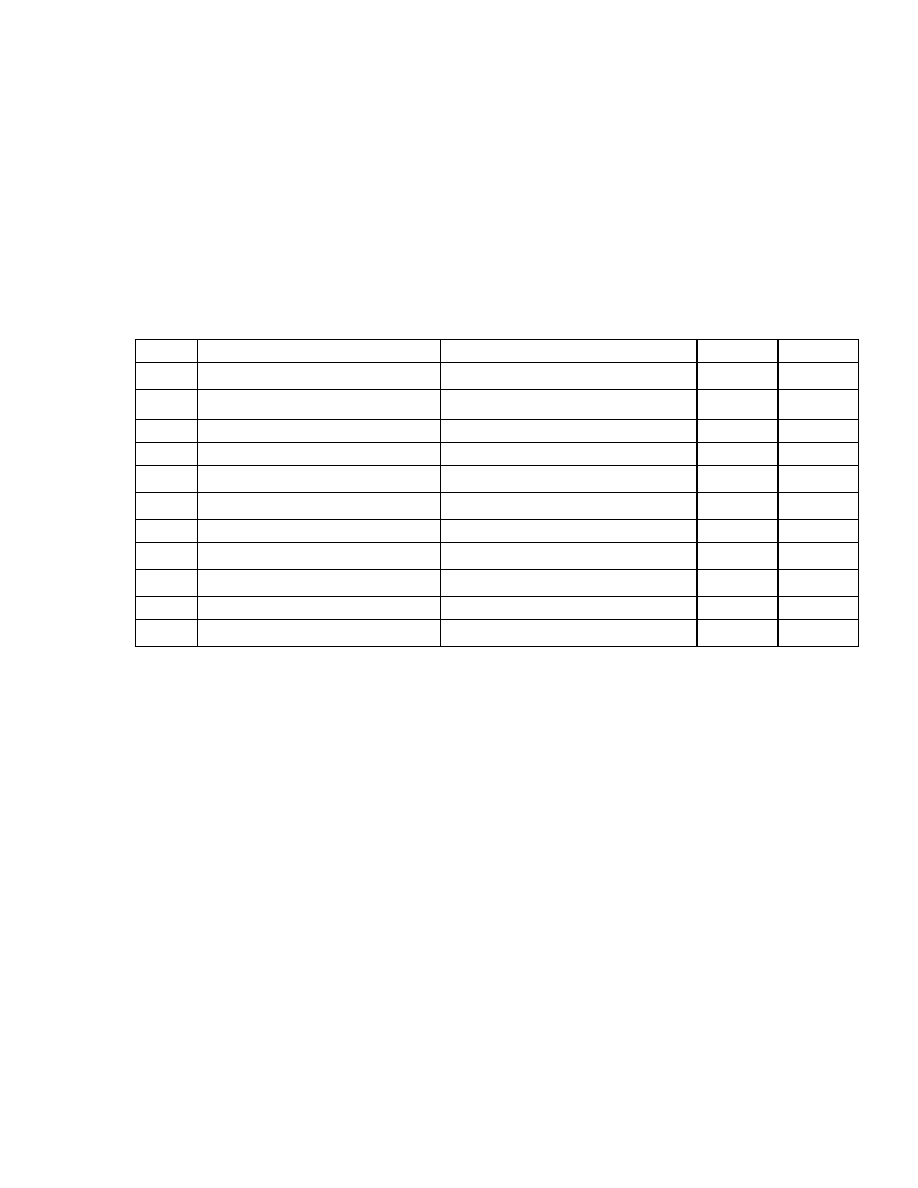
BRĀHMĪ GH
§
TA
(AFI, Part-I, 6:32)
Definition:
Brāhmī gh
¨
ta is a semisolid preparation made with the ingredients in the Formulation
composition given below with Gh
¨
ta as the basic ingredient.
Formulation composition:
1.
Brāhmī svarasa (Brāhmī API)
Bacopa monnieri
Pl.
1.536 l
2.
Gh
¨
ta (Go Gh
¨
ta) API
Clarified butter from cow’s milk
768 g
3.
Śu
´°
h
ī
API
Zingiber officinale
Rz.
12 g
4.
Marica API
Piper nigrum
Fr.
12 g
5.
Pippalī API
Piper longum
Fr.
12 g
6.
Śyāmā (Triv
¨
t API)
Operculina turpethum
Rt.
12 g
7.
Triv
¨
t API
Operculina turpethum
Rt.
12 g
8.
Dantī API
Baliospermum montanum
Rt.
12 g
9.
Śa
¬
khapu
¾
pī API
Convolvulus pluricaulis
W. P.
12 g
10. N
¨
padruma (Āragvadha API)
Cassia fistula
Fr. Pulp
12 g
11. Saptalā API
Euphorbia dracunculoides
W. P.
12 g
12. K
¨
mihara (Vi
²
a
¬
ga API)
Embelia ribes
Fr.
12 g
Method of preparation:
Take all ingredients of pharmacopoeial quality.
Take fresh Brāhmī and wash thoroughly with water. Grind and filter with muslin cloth to
obtain Brāhmī svarasa.
Treat Gh
¨
ta to prepare Mūrchita Gh
¨
ta (Appendix 6.2.8.2.).
Take the other ingredients (Kalka dravya) numbered 3 to 12, wash, dry, powder and pass
through sieve number 85. Transfer the powdered ingredients to the wet grinder and grind
with sufficient quantity of water to prepare a homogeneous blend.
Take Mūrchita Gh
¨
ta in a stainless steel vessel and heat it mildly.
Add increments of Kalka. Stir thoroughly while adding Brāhmī svarasa in the specified
ratio.
Heat for 3 h with constant stirring maintaining the temperature between 500 and 900
during the first hour of heating. Stop heating and allow to stand overnight. Start the
heating next day and observe the boiling mixture for subsidence of froth (phena śānti)
and constantly check the kalka for formation of varti (madhyama pāka lak
¾
a
´
a).

Expose the varti to flame and confirm the absence of crackling sound indicating absence
of moisture. Stop heating when the kalka forms a varti and the froth subsides. Filter
while hot (about 800) through a muslin cloth and allow to cool.
Pack it in tightly closed glass containers to protect from light and moisture.
Description:
A low melting Gh
¨
ta, green in colour with soft, unctuous touch, pleasant odour and bitter
taste.
Identification:
Thin layer chromatography:
Extract 2 g of the
sample
with 20 ml of alcohol at about 400 for 3 h. Cool, separate the
alcohol layer, filter, concentrate to 5 ml and carry out the thin layer chromatography.
Apply 10 µl of the extract on TLC plate and develop the plate to a distance of 8 cm using
toluene : ethyl acetate : hexane (6 : 3 : 1) as mobile phase. After development, allow the
plate to dry in air and spray with ethanol-sulphuric acid reagent followed by heating at
1100 for about 10 min. It shows major spots at Rf 0.15 (both grey), 0.28, 0.40 and 0.51
(all light grey) under visible light.
Physico-chemical parameters:
Refractive index at 400:
1.454 to1.465,
Appendix 3.1.
Weight per ml at 400:
0.930g to 0.945g,
Appendix 3.2.
Saponification value:
190 to 230,
Appendix
3.10.
Iodine value:
30 to 40,
Appendix
3.11.
Acid value:
Not more than 2,
Appendix 3.12
Peroxide value:
Not more than 4,
Appendix
3.13.
Congealing point:
210 to 170,
Appendix
3.4.2.
Other requirements:
Mineral oil:
Absent,
Appendix
3.15.
Microbial Limits:
Appendix 2.4.
Aflatoxins:
Appendix 2.7.

Storage: Store in a cool place in tightly closed containers, protected from light and moisture.
Therapeutic uses: Apasmāra (Epilepsy); Unmāda (Insanity); Vandhyatva (infertility);
Ku
¾°
ha (skin disorders); Vāksvara bha
¬
ga (inability to speak properly); Sm
¨
ti k
¾
aya
(memory loss) and Buddhi māndya (mental retardation).
Dose: 12 to 24 g daily in divided doses.
Anupāna: Warm milk and warm water.

DAŚAMŪLA GH
§
TA
(AFI, Part-I, 6:16)
Definition:
Daśamūla Gh
¨
ta is a medicated preparation made with the ingredients in the Formulation
composition given below with Gh
¨
ta as the basic ingredient.
Formulation composition:
1.
Bilva API
Aegle marmelos
St.Bk.
307.6 g
2.
Ś
yonāka API
Oroxylum indicum.
St.Bk.
307.6 g
3.
Gambhārī API
Gmelina arborea
St.Bk.
307.6 g
4.
Pā
°
alā API
Stereospermum suaveolens
St.Bk.
307.6 g
5.
Agnimantha API
Premna integrifolia
(Official substitute)
St.Bk.
307.6 g
6.
Ś
ālapar
´
ī API
Desmodium gangeticum
Pl.
307.6 g
7.
P
¨
śnipar
´ī
API
Uraria picta
Pl.
307.6 g
8.
B
¨
hatī API
Solanum indicum
Pl.
307.6 g
9.
Ka
´°
akārī API
Solanum xanthocarpum
Pl.
307.6 g
10.
Gok
¾
ura API
Tribulus terrestris
Fr.
307.6 g
11.
Jala API for decoction
Water
12.29 l
Reduced to
3.07 l
12.
Gh
¨
ta (Gogh¨ta API)
Clarified butter from cow’s milk
768 g
13.
Pu
¾
karāhvā (Pu
¾
kara API)
Inula racemosa
Rt.
12 g
14.
Śa
°
ī (Śa
°
i API)
Hedychium spicatum
Rz.
12 g
15.
Bilva API
Aegle marmelos
St.Bk.
12 g
16.
Surasā (Tulasī API)
Ocimum sanctum
Pl.
12 g
17.
Śu
´°
hī API
Zingiber officinale
Rz.
12 g
18.
Marica API
Piper nigrum
Fr.
12 g
19.
Pippalī API
Piper longum
Fr.
12 g
20.
Hi¬gu API - Śuddha
Ferula foetida
Exd.
12 g
Method of preparation:
Take all ingredients of pharmacopoeial quality.
Clean and dry all the herbal raw materials thoroughly before pulverization.
Treat Gh
¨
ta to prepare Mūrchita Gh
¨
ta (Appendix 6.2.8.2).
Pulverize ingredients numbered 1 to 10 (Kvātha dravya), to coarse powder, add 4 parts of
water, keep for four hours, heat and reduce the volume to one-fourth. Filter with muslin
cloth to obtain Daśamūla kvātha.

Note: Stem bark of the ingredients number 1 to 5 & 15 of the formulation composition
has been used.
Treat Hi
¬
gu to prepare Śodhita Hi
¬
gu (Appendix 6.2.7.12.) and keep aside for addition
during snehapāka.
Take the other ingredients (kalka dravya) numbered 13 to 19 in the formulation
composition, with the exception of Tulasī, clean, dry, powder and pass through sieve
number 85. Grind Tulasī in a wet grinder.
Transfer all the Kalka Dravyās (number 13 to 20) to the wet grinder and grind with
sufficient quantity of water to prepare a homogeneous blend (Kalka).
Take Mūrchita Gh
¨
ta in a stainless steel vessel and heat mildly.
Add increments of Kalka. Stir thoroughly while adding Daśamūla kvātha.
Heat for 3 h with constant stirring maintaining the temperature between 50 and 900
during the first hour of heating. Stop heating and allow to stand overnight. Start heating
next day and observe the boiling mixture for subsidence of froth (phena śānti) and
constantly check the kalka for formation of varti (madhyama pāka lak
¾
ana).
Expose the varti to flame and confirm the absence of crackling sound indicating absence
of moisture. Stop heating when the kalka forms a varti and the froth subsides. Filter
while hot (about 800) through a muslin cloth and allow to cool.
Pack it in tightly closed glass containers to protect from light and moisture.
Description:
A low melting Gh
¨
ta, yellowish green in color with pleasant odour and bitter taste.
Identification:
Thin layer chromatography:
Extract 2 g of
the sample
with 20 ml of alcohol at about 400 for 3 h. Cool, separate the
alcohol layer, filter, concentrate to 5 ml and carry out the thin layer chromatography.
Apply 10 µl of the extract on TLC plate and develop the plate to a distance of 8 cm using
toluene: ethyl acetate: hexane (6 : 3 : 1) as mobile phase. After development, allow the
plate to dry in air and spray with ethanol-sulphuric acid reagent followed by heating at
1100 for about 10 min. It shows spots at Rf 0.11 (light grey), 0.38 (light grey), 0.50
(grey), 0.63 (grey), 0.70 (light grey), 0.78 (light grey) and 0.90 (light grey) under visible
light.
Physico-chemical parameters:
Refractive index at 400:
1.450 to 1.453,
Appendix 3.1.
Weight per ml at 400:
0.910 g to 0.940 g,
Appendix 3.2.

Saponification value:
180 to 210,
Appendix
3.10.
Iodine value:
120 to 150,
Appendix
3.11.
Acid value:
Not more than 3,
Appendix
3.12.
Peroxide value:
Not more than 6,
Appendix
3.13.
Congealing point:
220 to 170
Appendix
3.4.2.

Other requirements:
Mineral oil:
Absent,
Appendix
3.15.
Microbial Limits:
Appendix 2.4.
Aflotoxins:
Appendix 2.7.
Storage: Pack it in tightly closed containers to protect from light and moisture.
Therapeutic uses: Vātaja kāsa (cough due to Vāta do
¾
a); Kaphaja kāsa (cough due to
Kapha do
¾
a); Vātakapha roga (diseases due to Vāta Kapha do
¾
a); S
ū
tikā roga (Puerperal
disorders) and Hasta pāda dāha (burning sensation in palms & soles).
Dose: 12 g daily in divided doses.
Anupāna: Warm water, warm milk.

DAŚAMŪLA
½
A
¯
PALAKA GH
§
TA
(AFI, Part-I, 6:17)
Definition:
Daśamūla¾a°palaka Gh¨ta is a medicated preparation made with the ingredients in the
Formulation composition given below with Gh
¨
ta as the basic ingredient.
Formulation composition:
1.
Bilva API
Aegle marmelos
St.Bk.
240 g
2.
Śyonāka API
Oroxylum indicum
St.Bk.
240 g
3.
Gambhārī API
Gmelina arborea
St.Bk.
240 g
4.
Pā
°
alā API
Stereospermum suaveolens
St.Bk.
240 g
5.
Agnimantha API
Premna integrifolia
St.Bk.
240 g
6.
Śālapar
´
ī API
Desmodium gangeticum
Pl.
240 g
7.
P
¨
śnipar
´ī
API
Uraria picta
Pl.
240 g
8.
B
¨
hatī API
Solanum indicum
Pl.
240 g
9.
Ka
´°
akārī API
Solanum xanthocarpum
Pl.
240 g
10.
Gok
¾
ura API
Tribulus terrestris
Pl
240 g
11.
Jala API for decoction
Water
12.29 l
Reduced to
3.07 l
12.
K
¾
ī
ra (Godugdha API)
Cow’s milk
3.072 l
13.
Pippalī API
Piper longum
Fr.
21.33 g
14.
Pippalī mūla API
Piper longum
Rt.
21.33 g
15.
Cavya API
Piper chaba
Rt.
21.33 g
16.
Citraka API
Plumbago zeylanica
Rt.
21.33 g
17.
Śu
´°
hī API
Zingiber officinale
Rz.
21.33 g
18.
K
¾
āra (Yava API)
Hordeum vulgare
Ash of Pl.
21.33 g
19.
Sarpi (Gogh
¨
ta API)
Clarified butter from cow’s milk
768 g
Method of preparation:
Take all ingredients of pharmacopoeial quality.
Wash and dry the raw materials thoroughly before pulverization.
Treat Gh
¨
ta to prepare Mūrchita Gh
¨
ta (Appendix 6.2.8.2.).

Note: Stem bark of the ingredients number 1 to 5 of the formulation composition has
been used in place of root.

Pulverize Daśamūla ingredients 1 to 10. (Kvātha dravya) to coarse powder, add specified
quantity of water, keep for four hours, heat and reduce the volume to one fourth. Filter
with muslin cloth to obtain Daśamūla kvātha.
Take the other ingredients (kalka dravya) numbered 13 to 18 of the formulation
composition, powder and pass through sieve number 85. Transfer the powdered
ingredients to wet grinder and grind with sufficient quantity of water to prepare a
homogeneous blend (Kalka)
Take Mūrchita Gh
¨
ta in a stainless steel vessel and heat mildly.
Add increments of Kalka. Stir thoroughly while adding Daśamūla kvātha and Godugdha.
Heat for 3 h with constant stirring maintaining the temperature between 50 and 900
during the first hour of heating. Stop heating and allow to stand overnight.
Start heating next day and observe the boiling mixture for subsidence of froth (phena
śānti) and constantly check the kalka for formation of varti (madhyama pāka lak
¾
a
´
a).
Expose the varti to flame and confirm the absence of crackling sound indicating absence
of moisture. Stop heating when the kalka forms a varti and the froth subsides. Filter
while hot (about 800) through a muslin cloth and allow to cool.
Pack it in tightly closed glass containers to protect from light and moisture.
Description:
A low melting Gh
¨
ta, yellowish green in color with pleasant odour and bitter and
astringent taste.
Identification:
Thin layer chromatography:
Extract 2 g of the
sample
with 20 ml of alcohol at about 400 for 3 h. Cool, separate the
alcohol layer, filter and concentrate to 5 ml and carry out the thin layer chromatography.
Apply 10 µl of the extract on TLC plate and develop the plate to a distance of 8 cm using
toluene: ethyl acetate: hexane (6 : 3 : 1) as mobile phase. After development, allow the
plate to dry in air and spray with ethanol-sulphuric acid reagent followed by heating at
1100 for about 10 min. It shows spots at Rf 0.12 (grey), 0.19 (grey), 0.35 (grey), 0.71
(light brown), 0.8 (brown) and 0.92 (brown) under visible light.
Physico-chemical parameters:
Refractive index at 400:
1.448 to 1.530,
Appendix 3.1.
Weight per ml at 400:
0.910 g to 0.940g,
Appendix 3.2.
Saponification value:
180 to 210,
Appendix
3.10.
Iodine value:
30 to 47,
Appendix
3.11.

Acid value:
Not more than 3,
Appendix
3.12.
Peroxide value:
Not more than 6,
Appendix
3.13.
Congealing point:
220 to 170,
Appendix
3.4.2.

Other requirements:
Mineral oil:
Absent,
Appendix
3.15.
Microbial Limits:
Appendix 2.4.
Aflatoxins:
Appendix 2.7.
Storage: Pack it in tightly closed containers to protect from light and moisture.
Therapeutic uses: Agnimāndya (loss of appetite); Pā
´²
u (anaemia); Kāsa (cough);
Ajīr
´
a (indigestion); Jvara (Fever) and Plīhāroga (Spleen disease).
Dose: 12 g daily in divided doses.
Anupāna: Warm milk and warm water.

DHĀTRYĀDI GH
§
TA
(AFI, Part-I, 6:21)
Definition:
Dhātryādi Gh
¨
ta is a medicated preparation made with the ingredients in the Formulation
composition given below with Gh
¨
ta as the basic ingredient.
Formulation composition:
1.
Dhatrī rasa (Āmalakī API)
Phyllanthus emblica (Emblica
officinalis)
P.
768 ml
2.
Vidārī rasa (Vidārī API)
Pueraria tuberosa
Rt.Tr.
768 ml
3.
Ik
¾
u rasa (Ik
¾
u API )
Saccharum officinarum
St.(Juice)
768 ml
4.
Śatāvarī rasa (Śatāvarī API)
Asparagus racemosus
Rt.
768 ml
5.
Kū
¾
mā
´²
aka rasa (Kū
¾
ma
´²
a API)
Benincasia hispida
Fr.P.
768 ml
6.
Sarpi (Gogh
¨
ta API)
Clarified butter from cow’s milk
768 ml
7.
K
¾
īra (Godugdha API )
Cow’s milk
768 ml
8.
M
¨
dvīkā (Drāk
¾
ā API)
Vitis vinifera
Dr.Fr.
24 g
9.
Ya
¾°
yāhvā (Ya
¾°
ī
API)
Glycyrrhiza glabra
Rt.
24 g
10 Candana (
Ś
veta candana API)
Santalum album
Ht.Wd.
24 g
11 Sitā API
Sugar candy
24 g
Method of preparation:
Take all ingredients of pharmacopoeial quality.
Treat Gh
¨
ta to prepare Mūrchita Gh
¨
ta (Appendix 6.2.8.2)
Obtain ingredients numbered 1 to 5 in fresh form, wash thoroughly, grind and express
svarasa through muslin cloth.
Take the other ingredients (Kalka dravya) numbered 9 and 10, clean, dry, powder and
pass through sieve number 85. Transfer the powdered ingredients to the wet grinder, add
cleaned M
¨
dvīkā and grind with sufficient quantity of water to prepare a homogeneous
blend.
Take Mūrchita Gh
¨
ta in a stainless steel vessel and heat it mildly.
Add increments of Kalka. Stir thoroughly while adding Svarasa and Godugdha.
Heat for 3 h with constant stirring maintaining the temperature between 500 and 900
during the first hour of heating. Stop heating and allow to stand overnight.
Start the heating next day and observe the boiling mixture for subsidence of froth (phena
śānti) and constantly check the kalka for formation of varti (madhyama pāka lak
¾
a
´
a).
Expose the varti to flame and confirm the absence of crackling sound indicating absence of moisture. Stop
heating when the kalka forms a varti and the froth subsides. Filter while hot (about 800) through a muslin
cloth and allow to cool. After complete cooling add powdered sugar, stir vigorously for dissolution.

Pack it in tightly closed glass containers to protect from light and moisture.
Description:
Medicated Gh
¨
ta, greenish yellow in color with pleasant odour and sweet taste.
Identification:
Thin layer chromatography:
Extract 2 g of the
sample
with 20 ml of alcohol at about 400 for 3 h. Cool, separate the
alcohol layer, filter, concentrate to 5 ml and carry out the thin layer chromatography.
Apply 10 µl of the extract on TLC plate and develop the plate to a distance of 8 cm using
toluene: ethyl acetate: hexane (6 : 3 : 1) as mobile phase. After development, allow the
plate to dry in air and spray with ethanol-sulphuric acid reagent followed by heating at
1100 for about 10 min. It shows spots at Rf 0.39 (light grey), 0.62 (light grey), 0.68 (light
grey), 0.79 (light grey) and 0.88 (light grey) under visible light.
Physico-chemical parameters:
Refractive index at 400:
1.465 to 1.466,
Appendix 3.1.
Weight per ml at 400:
0.910 g to 0.920 g,
Appendix 3.2.
Saponification value:
175 to 205,
Appendix
3.10.
Iodine value:
35 to 45,
Appendix
3.11.
Acid value:
Not more than 2,
Appendix
3.12.
Peroxide value:
Not more than 2,
Appendix
3.13.
Congealing point:
210 to 170,
Appendix
3.4.2.
Other requirements:
Mineral oil:
Absent,
Appendix
3.15.
Microbial Limits:
Appendix
2.4.
Aflatoxins:
Appendix
2.7.
Storage: Store in a cool place in tightly closed containers, protected from light and
moisture.

Therapeutic uses: Pittaja gulma (lump due to pitta do
¾
a); Pittaja pā
´²
u (Anemia due
to pitta do
¾
a); Mada (intoxication); Mūrchā (Syncope); Madātyaya (alcoholism); Unmāda
(Insanity); Raktapitta (Bleeding disorders); As
¨
gdara (excessive bledding from vaginal
tract); Vandhyatva (Infertility); Vātarakta (Gout); pittavikāra (disorders of Pitta do
¾
a) and
Asthisrāva (discharge from bone).
Dose: 12 g daily in divided doses.
Anupāna: Mixed with equal quantity of sugar and administer with warm milk and warm
water.

JĀTYĀDI GH
§
TA
(Syn. Vra
´
a Śodhanādi Gh
¨
ta)
(AFI, Part-I, 6:11)
Definition:
Jātyādi Gh
¨
ta is a medicated preparation made with the ingredients in the Formulation
composition given below with Gh
¨
ta as the basic ingredient.
Formulation composition:
1.
Jātī patra (Jātī API)
Jasminum officinale
var.grandiflorum
Lf.
14.76 g
2.
Nimba-patra API
Azadirachta indica
Lf.
14.76 g
3.
Pa
°
ola-patra API
Trichosanthes dioica
Lf.
14.76 g
4.
Ka
°
uka API
Picrorhiza kurroa
Rz.
14.76 g
5.
Dārvī (Dāruharidrā API)
Berberis aristata
St.
14.76 g
6.
Niśā (Haridrā API)
Curcuma longa
Rz.
14.76 g
7.
Sārivā (Śveta sārivā API)
Hemidesmus indicus
Rt.
14.76 g
8.
Ma®ji
¾°
ā API
Rubia cordifolia
Rt.
14.76 g
9.
Abhaya (Uśīra API)
Vetiveria zizanioides
Rt.
14.76 g
10.
Siktha (Madhūcchi
¾°
a API)
Bee’s wax
14.76 g
11.
Tuttha API
Copper sulphate
14.76 g
12.
Madhuka (Ya
¾°
ī API)
Glycyrrhiza glabra
Rt.
14.76 g
13.
Naktāhvā (Kara
®
ja API)
Pongamia pinnata
Sd.
14.76 g
14.
Sarpi (Gogh
¨
ta API)
Clarified butter from cow’s milk
768 g
15.
Jala API
Water
3.07 l
Method of preparation:
Take all ingredients of pharmacopoeial quality.
Treat Gh
¨
ta to prepare Mūrchita Gh
¨
ta (Appendix 6.2.8.2)
Wash and grind fresh leaves of ingredients 1 to 3 of the formulation composition (Kalka
dravya) in a wet grinder. Treat Tuttha to prepare Śodhitha Tuttha (Appendix 6.2.7.6.) and
keep aside for addition during snehapāka.
Take the ingredients (Kalka dravya) 4 to 9 and 12 to 13, clean, dry, powder and pass
through sieve number 85 seperately. Transfer the powdered ingredients to the wet grinder,
add the paste of ingredients number 1 to 3 and 11, ingredient grind with sufficient
quantity of water to prepare a homogeneous blend. (Kalka)
Take Mūrchita Gh
¨
ta in a stainless steel vessel and heat it mildly.
Add increments of Kalka. Stir thoroughly while adding water in the ratio of 1 : 4.

Heat for 3 h with constant stirring maintaining the temperature between 500 and 900
during the first hour of heating. Stop heating and allow to stand overnight.
Start heating next day, observe the boiling mixture for subsidence of froth and constantly
check the Kalka for the sign of varti breaking down into pieces on attempting to form a
varti (khara pāka lak
¾
a
´
a). Expose the varti to flame and confirm the absence of
crackling sound indicating absence of moisture. Stop heating when the kalka breaks down
into pieces on attempting to form a varti and the froth subsides. Filter while hot (about
800) through a muslin cloth. Add small pieces of Siktha, filter through muslin cloth and
allow to cool.
Pack it in tightly closed glass containers to protect from light and moisture.
Description:
A low melting Gh
¨
ta, yellowish green in color, unctuous to touch with pleasant odour.
Identification:
Thin layer chromatography:
Extract 2 g of Jātyādi Gh¨ta with 20 ml of alcohol at about 400 for 3 h. Cool, separate the
alcohol layer, filter, concentrate to 5 ml and carry out thin layer chromatography. Apply
10 µl of the extract on TLC plate and develop the plate to distance of 8 cm using toluene :
ethyl acetate : hexane (6 : 3 : 1) as mobile phase. After development, allow the plate to
dry in air and spray with ethanol-sulphuric acid reagent followed by heating at 1100 for
about 10 min. It shows spots at Rf
0.12
(
light grey
),
0.29
(
grey
),
0.5
(
dark brown
),
0.59
(
brown
),
0.69
(
brown
) and
0.85
(
light grey
).
Physico-chemical parameters:
Refractive index at 400:
1.452 to 1.464,
Appendix 3.1.
Weight per ml at 400:
0.910g to 0.935g,
Appendix 3.2.
Saponification value:
190 to 210,
Appendix
3.10.
Iodine value:
35 to 45,
Appendix
3.11.
Acid value:
Not more than 3,
Appendix
3.12.
Peroxide value:
Not more than 5,
Appendix
3.13.
Congealing point:
210 to 170,
Appendix
3.4.2.
Other requirements:

Mineral oil:
Absent,
Appendix
3.15.
Microbial Limits:
Appendix 2.4.
Aflatoxins:
Appendix 2.7.
Storage: Store in a cool place in tightly closed containers, protected from light and moisture.
Therapeutic uses: For local application in Marmāś
¨
ta vra
´
a (Ulcers in vital points);
Kledī vra
´
a (Oozing / weeping ulcer); Gambhīra vra
´
a (deep-rooted ulcers); Saruja vra
´
a
(painful ulcers), Raktaja vra
´
a (bleeding ulcers); Du
¾°
a vra
´
a (non-healing ulcers).
Dose: For application on various types of wounds and ulcers.

KALYĀ
³
AKA GH
§
TA
(AFI, Part-I, 6:7)
Definition:
Kalyā
´
aka Gh
¨
ta is a medicated preparation made with the ingredients in the Formulation
composition given below with Gh
¨
ta as the basic ingredient.
Formulation composition:
1.
Harītakī API
Terminalia chebula
P.
12 g
2.
Bibhītaka API
Terminalia bellirica
P.
12 g
3.
Āmalakī API
Phyllanthus emblica
(Emblica officinalis)
P.
12 g
4.
Viśāla API
Citrullus colocynthis
(Official substitute)
Fr.
12 g
5.
Bhadrailā (Sthūlailā API )
Amomum subulatum
Sd.
12 g
6.
Devadāru API
Cedrus deodara
Ht.Wd
12 g
7.
Elāvāluka API
Prunus avium
St.Bk
12 g
8.
Śveta sārivā API
Hemidesmus indicus
Rt.
12 g
9.
K
¨¾´
a sārivā API
Cryptolepis buchanani
Rt.
12 g
10. Haridrā API
Curcuma longa
Rz.
12 g
11. D
¢
ru haridrā API
Berberis aristata
St.
12 g
12. Śālapar
´
ī API
Desmodium gangeticum
Rt.
12 g
13.
P
¨
śnipar
´
ī API
Uraria picta
Rt.
12 g
14. Phalinī (Priya
¬
gu API )
Callicarpa macrophylla
Infl.
12 g
15. Nata (Tagara API)
Valeriana wallichii
Rt
12 g
16. B
¨
hatī API
Solanum indicum
Pl.
12 g
17. Ku
¾°
ha API
Saussurea lappa
Rt
12 g
18. Ma
®
ji
¾°
ā API
Rubia cordifolia
St
12 g
19. Nāgakeśara API
Mesua ferrea
Stmn.
12 g
20.
Dā
²
ima-Phala tvak API
Punica granatum
P.
12 g
21. Vella (Vi
²
a¬ga API)
Embelia ribes
Fr.
12 g
22. Tālīsā patra (Tālīsā API)
Abies webbiana
Lf.
12 g
23. Elā (Sūk
¾
mailā API)
Elettaria cardamomum
Sd.
12 g
24. Mālatī Mukula (Jātī API)
Jasminum officinale
var.grandiflorum
Fl.
12 g
25. Utpala API
Nymphaea stellata
Fl.
12 g
26. Da
¬
tī API
Baliospermum montanum
Rt
12 g
27. Padmaka API
Prunus cerasoides
Ht. Wd
12 g
28. Hima (Rakta candana API)
Pterocarpus santalinus
Ht. Wd
12 g

29. Sarpi (Gogh
¨
ta API)
Clarified butter from cow’s milk
768 g

Method of preparation:
Take all ingredients of pharmacopoeial quality.
Wash and dry all the herbal raw material thoroughly.
Treat Gh
¨
ta to prepare Mūrchita Gh
¨
ta (Appendix 6.2.8.2).
Take the ingredients (kalka dravya) numbered 1 to 28 in the formulation composition,
clean, wash, dry, powder separately and pass through sieve number 85.
Transfer the powdered ingredients to wet grinder and grind with sufficient quantity of
water to prepare a homogeneous blend (Kalka).
Take Mūrchita Gh
¨
ta in a stainless steel vessel and heat it mildly.
Add increments of Kalka. Stir thoroughly while adding water in the ratio of 1 : 4.
Heat for 3 h with constant stirring maintaining the temperature between 500 and 900
during the first hour of heating. Stop heating and allow to stand overnight.
Start heating on next day and observe the boiling mixture for subsidence of froth (phena
śānti) and constantly check the Kalka for formation of varti (madhyama pāka lak
¾
a
´
a).
Expose the varti to flame and confirm the absence of crackling sound indicating absence
of moisture. Stop heating when the kalka form in to a varti and the froth subsides. Filter
while hot (about 800) through a muslin cloth and allow to cool.
Pack it in tightly closed glass containers to protect from light and moisture.
Description:
A low melting Gh
¨
ta, yellowish green in color with pleasant odour and bitter taste.
Identification:
Thin layer chromatography:
Extract 2 g of Kalyā
´
aka Gh
¨
ta with 20 ml of alcohol at about 400 for 3 h. Cool, separate
the alcohol layer, filter, concentrate to 5 ml and carry out thin layer chromatography.
Apply 10 µl of the extract on TLC plate and develop the plate to a distance of 8 cm
using toluene : ethyl acetate : hexane (6 : 3 : 1) as mobile phase. After development,
allow the plate to dry in air and spray with ethanol-sulphuric acid reagent followed by
heating at 1100 for about 10 min. It shows spots at Rf
0.12
(grey), 0.
25
(light grey), 0.
35
(light grey), 0.
54
(light grey), 0.76 (brownish grey) and 0.92 (brown) under visible light.
Physico-chemical parameters:
Refractive index at 400:
1.450 to 1.461,
Appendix 3.1.
Weight per ml at 400:
0.920g to 0.940g,
Appendix 3.2.
Saponification value:
180 to 210,
Appendix
3.10.

Iodine value:
33 to 45,
Appendix
3.11.
Acid value:
Not more than 4.5,
Appendix
3.12.
Peroxide value:
Not more than 6,
Appendix
3.13.
Congealing point:
220 to 170,
Appendix
3.4.2.

Other requirements:
Mineral oil:
Absent,
Appendix
3.15.
Microbial Limits:
Absent,
Appendix 2.4.
Aflatoxins:
Absent,
Appendix 2.7.
Storage: Pack it in tightly closed containers to protect from light and moisture.
Therapeutic uses: Kāsa (cough); Pā
´²
u (Anemia); Apasmāra (Epilepsy); Bhūtonmāda
(exogenous psychosis); Bālagraha (specific disorders of children); Vi
¾
avik
¢
ra (disorders
due to poison); Gara vi
¾
a (slow/accumulated poison); Vandhyatva (Infertility); Yoni roga
(diseases of the female genital tract); Ka
´²
u (itching); Śopha (Oedema); Meda (Adipose
tissue); Moha (Delusion); Jvara (fever); Sm
¨
ti daurbalya (weak memory) and Daurbalya
(weakness).
Dose: 12 g daily in divided doses.
Anupāna: Warm milk, Warm water.

PAÑCAGAVYA GH
§
TA
(AFI, Part-I, 6:25)
Definition:
Pañcagavya Gh
¨
ta is a semi-solid preparation made with the ingredients in the
Formulation composition given below with Gh
¨
ta as the basic ingredient.
Formulation composition:
1.
Gomaya svarasa
Water extract of fresh cow dung
3.07 l
2.
K
¾
īra (Godugdha API)
Cow’s milk
3.07 l
3.
Dadhi (Godadhi API)
Curd from cow’s milk
3.07 kg
4.
Mūtra (Gomūtra)
Urine of cow
3.07 l
5. Havi (Gogh
¨
ta API)
Clarified butter from cow’s milk
768 g
Method of preparation:
Take all ingredients of pharmacopoeial quality.
Collect fresh cow dung and cow urine in clean seperate vessels taking care to avoid
contamination. Use urine within 12 h of collection. Use cow dung with in 2 h to prepare
(Gomaya svarasa)
Mix Cow dung with equal quantity of water using gloved hands and make a
homogeneous solution. Filter later with muslin cloth to obtain Gomaya svarasa.
Treat Gh
¨
ta to prepare Mūrchita Gh
¨
ta (Appendix 6.2.8.2).
Take Mūrchita Gh
¨
ta in a stainless steel vessel and heat it mildly.
Stir thoroughly while adding the Godadhi, Godugdha, Gomūtra and Gomaya svarasa.
Heat for 3 h with constant stirring maintaining the temperature between 500 and 900
during the first hour of heating. Stop heating and allow to stand overnight.
Start heating next day and observe the boiling mixture for subsidence of froth (phena
śānti). Stop heating when the froth subsides. Filter while hot (about 800) through a
muslin cloth and allow to cool.
Pack it in tightly closed glass containers to protect from light and moisture.
Description:
A low melting Gh
¨
ta, light yellow in color with phenolic odour.
Identification:
Thin layer chromatography:

Extract 2 g of the
sample
with 20 ml of alcohol at about 400 for 3 h. Cool, separate the
alcohol layer, filter, concentrate to 5 ml and carry out the thin layer chromatography.
Apply 10 µl of the extract on TLC plate and develop the plate to a distance of 8 cm using
toluene: ethyl acetate: hexane (6 : 3 : 1) as mobile phase. After development, allow the
plate to dry in air and spray with ethanol-sulphuric acid reagent followed by heating at
1100 for about 10 min. It shows spots at Rf 0.15 (light grey), 0.22 (brownish grey), 0.30
(light grey), 0.50 (light grey), 0.63 (brownish grey), 0.70 (grey) and 0.82 (brownish grey)
under visible light.
Physico-chemical parameters:
Refractive index at 400:
1.450 to 1.455,
Appendix 3.1.
Weight per ml at 400:
0.915 g to 0.950 g,
Appendix 3.2.
Saponification value:
200 to 225,
Appendix
3.10.
Iodine value:
35 to 45,
Appendix
3.11.
Acid value:
Not more than 3,
Appendix
3.12.
Peroxide value:
Not more than 2,
Appendix
3.13.
Congealing point:
210 to 170,
Appendix
3.4.2.
Other requirements:
Mineral oil:
Absent,
Appendix
3.15.
Microbial Limits:
Appendix
2.4.
Aflatoxins:
Appendix
2.7.
Storage: Store in a cool place in tightly closed containers, protected from light and
moisture.
Therapeutic uses: Apasmāra (Epilepsy); Jvara (fever); Unmāda (Insanity) and Kāmalā
(Jaundice).
Dose: 12 g daily in divided dose.
Anupāna: Warm milk, Warm water.

PA
¿
CATIKTA GH
§
TA
(AFI, Part-I, 6:26)
Definition:
Pa®catikta Gh
¨
ta is a medicated preparation made with the ingredients in the Formulation
composition given below with Gh
¨
ta as the basic ingredient.
Formulation composition:
1.
Nimba API
Azadirachta indica
St.Bk.
480 g
2.
Pa
°
ola API
Trichosanthes dioica
Lf.
480 g
3.
Vyāghrī (Ka
´°
akārī API)
Solanum surattense
Pl.
480 g
4.
Gu
²
ūcī API
Tinospora cordifolia
St.
480 g
5.
Vāsaka (Vāsā API)
Adhatoda vasica
Rt.
480 g
6.
Jala API for decoction
Water
12.29 l
reduced to
3.07 l
7.
Harītakī API
Terminalia chebula
P.
128 g
8.
Bibhītaka API
Terminalia bellirica
P.
128 g
9.
Āmalakī API
Phyllanthus emblica
(Emblica officinalis)
P.
128 g
10.
Gh
¨
ta (Gogh
¨
ta API)
Clarified butter from cow’s milk
768 g
Method of preparation:
Take all ingredients of pharmacopoeial quality.
Wash and dry all the herbal raw materials thoroughly.
Treat Gh
¨
ta to prepare Mūrchita Gh
¨
ta (Appendix 6.2.8.2).
Pulverize ingredients numbered 1 to 5 (kvātha dravya) to coarse powder, add specified
quantity of water, heat and reduce the volume to one-fourth. Filter with muslin cloth to
obtain Pa
®
catikta kvātha.
Take the other ingredients (kalka dravya) numbered 7 to 9 in the formulation composition, Powder and pass
through sieve number 85. Transfer the powdered ingredients to wet grinder and grind with sufficient
quantity of water to prepare a homogeneous blend (Kalka)
Take Mūrchita Gh
¨
ta in a stainless steel vessel and heat mildly.
Add increments of Kalka. Stir thoroughly while adding kvātha.
Heat for 3 h with constant stirring maintaining the temperature between 500 and 900
during the first hour of heating. Stop heating and allow to stand overnight.
Start heating next day and observe the boiling mixture for subsidence of froth (phena
śānti) and constantly check the kalka for formation of varti (madhyama pāka lak
¾
a
´
a).
Expose the varti to flame and confirm the absence of crackling sound indicating absence
of moisture. Stop heating when the kalka forms a varti and the froth subsides. Filter
while hot (about 800) through a muslin cloth and allow to cool.

Pack it in tightly closed glass containers to protect from light and moisture.
Description:
A low melting Gh
¨
ta, greenish yellow color with pleasant odour and bitter taste.
Identification:
Thin layer chromatography:
Extract 2 g of the
sample
with 20 ml of alcohol at about 400 for 3 h. Cool, separate the
alcohol layer, filter concentrate to 5 ml and carry out the thin layer chromatography.
Apply 10 µl of the extract on TLC plate and develop the plate to a distance of 8 cm using
toluene: ethyl acetate: hexane (6: 3: 1) as mobile phase. After development, allow the
plate to dry in air and spray with ethanol-sulphuric acid reagent followed by heating at
1100 for about 10 min. It shows spots at Rf 0.13 (light grey), 0.20 (light grey), 0.28 (light
grey), 0.37 (light grey), 0.57 (light grey) and 0.89 (brown) under visible light.
Physico-chemical parameters:
Refractive index at 400:
1.450 to 1.452,
Appendix
3.1.
Weight per ml at 400:
0.910 g to 0.930 g,
Appendix
3.2.
Saponification value:
180 to 210,
Appendix
3.10.
Iodine value:
30 to 40,
Appendix
3.11.
Acid value:
Not more than 3,
Appendix
3.12.
Peroxide value:
Not more than 3,
Appendix
3.13.
Congealing point:
210 to 170
Appendix
3.4.2.
Other requirements:
Mineral oil:
Absent,
Appendix
3.15.
Microbial Limits:
Appendix 2.4.
Aflatoxins:
Appendix 2.7.
Storage: Pack it in tightly closed containers to protect from light and moisture.

Therapeutic uses: Du
¾
°
avra
´
a (non-healing ulcer); Ku
¾
°
ha (Leprosy/skin diseases);
Vātavyādhi (disorders due to vitiated Vāta do
¾
a); Pittavyādhi (diseases due to vitiated
Pitta do
¾
a); Kaphavikāra (disorders due to vitiated Kapha do
¾
a); K
¨
mi (worm
infestation); Arśa (Piles) and Kāsa (cough).
Dose: 12 g daily in divided doses.
Anupāna: Warm milk, Warm water.

PHALA GH
§
TA
(AFI, Part-I, 6:30)
Definition:
Phala Gh
¨
ta is a medicated preparation made with the ingredients in the Formulation
composition given below with Gh
¨
ta as the basic ingredient.
Formulation composition:
1.
Ma
®
ji
¾°h
ā API
Rubia cordifolia
Rt.
12 g
2.
Ku
¾°h
a API
Saussurea lappa
Rt.
12 g
3.
Tagara API
Valeriana wallichii
Rt.
12 g
4.
Harītakī API
Terminalia chebula
P.
12 g
5.
Bibhītaka API
Terminalia bellirica
P.
12 g
6.
Āmalakī API
Phyllanthus emblica
(Emblica officinalis)
P.
12 g
7.
Ś
arkarā API
Sugar
12 g
8.
Vacā API
Acorus calamus
Rz.
12 g
9.
Haridrā API
Curcuma longa
Rz.
12 g
10.
Dāru haridrā API
Berberis aristata
St.
12 g
11.
Madhuka (Ya
¾°
ī API)
Glycyrrhiza glabra
Rt.
12 g
12.
Medā API
Asparagus racemosus
(Official substitute)
Rt.Tr.
12 g
13.
Dīpyaka (Yavānī API)
Trachyspermum ammi
Fr.
12 g
14.
Ka
°
urohi
´
ī (Ka
°
ukā API)
Picrorhiza kurroa
Rz./ Rt.
12 g
15.
Payasyā (K
¾
īra vidārī API)
Ipomoea digitata
Rt.Tr.
12 g
16.
Hi¬gu API
Ferula foetida
Exd.
12 g
17.
Kākolī API
Withania somnifera
(Official substitute)
Rt.
12 g
18.
Vājīgandhā (Aśvagandhā API)
Withania somnifera
Rt.
12 g
19.
Śatāvarī API
Asparagus racemosus
Rt.Tr.
12 g
20.
Gh
¨
ta (Gogh
¨
ta API)
Clarified butter from cow’s milk
768 g
21.
K
¾
īra (Godugdha API)
Cow’s milk
3.072 l
Method of preparation:
Take all ingredients of pharmacopoeial quality.
Treat Gh
¨
ta to prepare Mūrchita Gh
¨
ta (Appendix 6.2.8.2).
Treat Hi
¬
gu to prepare śodhita Hi
¬
gu (Appendix 6.2.7.12.).
Take the ingredients (kalka dravya) numbered 1 to 19 except Hi¬gu and Śarkarā, wash, dry, powder and
pass through sieve number 85. Transfer the powdered ingredients to the wet grinder, add shodhita Hingu,
grind with sufficient quantity of water to prepare a homogeneous blend. (Kalka)

Take Mūrchita Gh
¨
ta in a stainless steel vessel and heat mildly.
Add increments of Kalka. Stir thoroughly while adding Godugdha.
Heat for 3 h with constant stirring maintaining the temperature between 500 and 900
during the first hour of heating. Stop heating and allow to stand overnight. Start heating
next day and observe the boiling mixture for subsidence of froth (phena śānti) and
constantly check the kalka for formation of varti (madhyama pāka lak
¾
a
´
a). Expose the
varti to flame and confirm the absence of crackling sound indicating absence of moisture.
Stop heating when the kalka forms a varti and the froth subsides. Filter while hot (about
800) through a muslin cloth and allow to cool. After complete cooling add powdered
sugar, stir vigorously for dissolution.
Pack it in tightly closed glass containers to protect from light and moisture.
Description:
A low melting Gh
¨
ta, greenish yellow in color with pleasant odour and astringent taste.
Identification:
Thin layer chromatography:
Extract 2 g of the
sample
with 20 ml of alcohol at about 400 for 3 h. Cool, separate the
alcohol layer, filter, concentrate to 5 ml and carry out the thin layer chromatography.
Apply 10 µl of the extract on TLC plate and develop the plate to a distance of 8 cm using
toluene : ethyl acetate : hexane (6 : 3 : 1) as mobile phase. After development, allow the
plate to dry in air and spray with ethanol-sulphuric acid reagent followed by heating at
1100 for about 10 min. It shows spots at Rf 0.094 (light grey), 0.19 (light grey), 0.25
(light grey), 0.28 (light grey), 0.53 (light grey), 0.80 (light grey) and 0.97 (brownish grey)
under visible light.
Physico-chemical parameters:
Refractive index at 400:
1.440 to 1.450,
Appendix 3.1.
Weight per ml at 400:
0.910g to 0.940g,
Appendix 3.2
Saponification value:
185 to 210,
Appendix
3.10.
Iodine value:
35 to 42,
Appendix
3.11.
Acid value:
Not more than 3,
Appendix
3.12.
Peroxide value:
Not more than 4,
Appendix
3.13.
Congealing point:
220 to 170
Appendix
3.4.2.

Other requirements:
Mineral oil:
Absent,
Appendix
3.15.
Microbial Limits:
Appendix 2.4.
Aflatoxins:
Appendix 2.7..
Storage: Store in a cool place in tightly closed containers, protected from light and
moisture.
Therapeutic uses:
Śukra vikāra (disorders of the Śukra dhāthu); Yoni vikāra
(disorders of female genital tract); Vandhyatva (Infertility); Garbhi
´
ī roga (diseases
during pregnancy) and Kārśya (Emaciation); Uttara Vasti (Vaginal Douche)
Dose: 12 g daily in divided doses.
Anupāna: Warm water.

SĀRASVATA GH
§
TA
(AFI, Part-I, 6:43)
Definition:
Sārasvata Gh
¨
ta is a medicated preparation made with the ingredients in the Formulation
composition given below with Gh
¨
ta as the basic ingredient.
Formulation composition:
1.
Ajā k
¾
īra
Goat’s milk
3.07 l
2.
Abhayā (Harītakī API)
Terminalia chebula
P.
24 g
3.
Śu
´
°
hī API
Zingiber officinale
Rz.
24 g
4.
Marica API
Piper nigrum
Fr.
24 g
5.
Pippalī API
Piper longum
Fr.
24 g
6.
Pā
°
hā API
Cissampelos pareira
Rt.
24 g
7.
Ugra (Vacā API)
Acorus calamus
Rz.
24 g
8.
Śigru API
Moringa pterygosperma
Rt.Bk.
24 g
9.
Saindhava lava
´
a (API)
Rock salt
24 g
10.
Jala API
Water
3.07 l
11.
Sarpi (Gogh
¨
ta API)
Clarified butter from cow’s milk
768 g
Method of preparation:
Take all ingredients of pharmacopoeial quality.
Treat Gh
¨
ta to prepare Mūrchita Gh
¨
ta (Appendix 6.2.8.2).
Take the ingredients (kalka dravya) numbered 2 to 8, wash, dry, powder and pass through sieve number 85.
Transfer the powdered ingredients to the wet grinder, add ingredient number 9 and grind with sufficient
quantity of water to prepare a homogeneous blend (Kalka).
Take Mūrchita Gh
¨
ta in a stainless steel vessel and heat mildly.
Add increments of Kalka. Stir thoroughly while adding Ajā-k
¾
īra and water.
Heat for 3 h with constant stirring maintaining the temperature between 500 and 900
during the first hour of heating. Stop heating and allow to stand overnight.
Start heating next day and observe the boiling mixture for subsidence of froth (phena
śānti) and constantly check the kalka for formation of varti (madhyama pāka lak
¾
a
´
a)
Expose the varti to flame and confirm the absence of crackling sound indicating absence of moisture. Stop
heating when the kalka forms a varti and the froth subsides. Filter while hot (about 800) through a muslin
cloth and allow to cool.
Pack it in tightly closed glass containers to protect from light and moisture.
Description:
A low melting Gh
¨
ta, greenish yellow in color with pleasant odour and bitter taste.

Identification:
Thin layer chromatography:
Extract 2 g of the
sample
with 20 ml of alcohol at about 400 for 3 h. Cool, separate the
alcohol layer, filter, concentrate to 5 ml and carry out the thin layer chromatography.
Apply 10 µl of the extract on TLC plate and develop the plate to a distance of 8 cm using
toluene : ethyl acetate : hexane (6 : 3 : 1) as mobile phase. After development, allow the
plate to dry in air and spray with ethanol-sulphuric acid reagent followed by heating at
1100 for about 10 min. It shows eight spots at Rf 0.09 (light grey), 0.29 (light grey), 0.42
(grey), 0.52 (brown), 0.55 (light grey), 0.59 (light grey), 0.66 (grey) and 0.69 (light grey)
under visible light.
Physico-chemical parameters:
Refractive index at 400:
1.450 to 1.453,
Appendix 3.1.
Weight per ml at 400:
0.910g to 0.940g,
Appendix 3.2.
Saponification value:
180 to 210,
Appendix
3.10.
Iodine value:
40 to 53,
Appendix
3.11.
Acid value:
Not more than 3.5,
Appendix
3.12.
Peroxide value:
Not more than 5,
Appendix
3.13.
Congealing point:
210 to 170
Appendix
3.4.2.
Other requirements:
Mineral oil:
Absent,
Appendix
3.15.
Microbial Limits:
Appendix 2.4.
Aflatoxins:
Appendix
2.7.
Storage: Store in a cool place in tightly closed containers, protected from light and
moisture.
Therapeutic uses: Improves Vāk (speech), Medhā (intelligence), Sm
¨
ti (memory) and
Jā°harāgni (appetite)

Dose: 12 g daily in divided dose.
Anupāna: Warm milk, Warm water.

TRAIKA
³¯
AKA GH
§
TA
(AFI, Part-I, 6:15)
Definition:
Traika
´°
aka Gh
¨
ta is a medicated preparation made with the ingredients in the
Formulation composition given below with Gh
¨
ta as the basic ingredient.
Formulation composition:
1.
Traika
´°
aka (Gok
¾
ura API)
Tribulus terrestris
Fr.
768 g
2.
Jala API for decoction
Water
12.29 l
reduced to
3.07 l
3.
El
ā
(Sūk
¾
ā
API)
Eletteria cardamomum
Sd.
9.14 g
4.
Girijatu (Śiĺājatu)
Exd. from rock crevices
9.14 g
5.
Śilābheda (Pā
¾
ā
´
abheda API)
Bergenia ligulata
Rz.
9.14 g
6.
Ya
¾
°
ī API
Glycyrrhiza glabra
Rt.
9.14 g
7.
Varī (Śatāvarī API)
Asparagus racemosus
Rt.
9.14 g
8.
Darbha API
Imperata cylindrica
Rt.
9.14 g
9.
Drāk
¾
ā API
Vitis vinifera
Dr. Fr.
9.14 g
10.
Ambu (Hr
¤
vera API)
Coleus vettiveroides
Rt.
9.14 g
11.
Śau
´²
ī (Pippalī API)
Piper longum
Ft.
9.14 g
12.
Vasuka
Calotropis procera
(Official substitute)
Pl.
9.14 g
13.
Vaśira (Cavya API)
Piper chaba
Rt.
9.14 g
14.
Kāśa API
Saccharum spontaneum
Rt.
9.14 g
15.
Ik
¾
u-mūla API
Saccharum officinale
Rt.
9.14 g
16.
Matsyāk
¾
ikā (Matsyāk
¾
ī API)
Alternanthera sessilis
Pl.
9.14 g
17.
Dugdha (Godugdha API)
Cow’s milk
768 g
18.
Gh
¨
ta (Gogh
¨
ta API)
Clarified butter from cow’s milk
768 g
Method of preparation:
Take all ingredients of pharmacopoeial quality.
Wash and dry all the raw materials thoroughly.
Treat Gh
¨
ta to prepare Mūrchita Gh
¨
ta (Appendix 6.2.8.2).
Pulverize Gok
¾
ura (kvātha dravya) to coarse powder and add 16 parts of water, heat and
reduce the volume to one fourth. Filter with muslin cloth to obtain Gok
¾
ura kvātha.
Treat Śilājatu to prepare Śodhita Śilājatu (Appendix 6.2.7.10), and keep aside for
addition during snehapāka.
.

Take the other ingredients (kalka dravya) numbered 3 and 5 to 15 in the formulation composition, powder
and pass through sieve number 85. Wash and grind fresh Matsyāk
¾
ikā in a wet grinder and later transfer all
the other powdered ingredients and Śodhita Śilājatu to the wet grinder and grind with sufficient quantity of
water to prepare a homogeneous blend.
Take Mūrchita Gh
¨
ta in a stainless steel vessel and heat mildly.
Add increments of Kalka. Stir thoroughly while adding Gok
¾
ūra kvātha and Godugdha in
the specified ratio.
Heat for 3 h with constant stirring maintaining the temperature between 500 and 900
during the first hour of heating. Stop heating and allow to stand overnight.
Start the heating next day and observe the boiling mixture for subsidence of froth (phena
śānti) and constantly check the kalka for formation of varti (madhyama pāka lak
¾
a
´
a).
Expose the varti to flame and confirm the absence of crackling sound indicating absence
of moisture. Stop heating when the kalka forms a varti and the froth subsides. Filter
while hot (about 800) through a muslin cloth and allow to cool.
Pack it in tightly closed glass containers to protect from light and moisture.
Description: A low melting Gh
¨
ta, greenish in color with pleasant odour and bitter taste.
Identification:
Thin layer chromatography:
Extract 2 g
of Traik
´°
aka Gh
¨
ta
with 20 ml of alcohol at about 400 for 3 h. Cool,
separate the alcohol layer, filter, concentrate to 5 ml and carry out the thin layer
chromatography. Apply 10 µl of the extract on TLC plate. Develop the plate to a distance
of 8 cm using toluene : ethyl acetate : hexane (6 : 3 : 1) as mobile phase. After
development, allow the plate to dry in air and spray with ethanol-sulphuric acid reagent
followed by heating at 1100 for about 10 min. It shows spots at Rf
0.33
(
brown
),
0.62
(
yellow
),
0.68
(
grey
),
0.80
and
0.90
(light brown) under visible light.
Physico-chemical parameters:
Refractive index at 400:
1.451 to 1.452,
Appendix 3.1.
Weight per ml at 400:
0.910g to 0.930g,
Appendix 3.2.
Saponification value:
200 to 225,
Appendix
3.10.
Iodine value:
35 to 45,
Appendix
3.11.
Acid value:
Not more than 4,
Appendix
3.12.
Peroxide value:
Not more than 5,
Appendix
3.13.

Congealing point:
220 to 180
Appendix
3.4.2.
Other requirements:
Mineral oil:
Absent,
Appendix
3.15.
Microbial Limits:
Appendix 2.4.
Aflatoxins:
Appendix 2.7.
Storage: Store in a cool place in tightly closed containers, protected from light and
moisture.
Therapeutic uses: Mūtra k
¨
cchra (Dysuria); Prameha (metabolic disorders); Aśmarī
(Urinary calculus); Mūtra śarkarā (Gravels in urine); Mūtra do
¾
a (urinary disorders) and
Mūtra dāha (Burning micturition).
Dose: 12 g daily in divided doses.
Anupāna: Warm water, T
¨´
a paňca mūla Kvātha, Warm milk.

TRIPHALĀ GH
§
TA
(AFI, Part-I, 6:14)
Definition:
Triphalā gh
¨
ta is a medicated preparation made with the ingredients in the Formulation
composition given below with Gh
¨
ta as the basic ingredient.
Formulation composition:
1.
Harītakī API
Terminalia chebula
P.
12 g
2.
Bibhītaka API
Terminalia bellirica
P.
12 g
3.
Āmalakī API
Phyllanthus emblica
(Emblica officinalis)
P.
12 g
4.
Śu
´°
hī API
Zingiber officinale
Rz.
12 g
5.
Marica API
Piper nigrum
Fr.
12 g
6.
Pippalī API
Piper longum
Fr.
12 g
7.
Drāk
¾
ā API
Vitis vinifera
Dr.Fr.
12 g
8.
Madhuka (Ya
¾°
ī API)
Glycyrrhiza glabra
Rt.
12 g
9.
Ka
°
urohi
´
ī (Ka
°
ukā API)
Picrorhiza kurroa
Rz./Rt
12 g
10.
Prapau
´²
arīka (Kamala API)
Nelumbo nucifera
Fl.
12 g
11.
Sūk
¾
mailā API
Eletteria cardamomum
Sd.
12 g
12.
Vi
²
a
¬
ga API
Embelia ribes
Fr.
12 g
13.
Nāgakeśara API
Mesua ferrea
Stmn.
12 g
14.
Nīlotpala (Utpala API)
Nymphaea stellata
Fl.
12 g
15.
Śveta sārivā API
Hemidesmus indicus
Rt.
12 g
16.
K
¨¾´
a sārivā API
Cryptolepis buchanani
Rt.
12 g
17.
Candana (Śvetā candana API)
Santalum album
Ht.Wd
12 g
18.
Haridrā API
Curcuma longa
Rz.
12 g
19.
Dāruharidrā API
Berberis aristata
St.
12 g
20.
Gh
¨
ta (Go ghŗta API)
Clarified butter from cow’s milk
768 g
21.
Pāyasa (Godugdha API)
Cow’s milk
768 g
22.
*Triphalā – Kvātha
Kvatha of Emblica officinalis,
Terminalia chebula, Terminalia
bellirica
2.3 l
Method of preparation:
Take all ingredients of pharmacopoeial quality.
Wash and dry all the herbal raw materials thoroughly.
Treat Gh
¨
ta to prepare Mūrchita Gh
¨
ta (Appendix 6.2.8.2).

Pulverize ingredient 22 (consisting of Triphalā ingredients) to a coarse powder, add 8
parts of water, heat and reduce the volume to one fourth. Filter with muslin cloth to obtain
Triphalā kvātha.
*Equal parts of Harītakī, Āmalakī and Bibhītaka.

Take the other ingredients numbered 1 to 19 in the formulation composition (Kalka
dravya), powder and pass through sieve number 85. Transfer the powdered ingredients to
wet grinder and grind with sufficient quantity of water to prepare a homogeneous blend
(Kalka)
Take Mūrchita Gh
¨
ta in a stainless steel vessel and heat it mildly. Add increments of
Kalka. Stir thoroughly while adding Triphalā kvātha and Godugdha in the specified ratio.
Heat for 3 h with constant stirring maintaining the temperature between 500 and 900
during the first hour of heating. Stop heating and allow to stand overnight.
Start heating next day and observe the boiling mixture for subsidence of froth (phena
śānti) and constantly check the kalka for formation of varti (madhyama pāka lak
¾
a
´
a).
Expose the varti to flame and confirm the absence of crackling sound indicating absence
of moisture. Stop heating when the kalka forms into a varti and the froth subsides. Filter
while hot (about 800) through a muslin cloth and allow to cool.
Pack it in tightly closed glass containers to protect from light and moisture.
Description:
A low melting Gh
¨
ta, green in colour, unctuous to touch with pleasant odour and bitter
taste.
Identification:
Thin layer chromatography:
Extract 2 g of Triphalā gh¨ta with 20 ml of alcohol at about 400 for 3 h. Cool, separate
the alcohol layer, filter, concentrate to 5 ml and carry out the thin layer chromatography.
Apply 10 µl of the extract on TLC plate and develop the plate to a distance of 8 cm using
toluene : ethyl acetate : hexane (6 : 3 : 1) as mobile phase. After development, allow the
plate to dry in air and spray with ethanol-sulphuric acid reagent followed by heating at
1100 for about 10 min. It shows spots at Rf 0.06 (grey), 0.17 (grey), 0.23 (grey), 0.32
(brownish grey), 0.37 (light grey), 0.43 (light grey), 0.59 (grey), 0.65 (grey), 0.75 (light
grey) and 0.83 (greenish-grey) under visible light.
Physico-chemical parameters:
Refractive index at 400:
1.452 to 1.455,
Appendix 3.1.
Weight per ml at 400:
0.910g to 0.935g,
Appendix 3.2.
Saponification value:
200 to 225,
Appendix
3.10.
Iodine value:
35 to 45,
Appendix
3.11.

Acid value:
Not more than 3,
Appendix
3.12.
Peroxide value:
Not more than 5,
Appendix
3.13.
Congealing point:
210 to 170
Appendix
3.4.2.
Other requirements:
Mineral oil:
Absent,
Appendix
3.15.
Microbial Limits:
Appendix 2.4.
Aflatoxins:
Appendix 2.7.
Storage: Store in a cool place in tightly closed containers, protected from light and
moisture.
Therapeutic uses: Arbuda (tumours); Kāmalā (Jaundice); Timira (Cataract); Visarpa
(Erysepelas); Pradara (excessive vaginal discharge); Netra rujā (pain in eyes); Netra srāva
(Lacrimation); Kāsa (cough); Ka
´²
ū (itching); Rakta do
¾
a (disorders of Blood); Śvayathu
(oedema); Khālitya (Alopecia); Keśa patana (falling of hair); Vi
¾
ama jvara (intermittent
fever); Arma (Pterygium); Śukla netra roga (Eye disorders related to sclera) and Vartma
roga (disorders of eyelids).
Dose: 12 g daily in divided doses. It can also be used in different Netra Kriyā kalpas.
Anupāna: Warm milk, Warm water.

GUGGULU
General Description:
Guggulu is an exudate (Niryāsa) obtained from the plant Commiphora mukul.
Preparations having the exudates as main effective ingredient are known as Guggulu.
There are five different varieties of Guggulu described in the Ayurvedic texts. However
two of the varieties, namely, Mahi
¾
āksa and Kanaka Guggulu are usually preferred for
medicinal preparations. Mahi
¾
āksa Guggulu is dark greenish brown and Kanaka Guggulu
is yellowish brown in color.
Before using, Guggulu is cleaned in the following manner:
1. Sand, stone, plant debris, glass etc. are first removed.
2. It is then broken into small pieces.
3. It is thereafter bundled in a piece of cloth and boiled in Dola Yantra
containing
any one of the following fluids.
a.
Gomūtra,
b.
Triphalā ka
¾
āya,
c.
Nirgu
´²
ipatra Svarasa with Haridrā Cūr
´
a,
d.
Vāsāpatra Ka
¾
āya,
e.
Vāsāpatra Svarasa and
f.
Dugdha.
The boiling of Guggulu in Dolā Yantra is carried on until all the Guggulu passes
into the fluid through the cloth. By pressing with fingers, much of the fluid that can pass
through is taken out. The residue in the bundle is discarded. The fluid is filtered and again
boiled till it forms a mass. This mass is dried and then pounded with a pestle in a stone
mortar, adding ghee in small quantities till it becomes waxy.
Guggulu cleaned as above, is soft, waxy and brown in color. Characteristics of
preparations of guggulu vary depending on the other ingredients added to the
preparations.
Guggulu is kept in glass or porcelain jars free from moisture and stored in a cool
place. The potency is maintained for two years when prepared with ingredients of plant
origin and indefinitely when prepared with metals and minerals.

KAIŚORA GUGGULU (Vatī)
(AFI, Part-I, 5:2)
Definition:
Kaiśora Guggulu is a va°ī preparation made with the ingredients in the Formulation
composition given below with Guggulu as the basic ingredient.
Formulation composition:
1.
Guggulu API- (
Ś
uddha)
Commiphora wightii
Exd.
768 g
2.
Harītakī API
Terminalia chebula
P.
256 g
3.
Bibhītaka API
Terminalia bellirica
P.
256 g
4.
Āmalakī API
Phyllanthus emblica
(Emblica officinalis)
P.
256 g
5.
Chinnaruhā (Gu
²
ūcī API)
Tinospora cordifolia
St.
1.54 kg
6.
Jala API for decoction
reduced to
Water
12.29 1
6.14 1
7.
Harītakī API
Terminalia chebula
P.
8 g
8.
Bibhītaka API
Terminalia bellirica
P.
8 g
9.
Āmalakī API
Phyllanthus emblica
P.
8 g
10. Śu
´°
hī API
Zingiber officinale
Rz.
24 g
11. Marica API
Piper nigrum
Fr.
24 g
12. Pippalī API
Piper longum
Fr.
24 g
13. K
¨
miripu (Vi
²
a
¬g
a API )
Embelia ribes
Fr.
24 g
14. Triv
¨
t API
Operculina turpethum
Rt.
12 g
15. Dantī API
Baliospermum montanum
Rt.
12 g
16. Am
¨
tā (Gu
²
ūcī API )
Tinospora cordifolia
St.
48 g
17. Gh
¨
ta (Gogh
¨
ta API)
Clarified butter from cow’s milk
384 g
Method of preparation:
Take all ingredients of pharmacopoeial quality.
Wash, dry and powder the ingredients number 7 to 16 of the formulation compostion to a
fine powder separately and pass through sieve number 85.
Soak the coarse powder of ingredients 2 to 5 in potable water in the specified ratio for 1
hr, boil it till the volume is reduced to half of its original volume. Cool the ka
¾
āya and
filter through a muslin cloth.
Boil Śuddha-Guggulu (Appendix 6.2.7.4) in the above ka
¾
āya in an iron vessel and
concentrate, add fine powders of remaining drugs with continuous stirring. Add Gh
¨
ta to
the above mixture to form a semisolid mass for preparation of vati.

Expel the mass through vati machine fitted with suitable die and cut vatis of desirable
weight.
Dry the rolled vatis in a tray-dryer at a temperature not exceeding 600.
Pack it in tightly closed glass containers to protect from light and moisture.

Description:
Spherical pills, dark brown in color with pleasant odour, taste astringent and sweetish.
Identification:
Microscopy:
Take about 5 g of the sample, powder it and add n-hexane (20 ml), stir for 10 min
thoroughly over a water-bath; pour out hexane. Repeat the process thrice adding fresh
quantities of hexane; discard hexane. Wash the sediment in hot water thoroughly. Take a
few mg of the washed material, stain with iodine solution and mount in 50 per cent
glycerine. Clarify a few mg with chloral hydrate and mount in 50 per cent glycerine.
Observe the following characters in different mounts.
Groups of parenchymatous epidermal cells having beaded walls, several showing a thin
cross wall, crisscross layer of sclerenchymatous fibres (Har
¤
takī); short, unicellular, thick
walled trichomes with sharp tips and bulbous bases and fragments of polyhedral
epidermis showing cicatrices (Bibhītaka); thin walled cells of epidermal tissue with
paracytic stomata and containing silica crystals, brachysclereids with pitted wide lumen,
parenchymatous tissue with large irregular thick walled cells showing corner thickenings
(Āmalakī); groups of parenchymatous cells, densely packed with starch grains, isolated
starch grains, simple, oval to rod shaped, measuring 15 to 70 μ in length, hilum eccentric,
lamellae distinct, yellow coloured oleo-resin cells, non-lignified, septate fibres some of
them bearing marks of adjacent cells pressing against them, 30 to 50 μ broad (Śu
´°
hī);
fragments of inner epidermis in surface view with group of stone cells, interspersed
amidst parenchyma (Marica); spindle shaped or elongated stone cells showing narrow
boundary and broad lumen isolated or in groups of 2 to 8 (Pippalī); groups of polygonal,
non lignified, thick walled brown coloured cells of testa in surface view, palisade like
thick walled cells of testa in transverse view measuring 55 to 80
m in length and 15 to 30
m in width, thick walled polygonal cells filled with yellowish brown content of mesocarp
cells almost square in shape, measuring 25 to 45
m in dia (Vi
²
a
¬
ga); cortical
parenchymatous cells containing rosette crystals of calcium oxalate, broken, thick
rod-like cellulosic fibres, fragments of typically honeycomb like pitted vessels, resin
canals lined with epithelium (Triv
¨
t); cork cells in surface and transverse view several
with tannin or red colouring matter (Dantī); parenchymatous cells filled with starch
grains, starch grains abundant, single and compound, ovoid, elliptical, hilum, mostly
irregular in shape, measuring 5 to 10
m in dia, fragments of bordered pitted vessels
(Gu
²
ūcī).
Thin layer chromatography:
Extract 5 g of powdered vatis (vatti powder) in 75 ml of n- hexane under reflux on a
water-bath for 30 min. Filter and concentrate the extract to 10 ml and carry out the thin
layer chrmotography. Apply 10 µl of n-hexane extract on TLC plate and develop the plate

to a distance of 8 cm using n-hexane : ethyl acetate (8.5 : 1.5) as mobile phase. After
development, allow the plate to dry in air and examine under ultraviolet light (366 nm). It
shows major spots at Rf 0.10, 0.17 (both blue), 0.25 (fluorescent blue) and 0.46 (blue).

Physico-chemical parameters:
Loss on drying:
Not more than 13.0 per cent
Appendix
2.2.10.
Total ash:
Not more than 9.0 per cent
Appendix
2.2.3.
Acid-insoluble ash:
Not more than 2.0 per cent
Appendix
2.2.4.
Alcohol-soluble extractive:
Not less than 40.0 per cent
Appendix
2.2.7.
Water-soluble extractive:
Not less than 34.0 per cent
Appendix
2.2.8.
pH (1% aqueous solution):
4.0 to 4.5
Appendix3.3.
Other requirements:
Microbial Limits:
Appendix 2.4.
Aflatoxins:
Appendix 2.7.
Storage: Store in a cool place in tightly closed containers, protected from light and
moisture.
Therapeutic uses: Mandāgni (Dyspepsia); Vibandha (constipation); Vātaśo
´
ita
(Gout); Pramehapi
²
īkā (Diabetic carbuncle); Vra
´
a (Ulcer); Kāsa (cough); Ku
¾°
ha
(diseases of skin); Gulma (abdominal lump); Śvayathu (oedema); Pā
´
²
u (anaemia);
Meha (excessive flow of urine); Jarādo¾a (geriatric disorder).
Dose: 3 g daily in divided doses.
Anupāna: Mudga Yū
¾a,
Milk, Sugandhijala.
.

VA
¯
I AND GUT#IKĀ
General Description:
Medicines prepared in the form of tablets or pills are known as Va
°
i and Gut#ikā.
These are made of one or more drugs of plant, animal or mineral origin. Gut#ikā, Vataka,
Modaka, Pi
´²
i and Va
°
i are synonymous terms used in classics for Va
°
i.
The drugs of plant origin are dried and made into fine powders, separately. The
minerals are made into bhasma or sindura, unless otherwise mentioned. In cases where
pārada and gandhaka are mentioned, Kajjalī is made first and other drugs added, one by
one, according to the formula. These are put into a khalva and ground to a soft paste with
the prescribed fluids. When more than one liquid is mentioned for grinding, they are used
in succession. When the mass is properly ground and is in a condition to be made into
pills, gandha dravyas, like kasturi, karpura, which are included in the formula, are added
and ground again.
The criterion to determine the final stage of the formulation before making pills is
that it should not stick to the fingers when rolled. Pills may be dried in shade or in sun as
specified in the texts.
In cases where sugar or jaggery (guda) is mentioned, pāka of these should be
made on mild fire and removed from the oven. The powders of the ingredients are added
to the pāka and briskly mixed. When still warm gutikas should be rolled and dried in
shade.
Pills made of plant drugs when kept in airtight containers can be used for two
years. Pills containing minerals can be used for an indefinite period. Pills and vatis should
not lose their original color, smell, taste and form. When sugar, salt or k
¾
āra is an
ingredient, the pills should be kept away from moisture.

MARICĀDI GUT#IKĀ
(AFI, Part - I, 12:20)
Definition:
Maricādi Gut#ikā is a preparation made with the ingredients in the Formulation
composition given below.
Formulation composition:
1.
Maricā API
Piper nigrum
Fr.
12 g
2.
Pippalī API
Piper longum
Fr.
12 g
3.
Yavaks#āra
(Yava
API)
Hordeum vulgare
Water soluble ash of plant
6 g
4.
Dād#ima API
Punica granatum
Fr. R.
24 g
5.
Gud#a API
Jaggery
96 g
Method of preparation:
Take all ingredients of Pharmacopoeial quality.
Clean, dry, powder the ingredients no. 1, 2 & 4 of the formulation composition (Prak
¾
epa
Dravya) and pass through sieve number 85 to obtain fine powder.
Collect Yava ksara in the specified ratio.
Take jaggery, add required amounts of water, boil to dissolve and filter through a muslin
cloth.
Reduce to thicker consistency by gentle boiling to prepare Gu
²
a pāka.
Add fine powders of Prak
¾
epa Dravya and Yava k
¾
āra and mix thoroughly to prepare a
homogeneous mass.
Pass the mass through a pill making machine and cut vatis of desirable weight. Roll the
vatis on a flat surface by circular motion of palm. Dry the rolled vatis in a tray-dryer at a
temperature not exceeding 600.
Pack it in tightly closed containers to protect from light and moisture.
Description:
Spherical, soft, blackish brown coloured pills with pleasant odour and sweet taste.
Identification:
Microscopy:
Take about five pills, crush, wash with water, clear in chloral hydrate, wash in water and
mount in glycerin (80 per cent) and observe the following characters:

Group of isodiameric or slightly elongated stone cells with moderately thickened walls,
interspersed with thin walled polygonal parenchyma cells (Marica); groups of elongated,
spindle shaped, wide lumened lignified stone cells (Pippalī); groups of stone cells, oval
shape, striated walls with minute central lumen (Dād#ima).

Thin layer chromatography:
Extract 5 g of the powdered pills with 70 ml of ethanol in soxhlet apparatus on a
water-bath for 6 h, filter and carry out thin layer chromatography. Apply 7.5 µl of the
extract on TLC plate. Develop the plate to a distance of 8 cm using ethyl acetate :
n-hexane : formic acid (4 : 6 : 0.1) as mobile phase. After development, allow the plate to
dry in air and examine under ultraviolet light (254 nm). It shows major spots at Rf 0.14,
0.20 and 0.34 (fluorescent green). Spray the plate with anisaldehyde- sulphuric acid
reagent and heat at 1100 for about 10 min. The plate shows major spots at Rf 0.80 (blue),
0.65 (light violet), 0.52 (violet) and 0.11 (green) under visible light.
Physico-chemical parameters:
Loss on drying at 110 0:
Not more than 10 per cent,
Appendix
2.2.10.
Total ash:
Not more than 6 per cent,
Appendix
2.2.3.
Acid-insoluble ash:
Not more than 1 per cent,
Appendix
2.2.4.
Alcohol-soluble extractive:
Not less than 9 per cent,
Appendix
2.2.7.
Water-soluble extractive:
Not less than 46 per cent,
Appendix
2.2.8.
Assay:
Not less than 2.83 per cent of piperine when assayed by the following method.
Estimation of Piperine: Dissolve 2.5 mg of piperine in a mixture of methanol :
chloroform (1 : 1) and make up the volume to 25 ml in a volumetric flask. Apply 2, 5, 8,
11, 14, 17 µl of solution on TLC plate and develop the plate a distance of to 8 cm using
acetone : n-hexane (3 : 7) as mobile phase. After development, dry the plate in a current
of hot air and scan in the TLC scanner at a wavelength of 338 nm. Note the peak area and
prepare the calibration curve by plotting peak area vs concentration of piperine.
Extract accurately weighed about 6 g powder of vatis in 100 ml of alcohol in a Soxhlet
apparatus for 6 h. Filter the extract while hot and dry completely and weigh. Take 25 mg
of extract in a volumetric flask and dissolve in a mixture of methanol : chloroform (1 : 1)
and make up the volume to 25 ml. Apply 3 µl of the test solutions on TLC plate. Develop,
dry and scan the plate as described in the proceeding paragraph for calibration curve of
piperine. Record area under the curve for a peak corresponding to piperine in the test
solution. Calculate the amount of piperine in the test solution from the calibration curve
of piperine.
Other requirements:

Microbial Limits:
Appendix 2.4.
Aflatoxins:
Appendix 2.7.
Storage: Store in a cool place in tightly closed containers, protected from light and
moisture.
Therapeutic uses: Kāsa (cough); Śvāsa (Asthma).
Dose: 3 g per day – to be dissolved slowly in the mouth.

KS$ĀRA
General Description:
Ks$āra are alkaline substances obtained from the water soluble ash of the drugs of
plant origin.
Method of Preparation:
The drugs are cut into small pieces and dried well. The pieces are placed in an
earthen pot and burnt to ash. Water is added to the ash in the ratio of 6:1 and mixed well.
This is allowed to settle down over night and leter strained through a piece of cloth. This
process of straining may be done two or three times till a clear liquid is obtained. This
liquid is then put in an iron or earthen vessel and heated over a moderate fire till water
evaporates completely, leaving a solid salty white substance known as Ks$āra.
Ks$āras are white in colour and hygroscopic in nature therefore should be kept in
air-tight bottles. These last indefinitely.

APĀMĀRGA KS$ĀRA
(AFI, Part-I, 10:2)
Definition:
Apāmārga ks$āra is an off-white alkaline preparation made with the ingredients in the
Formulation composition given below.
Formulation composition:
1.
Apāmārga API Bhasma
Achyranthes aspera
Pl.
1 part
2. Jala API
Water
6 parts
Method of Preparation:
Take ingredients of pharmacopoeial quality.
Cut whole plant of Apāmārga into small pieces and dry completely. Burn to ash
(Bhasma).
Add 6 parts of water to the Bhasma, stir well and keep over night.
Next morning decant the clear liquid and filter through a three-layered muslin cloth.
Repeat the filtering process till a colourless filtrate is obtained. Transfer filtered material
to a stainless steel vessel and heat to evaporate the water. Collect ks$āra deposited as
flakes from the bottom of the vessel and grind it to a fine powder.
Pack it in tightly closed containers to protect from light and moisture.
Description:
Fine powder, passing through sieve number 100; hygroscopic, odour faint and taste
saline; freely soluble in water.
Identification:
An aqueous solution yields the reactions characteristic of sodium and potassium,
A p p e n d i x
5.2.12.
Physico-chemical parameters:
Loss on drying at 1100:
Not more than 4 per cent,
Appendix
2.2.10.
Acid- insoluble ash:
Not more than 1 per cent,
Appendix
2.2.4.
pH (10% aqueous
solution)
10 to 11,
Appendix 3.3.

Assay:
Sodium:
Not less than 4 per cent,
Appendix
5.2.9.
Potassium:
Not less than 29 per cent,
Appendix
5.2.9.
Iron:
Not less than 1.2 per cent,
Appendix
5.2.5.
Storage: Store in a cool place in tightly closed containers, protected from light and
moisture.
Therapeutic uses: Gulma (Abdominal Lump); Udara-śūla (Pain in the abdomen);
Graha
´
ī (malabsorption syndrome); Vi
¾
ūcikā (Gastro-enteritis with piercing
pain); Alasaka (Intestinal atony); Ajīrn$a (Dyspepsia); Aruci (tastelessness);
Ānāha (distention of abdomen due to obstruction to passage of urine and
stool); Arśa (Piles); Śarkarā (gravel in urine); Aśmarī (Calculus); Kr$mi (Helminthiasis);
Āntarvidradhi (Hernia); Śvāsa (Asthma).
Dose: 125 to 500 mg daily in divided dose.
Anupāna: Water.
.

ARKA LAVA
³
A
(AFI, Part-I, 10:1)
Definition:
Arka Lava
´
a is a preparation made with the ingredients in the Formulation composition
given below.
Formulation composition:
1.
Arka patra API
Calotropis procera
Lf.
1 part
2.
Saindhava lava
´
a API
Rock salt
1 part
Method of Preparation:
Take ingredients of pharmacopoeial quality.
Collect mature Arka patra. Place alternate layers of Arka patra and Saindhava lava
´
a in
an earthen pot.
Keep a śarāva to cover the pot. Seal the edge of the śarāva and the pot with seven
consecutive layers of clay-smeared cloth and allow to dry.
Subject it to fire till the pot becomes red-hot. Remove the contents from the pot and grind
to a fine powder in a khalva.
Pack it in tightly closed containers to protect from light and moisture.
Description:
A fine powder, passing through sieve number 100; grey in colour, odourless, taste salty.
Identification:
An aqueous solution yields reactions characteristic of sodium, potassium, calcium,
chloride and sulphate,
Appendix 5.2.12.
Physico-chemical parameters:
Loss on drying at 1100:
Not more than 1 per cent,
Appendix 2.2.10.
Acid- insoluble ash:
Not more than 3 per cent,
Appendix 2.2.4.
pH (10% aqueous solution):
9 to 10,
Appendix 3.3.
Assay:
Sodium:
Not less than 31 per cent,
Appendix
5.2.9.

Potassium:
Not less than 0.3 per cent,
Appendix
5.2.9.
Iron:
Not less than 0.11 per cent,
Appendix
5.2.5.
Storage: Store in a cool place in tightly closed containers, protected from light and
moisture.
Therapeutic uses: Gulma (Abdominal lump), Udara roga (diseases of abdomen),
Pl
ī
hodara (Splenomegaly) Yak
¨
todara (enlargement of Liver).
Dose: 1g daily in divided doses.
Anupāna: Water, Butter milk.

KALYĀ
³
AKA KS#ĀRA
(AFI, Part-I, 10:6)
Definition:
Kalyā
´
aka ks$āra is a preparation made with the ingredients in the Formulation
composition given below.
Formulation composition:
1.
Ś
u
´°
hī
API
Zingiber officinale
Rz.
1 part
2.
Marica API
Piper nigrum
Fr.
1 part
3.
Pippal
ī
API
Piper longum
Fr.
1 part
4.
Saindhava lava
´
a API
Rock salt
1 part
5.
Sauvarchala lava
´
a API
Black salt
1 part
6. Vi
²
a lava
´
a API
Black salt
(Official subsititute)
1 part
7.
Har
ī
takī API
Terminalia chebula
P.
1 part
8.
Bibhītakī API
Terminalia bellirica
P.
1 part
9.
Āmalakī API
Phyllanthus emblica
(Emblica officinalis)
P.
1 part
10.
Dantī API
Baliospermum montanum
Rt.
1 part
11.
Aru
¾
kara (Bhallātaka API)
Semecarpus anacardium
Fr.
1 part
12.
Citraka API
Plumbago zeylanica
Rt.
1 part
13.
Sneha (Tila API)
Sesamum indicum
Oil
Q.S.
14.
Mūtra (Gomūtra)
Cow’s urine
Q.S.
Method of preparation:
Take ingredients of pharmacopoeial quality.
Clean, dry and powder the ingredients no. 1 to 10 and 12 separately and pass through
sieve number 85.
Crush Bhallātaka in a khalva to a fine state.
Mix all powdered ingredients. Levigate the above mixture with the Tila taila and
Gomūtra and prepare a homogeneous blend. Keep the homogeneous blend in an earthen
pot and cover with a sarāva. Seal the edges of the pot by seven consecutive layers of
clay-smeared cloth and dry. Keep the pot on mild fire till it becomes red-hot. Remove the
content from the pot and grind to a fine powder.
Pack it in tightly closed containers to protect from light and moisture.
Description:
Fine powder, passing through sieve number 100; hygroscopic, odour less, taste salty.


Identification:
i) An aqueous solution yields the reactions characteristic of sodium, potassium,
carbonate, sulphate, chloride and bicarbonate,
Appendix 5.2.12.
ii) A solution in dilute hydrochloric acid gives reactions characteristic of calcium, and
magnesium,
Appendix
5.2.12.
Physico-chemical parameters:
Loss on drying at 1100:
Not more than 6 per cent,
Appendix
2.2.10.
Acid- insoluble ash:
Not more than 1 per cent,
Appendix
2.2.4.
pH (10% aqueous solution): 10 to 11,
Appendix 3.3.
Assay:
Sodium:
Not less than 14 per cent,
Appendix
5.2.9.
Potassium:
Not less than 2 per cent,
Appendix
5.2.9.
Iron:
Not less than 1.6 per cent,
Appendix
5.2.5.
Storage: Store in a cool place in tightly closed containers, protected from light and
moisture.
Therapeutic uses: Vibandha (Constipation), Ādhmāna (Flatulence), Gulma (Abdominal
lump), Udāvarta (upward movement of gases), Arśa (Piles), Pān#d#u (anaemia); Udara
roga (diseases of abdomen); Kr#mi (Helminthiasis); M
ū
trāghāta (Urinary obstruction);
Aśmar
ī
(Calculus); Śopha (oedema); Hr#droga (heart disease); Graha
´
ī (malabsorption
syndrome); Meha (Excessive flow of urine); Plīharuja (pain due to splenic disease);
Ānāha (distention of abdomen); Śvāsa (Asthma); Kāsa (cough); Agnimāndya (Digestive
impairment).
Dose: 1 g daily in divided doses.
Anupāna: Gh
¨
ta.

MŪLAKA KS$ĀRA
(AFI, Part-I, 10:10)
Definition:
Mūlaka ks$āra is a powder preparation made with the ingredients in the Formulation
composition given below.
Formulation composition:
1.
Mūlaka API Bhasma
Raphanus sativus
Pl.
1 part
2.
Jala API
Water
6 parts
Method of preparation:
Take ingredients of pharmacopoeial quality.
Collect mature Mūlaka, wash and cut into small pieces and dry completely. Burn to ash
(Bhasma).
Add 6 parts of water to the Bhasma, stir well and keep overnight. Next morning decant
the clear liquid and filter through a three-layered muslin cloth. Repeat the filtering process
till a colourless filtrate is obtained. Transfer filtered material in to a stainless steel vessel
and heat to evaporate the water. Collect ks$āra deposited as flakes from the bottom of the
vessel and grind to a fine powder.
Pack it in tightly closed containers to protect from light and moisture.
Description: Fine powder, passing through sieve number 100; hygroscopic, odourless,
taste salty; freely soluble in water.
Identification:
An aqueous solution yields the reactions characteristic of sodium and potassium,
Appendix
5.2.12.
Physico-chemical parameters:
Loss on drying at 1100:
Not more than 1 per cent,
Appendix
2.2.10.
Acid- insoluble ash:
Not more than 1 per cent,
Appendix
2.2.4.
pH (10% aqueous solution):
10 to 11,
Appendix 3.3.
Assay:

Sodium:
Not less than 4 per cent,
Appendix
5.2.9.
Potassium:
Not less than 28 per cent,
Appendix
5.2.9.
Iron:
Not less than 2.2 per cent,
Appendix
5.2.5.
Storage: Store in a cool place in tightly closed containers, protected from light and
moisture.
Therapeutic uses: Mūtr#ak
¨
cchra (Dysuria); Aśmarī (Calculus); Gulma (Abdominal
lump); Vātavikāra (disorders due to vata do
¾
a).
Dose: 1g daily in divided doses.
Anupāna: Water.

PALĀŚA KS$ĀRA
(AFI, Part-I, 10:9)
Definition:
Palāśa ks$āra is a white alkaline preparation made with the ingredients in the Formulation
composition given below.
Formulation composition:
1.
Palāśa API-Bhasma
Butea monosperma
Pl.
1 part
2.
Jala API
Water
6 parts
Method of preparation:
Take all ingredients of pharmacopoeial quality.
Cut Palāśa into small pieces and dry completely. Burn to ash (Bhasma).
Add 6 parts of water to Bhasma, stir well and keep over night.
Next morning decant the clear liquid and filter through a three-layered muslin cloth.
Repeat the filtering process till a colourless filtrate is obtained. Transfer filtered material
to a stainless steel vessel and heat to evaporate the water. Collect ks$āra deposited as
flakes from the bottom of the vessel and grind to a fine powder.
Pack it in tightly closed containers to protect from light and moisture.
Description:
Fine powder, passing through sieve number 100; hygroscopic, odourless, taste saline;
freely soluble in water.
Identification:
An aqueous solution yields the reactions characteristic of sodium and potassium,
Appendix 5.2.12.
Physico-chemical parameters:
Loss on drying at 1100:
Not more than 6 per cent,
Appendix
2.2.10.
Acid- insoluble ash:
Not more than 1 per cent,
Appendix
2.2.4.
pH (10% aqueous Solution): 10 to 12,
Appendix 3.3.
Assay:

Sodium:
Not less than 0.8 per cent,
Appendix
5.2.9.
Potassium:
Not less than 35 per cent,
Appendix
5.2.9.
Iron:
Not less than 1.2 per cent,
Appendix
5.2.5.
Storage: Store in a cool place in tightly closed containers, protected from light and
moisture.
Therapeutic uses: Agnimāndya (Digestive impairment); Gulma (Abdominal lump);
Plīhyakr$dvr$ddhi
(Spleno-hepatomegaly);
Mūtrakr$cchra
(Dysuria);
Aśamarī
(Calculus); Śarkarā (gravel in urine); Grahan$ī (malabsorption syndrome); Ānāha
(distention of abdomen due to obstruction to passage of urine and stool); Vi
¾
ūcikā
(Gastro-enteritis with piercing pain).
Dose: ½ to 1 g daily in divided doses.
Anupāna: Warm water, Milk.

YAVA KSĀRA
(AFI, Part-I, 10:11)
Definition:
Yavaks$āra is an alkaline preparation made with the ingredient in the Formulation
composition given below.
Formulation composition:
1.
Yava (API) Bhasma
Hordeum vulgare
Pl.
1 part
2.
Jala API
Water
6 parts
Method of preparation:
Take all ingredients of pharmacopoeial quality.
Cut Yava into small pieces and dry completely. Burn to ash (Bhasma). Add 6 parts of
water to Bhasma, stir well and keep over night.
Next morning decant the clear liquid and filter through a three-layered muslin cloth.
Repeat the filtering process till a colourless filtrate is obtained. Transfer filtered material
to a stainless steel vessel and heat to evaporate the water. Collect ks$āra deposited as
flakes from the bottom of the vessel and grind to a fine powder.
Pack it in tightly closed containers to protect from light and moisture.
Description:
Greyish white, fine powder, passing through sieve number 100; hygroscopic, odourless,
taste saline; freely soluble in water.
Identification:
An aqueous solution yields the reactions characteristic of sodium and potassium,
Appendix 5.2.12.
Physico-chemical parameters:
Loss on drying at 1100:
Not more than 4 per cent,
Appendix
2.2.10.
Acid-insoluble ash:
Not more than 1 per cent,
Appendix
2.2.4.
pH (10% aqueous solution): 9 to 10,
Appendix 3.3.
Assay:
Sodium: Not less than 17 per cent,
Appendix
5.2.9.

Potassium: Not less than 16 per cent,
Appendix
5.2.9.
Iron: Not less than 1.5 per cent,
Appendix
5.2.5.
Storage: Store in a cool place in tightly closed containers, protected from light and
moisture.
Therapeutic uses: Ādhmāna (Flatulance); Ānāha (distention of abdomen due to
obstruction to passage of urine and stool); Śūla (pain); Udara (diseases of abdomen);
Gulma (Abdominal lump); Plīhāmaya (Splenic disease); Mūtrakṛ$cchra (Dysuria).
Dose: ½ to 1 g daily in divided dose.
Anupāna: Warm water, Gh
¨
ta.

TAILA
General Descripition:
Tailas are preparations in which Taila is boiled with prescribed liquid media
[Svarasa / Ka
¾
āya Etc.] and a fine paste [Kalka] of the drugs specified in the formulation
composition. Unless specified otherwise Taila means Tila Taila.
General Method of Preparation:
1. The Taila preferably should be fresh.
2. There are usually three essential components in the manufacture of Taila
Kalpanā.
a. Drava [Any liquid medium as prescribed in the composition]
b. Kalka [Fine paste of the specified drug]
c. Sneha dravya [Taila]
d. And, occasionally,
e. Gandha dravya [Perfuming agents]
3. Unless otherwise specified in the verse, if Kalka is one part by weight, Taila
should be four parts and the Drava dravya should be sixteen parts.
4. There are a few exceptions for the above general rule:
a. Where Drava dravya is either Kvātha or Svarasa, the ratio of Kalka
should be one-sixth and one-eighth respectively to that of Sneha.
If the Drava dravya is either K
¾
īra or Dadhi or Mā
¼
sa rasa or Takra,
the ratio of Kalka should be one-eighth to that of Taila.
When flowers are advised for use as Kalka, it should be one-eighth to
that of Taila.
b. Where the number of Drava dravyas are four or less than four, the
total quantity should be four times to that of Taila.
c. Where the number of Drava dravyas is more than four, each drava
should be equal to that of Taila.
d. If, Kalka dravya is not prescribed in a formulation, the drugs specified
for the Drava dravya [Kvatha or Svarasa] should be used for the
preparation of Kalka.
e. Where no Drava dravya is prescribed in a formulation, four parts of
water should be added to one part of Taila.
5. In general, the Taila should be subjected to Mūrchana process, followed by
addition of increments of Kalka and Drava dravya in specified ratio. The
contents are to be stirred continuously thoroughout the process in order to
avoid charring.
6. The process of boiling is to be continued till the whole amount of moisture
gets evaporated and characteristic features of Taila appears.
7. The whole process of Paka should be carried out on a mild to moderate flame.
8. Three stages of Paka are specified for therapeutic purposes.

a. M
¨
du Pāka: In this stage, the Kalka looks waxy and when rolled
between fingers, it rolls like lac without sticking. The Taila obtained at
this stage is used for Nasya [Nasal instillation].
b. Madhyama Pāka: In this stage, the Kalka becomes harder and rolls in
to Varti. It burns without crackling sounds when exposed to fire and
phena [Froth] will appear over the Taila. Taila obtained at this stage is
used for Pana [Internal administration] and Vasti [Enema].
c. Khara Pāka: Further heating of the Taila, leads to Khara paka. Kalka
becomes brittle when rolled in between fingers. The Taila obtained at
this stage is used only for Abhyanga [Eternal application].
9. The period of Pāka depends upon the nature of liquid media used in the
process.
a.
Takra or Āranala
5 Nights
b.
Svarasa
3 Nights
c.
K
¾
īra
2 Nights
10. Pātra pāka: It is the process by which the Taila is augmented or flavored by
certain prescribed substances. The powdered drugs are suspended in a vessel
containing warm, filtered Taila.
The medicated Taila will have the odour, colour and taste of the drugs
used in the process. If a considerable amount of milk is used in the preparation,
the Taila will become thick and may solidify in cold seasons.
Tailas are preserved in good quality of glass, steel or polythene containers.
These medicated preparations retain the therapeutic efficacy for sixteen months.
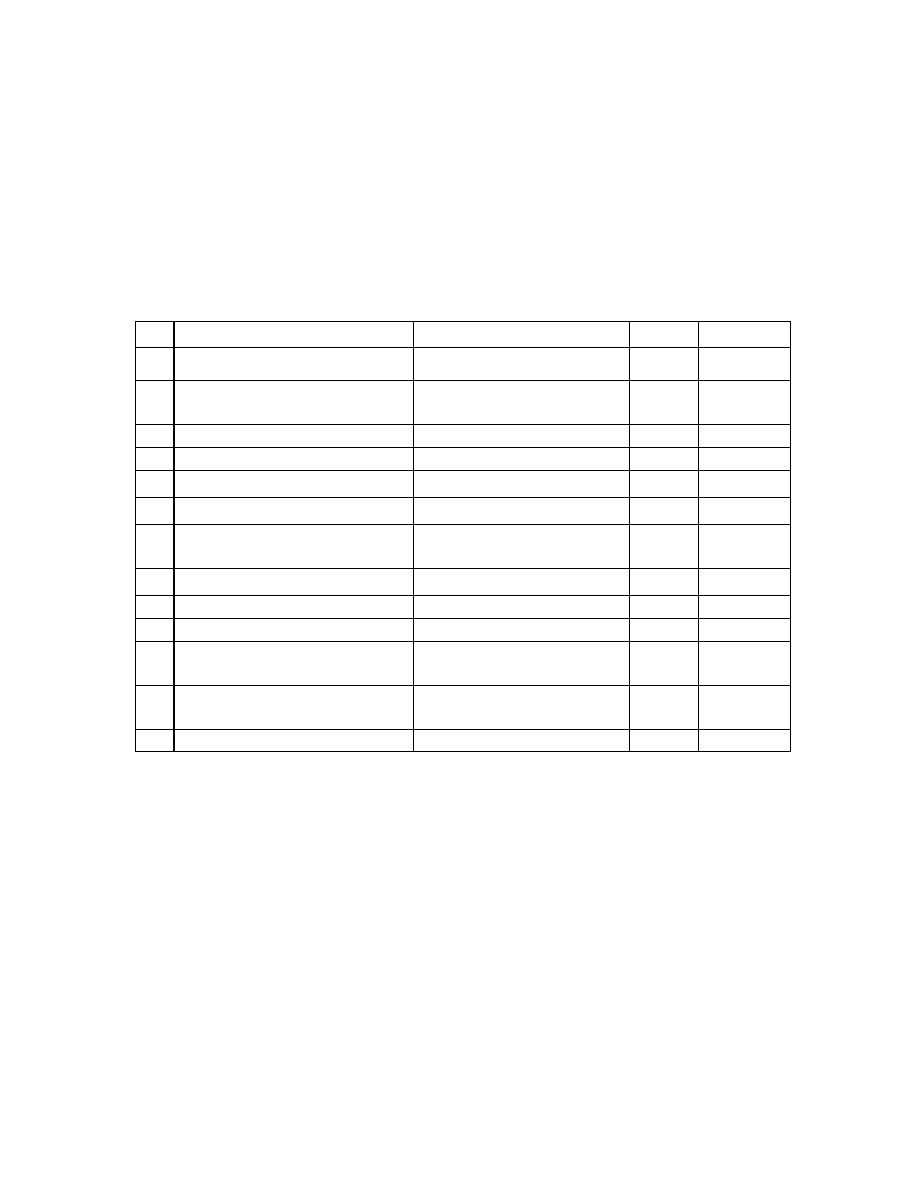
BALĀGU
±
ŪCY
¡
DI TAILA
(AFI, Part-I, 8:34)
Definition:
Balāgu²ūcyādi Taila is a liquid preparation made with the ingredients in the Formulation
composition given below with Tila Taila as the basic ingredient.
Formulation composition:
1.
Balā API
Sida cordifolia
Rt.
256 g
2.
Gu
²
ūcī API
Tinospora cordifolia
St.
256 g
3.
Surapādapa (Devadāru API)
Cedrus deodara
Ht.Wd
.
256 g
4.
Jala API for decoction
Water
12.29 l
Reduced to
3.07 l
5.
Ja
°
ā (Ja
°
āmā
¼
sī API)
Nardostachys jatamansi
Rt./Rz.
16 g
6.
Āmaya (Ku
¾°
ha API)
Saussurea lappa
Rt.
16 g
7.
Candana (Rakta candana API)
Pterocarpus santalinus
Ht.Wd
.
16 g
8.
Kunduru
¾
ka (Kunduru API)
Boswellia serrata
Exd.
16 g
9.
Nata (Tagara API)
Valeriana wallichii
Rt.
16 g
10. Aśvagandhā API
Withania somnifera
Rt.
16 g
11. Sarala API
Pinus roxburghii
Ht.Wd
.
16 g
12. Rāsnā API
Alpinia galanga
(Official substitute)
Rz.
16 g
13. Taila (Tila Taila API)
Sesamum indicum.
Oil
768 g
Method of preparation:
Take all ingredients of pharmacopoeial quality.
Wash and dry all the herbal raw materials thoroughly.
Treat Tila taila to prepare Mūrchita Taila (Appendix 6.2.8.3).
Pulverize the dried ingredients numbered 1to 3 (kvātha dravya) to a coarse powder and
add the specified quantity of water, heat and reduce the volume to one fourth. Filter with
muslin cloth to obtain kvātha.
Take the other ingredients (kalka dravya) numbered 5 to 12 in the formulation
composition, powder and pass through sieve number 85. Transfer the powdered
ingredients to a wet grinder and grind with sufficient quantity of water to prepare a
homogeneous blend (Kalka).
Take Mūrchita Taila in a stainless steel vessel and heat it mildly.
Add increments of Kalka. Stir thoroughly while adding the ka
¾
āya.

Heat for 3 h with constant stirring maintaining the temperature between 500 and 900
during the first hour of heating. Stop heating and allow to stand overnight.
Start heating on next day, stir and constantly check the Kalka by rolling between the
fingers.
Stop the heating when the kalka breaks down into pieces on attempting to form a varti
(khara pāka lak
¾
ana), and at the appearance of froth over the oil. Expose the varti to
flame and confirm the absence of crackling sound indicating absence of moisture.
Filter while hot (about 800) through a muslin cloth and allow to cool.
Pack it in tightly closed containers to protect from light and moisture.
Description: A medicated oil, dark reddish brown in color with pleasant odour.
Identification:
Thin layer chromatography:
Extract 2 g of the
sample
with 20 ml of alcohol at about 400 for 3 h. Cool, separate the
alcohol layer and filter. Concentrate to about 5 ml and carry out thin layer
chromatography. Apply 10 µl of the extract on TLC plate. Develop the plate to a distance
of 8 cm using toluene : ethyl acetate : hexane (6 : 3 : 1) as mobile phase. After
development, allow the plate to dry in air and spray with ethanol-sulphuric acid reagent
followed by heating at 1100 for about 10 min. It shows spots at Rf 0.71 (light brown),
0.80 (light brown) and 0.88 (blackish.brown) under visible light.
Physico-chemical parameters:
Refractive index at 400:
1.455 to 1.460,
Appendix 3.1.
Weight per ml at 400:
0.915 g to 0.930 g,
Appendix 3.2.
Saponification value:
180 to 195,
Appendix
3.10.
Iodine value:
80 to 100,
Appendix
3.11.
Acid value:
Not more than 5,
Appendix
3.12.
Peroxide value:
Not more than 5,
Appendix
3.13.
Other requirements:
Mineral oil:
Absent,
Appendix
3.15.
Microbial Limits:
Appendix 2.4.

Aflatoxins:
Appendix 2.7.
Storage: Store in a cool place in tightly closed containers, protected from light and
moisture.
Therapeutic uses: In conditions of Vāta-rakta (Gout) and Raktagata-Vāta
(Hypertension), Śopha (oedema), Skandhagata Vāta (frozen shoulder).
Dose
:
External application for Abhya
¬
ga.
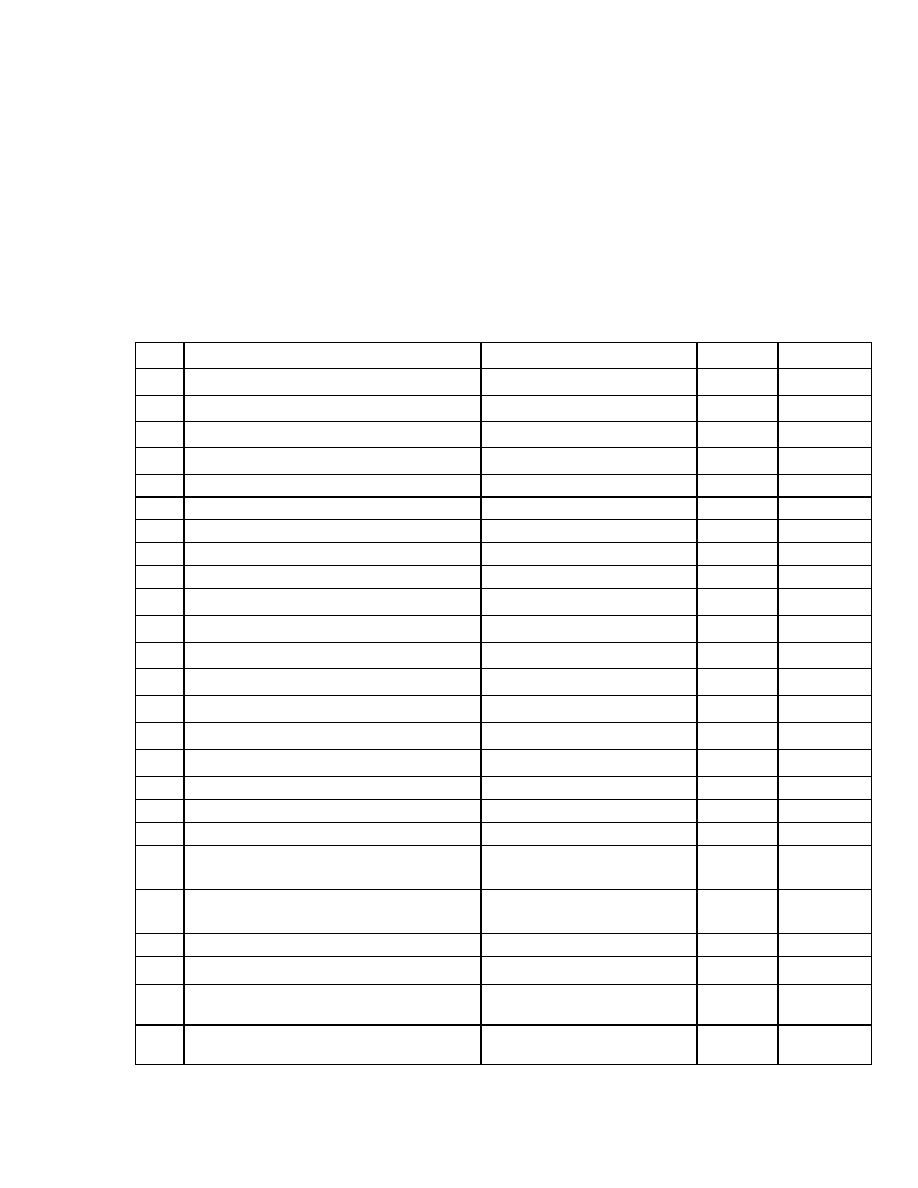
DHĀNVANTARA TAILA
(Syn. Balā Taila)
(AFI, Part-I, 8:22)
Definition:
Dhānvantara Taila is a liquid preparation made with the ingredients in the Formulation
composition given below with Tila Taila as the basic ingredient.
Formulation composition:
1.
Balā mūla (Balā API)
Sida cordifolia
Rt.
4.61 kg
2.
Jala API for decoction
Water
36.86 l
Reduced to
4.61 l
3.
Payah (Godugdha API)
Cow’s milk
4.61 l
4.
Yava API
Hordeum vulgare
Sd.
59.07 g
5.
Kola API
Zizyphus jujuba
Fr.
59.07 g
6.
Kulattha API
Dolichos biflorus
Sd.
59.07 g
7.
Bilva API
Aegle marmelos
St.Bk.
59.07 g
8.
Śyonāka API
Oroxylum indicum
St.Bk.
59.07 g
9
Gambhārī API
Gmelina arborea
St.Bk.
59.07 g
10.
Pā
°
alā API
Stereospermum suaveolens
St.Bk.
59.07 g
11.
Ga
´
ikārikā(Laghu Agnimantha API)
Clerodendrum phlomidis
St.Bk.
59.07 g
12.
Śālapar´ī API
Desmodium gangeticum
Pl.
59.07 g
13.
P
¨
śnipar´ī API
Uraria picta
Pl.
59.07 g
14.
B
¨
hatī API
Solanum indicum
Rt.
59.07 g
15
Ka
´°
akārī API
Solanum surattense
Rt.
59.07 g
16.
Gok
¾
ura API
Tribulus terrestris
Fr.
59.07 g
17.
Jala API for decoction
Water
6.144 l
Reduced to
768 ml
18.
Taila (Tila API)
Sesamum indicum
Oil
768 ml
19.
Medā API
Asparagus racemosus
(Official substitute)
Rt.
6 g
20.
Mahā Medā
Asparagus racemosus
(Official substitute)
Rt.
6 g
21.
Dāru (Devadāru API)
Cedrus deodara
Ht.Wd.
6 g
22.
Ma
®
ji
¾°
ā API
Rubia cordifolia
Rt.
6 g
23.
Kākolī
Withania somnifera
(Official substitute)
Rt.
6 g
24.
K
¾
īra Kākolī
Withania somnifera
(Official substitute )
Rt.
6 g
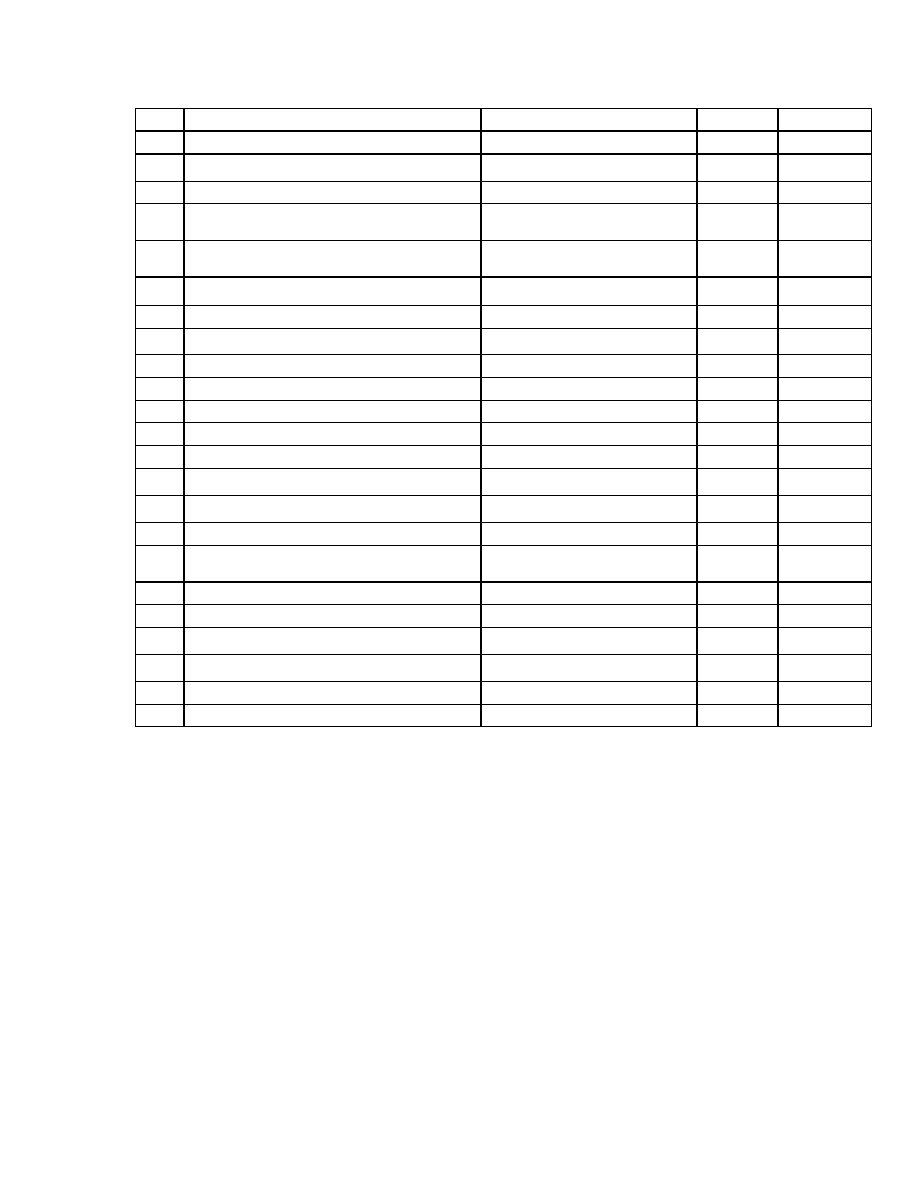
25
Candana (Rakta candana API)
Pterocarpus santalinus
Ht.Wd.
6 g
26.
Śārivā (Śveta śārivā API)
Hemidesmus indicus
Rt.
6 g
27.
Ku
¾°
ha API
Saussurea lappa
Rt.
6 g
28.
Tagara API
Valeriana wallichii
Rt / Rz.
6 g
29.
Jīvaka
Pueraria tuberosa
(Official substitute)
Rt.Tr.
6 g
30.
§¾
abhaka
Pueraria tuberosa
(Official substitute)
Rt.Tr.
6 g
31.
Saindhava lava
´
a API
Rock salt
6 g
32.
Kālānusārī (Tagara API)
Valeriana wallichii
Rz.
6 g
33.
Ś
aileya API
Parmelia perlata
Pl.
6 g
34.
Vacā API
Acorus calamus
Rz.
6 g
35.
Agaru API
Aquilaria agallocha
Ht.Wd.
6 g
36.
Punarnavā (Rakta punarnavā API)
Boerhaavia diffusa
Rt.
6 g
37.
Aśvagandhā API
Withania somnifera
Rt.
6 g
38.
Varī (Śatāvarī API)
Asparagus racemosus
Rt.Tr.
6 g
39.
K
¾
īraśukla (K
¾
īra Vidārī API)
Ipomoea digitata
Rt.Tr.
6 g
40.
Ya
¾°
ī API
Glycyrrhiza glabra
Rt.
6 g
41.
Harītakī API
Terminalia chebula
P.
6 g
42
Āmalakī API
Phyllanthus emblica
(Emblica officinalis)
P.
6 g
43.
Bibhītaka API
Terminalia bellirica
P.
6 g
44.
Śatāhvā API
Anethum sowa
Fr.
6 g
45.
Sūrpapar
´
i (Mā
¾
apar
´
ī API)
Teramnus labialis
Pl.
6 g
46.
Elā (Sūk
¾
mailā API)
Elettaria cardamomum
Sd.
6 g
47.
Tvak API
Cinnamomum zeylanicum
St.Bk
6 g
48.
Patra (Tejapatra API)
Cinnamomum tamala
Lf.
6 g
Method of preparation:
Take all ingredients of Pharmacopoeial quality.
Wash and dry all the herbal raw materials thoroughly.
Treat Tila taila to prepare Mūrchita Taila (Appendix 6.2.8.3).
Pulverize the dried Balā mūla (kvātha dravya) to a coarse powder, add specified amounts
of water, heat and reduce the volume to one eighth. Filter with muslin cloth to obtain Balā
kvātha.
Pulverize the dried ingredients numbered 4 to 16 (kvātha dravya) to coarse powder, add
specified quantity of water, heat and reduce the volume to one eighth. Filter with muslin
cloth to obtain kvātha.
Take the other ingredients (kalka dravya) numbered 19 to 48 in the formulation
composition, powder and pass through sieve number 85. Transfer the powdered
ingredients to a wet grinder and grind with sufficient quantity of water to prepare a
homogeneous blend (Kalka).

Take Mūrchita Taila in a stainless steel vessel and heat it mildly.
Add increments of Kalka. Stir thoroughly while adding the two ka
¾
āyā.
Heat for 3 h with constant stirring maintaining the temperature between 500 and 900
during the first hour of heating. Stop heating and allow to stand overnight.
________________________________________________________________________
_____
Note: Stem bark of the ingredients number 7 to 11 of the formulation composition has
been used in place of root.

Start heating next day, stir and constantly check the kalka by rolling between the fingers.
Stop heating when the kalka breaks down into pieces on attempting to form a varti (khara
pāka lak
¾
a
´
a), and at the appearance of froth over the oil. Expose the varti to flame and
confirm the absence of crackling sound indicating absence of moisture.
Filter while hot (about 800) through a muslin cloth and allow to cool.
Pack it in tightly closed containers to protect from light and moisture.
Description:
A medicated oil, redish brown in color with pleasant odour.
Identification:
Thin layer chromatography:
Extract 2 g of the
sample
with 20 ml of alcohol at about 400 for 3 h. Cool, separate the
alcohol layer and filter. Concentrate to 5 ml and carry out the thin layer chromatography.
Apply 10 µl of the extract on TLC plate. Develop the plate to a distance of 8 cm using
toluene : ethyl acetate : hexane (6 : 3 : 1) as mobile phase. After development, allow the
plate to dry in air and spray with ethanol-sulphuric acid reagent followed by heating at
1100 for about 10 min. It shows spots at Rf 0.31 (light brown), 0.71 (brown), 0.83 (light
brown) and 0.91 (blackish brown) under visible light.
Physico-chemical parameters:
Refractive index at 400:
1.465 to 1.465,
Appendix 3.1.
Weight per ml at 400:
0.930 g to 0.940 g,
Appendix 3.2.
Saponification value:
180 to 195,
Appendix
3.10.
Iodine value:
100 to 120,
Appendix
3.11.
Acid value:
Not more than 4,
Appendix
3.12.
Peroxide value:
Not more than 5,
Appendix
3.13.
Other requirements:
Mineral oil:
Absent,
Appendix
3.15.
Microbial Limits:
Appendix 2.4.
Aflatoxins:
Appendix 2.7.

Storage: Store in a cool place in tightly closed containers, protected from light and
moisture.
Therapeutic uses: Vāta roga (diseases due to Vāta do
¾
a); Pak
¾
avadha (Hemiplegia);
Sarvā
¬
ga vāta (Quadriplegia); Dhātu k
¾
aya (tissue wasting); Sūtikā roga
(Puerperal diseases) and Bāla roga (diseases of children). External application
f o r
Abhya
¬
ga.
Dose: Internally 6 to 12 ml daily in divided doses; as well as external application Q.S.
.

GA
N
DHARVAHASTA TAILA
(AFI, Part-I, 8:12)
Definition:
Gandharvahasta Taila is a liquid preparation made with the ingredients in the Formulation
composition described below with Tila Taila as the basic ingredient.
Formulation composition:
1. Gandharva hasta mūla (Era
´²
a API)
Ricinus communis
Rt.
4.8 k g
2. Yava API
Hordeum vulgare
Sd.
3.07 kg
3. Nāgara (Śu
´°
hī API)
Zingiber officinale
Rz.
96 g
4. Jala API for decoction
Water
24.58 l
Reduced to
6.14 l
5. K
¾
īra (Godugdha API)
Cow’s milk
1.54 l
6. Era
´
²
a API -Taila
Ricinus communis
Oil
768 g
7. Gandharvahasta mūla (Era
´²
a API)
Ricinus communis
Rt.
192 g
8. Śu
´°
hī API
Zingiber officinale
Rz.
48 g
Method of preparation:
Take all ingredients of pharmacopoeial quality.
Wash and dry all the herbal raw materials thoroughly.
Treat Era
´²
a taila to prepare Mūrchita Era
´
²
a Taila (Appendix 6.2.8.1).
Pulverize the dried ingredients numbered 1 to 3 (kvātha dravya) to a coarse powder, add
required amount of water, heat and reduce the volume to one fourth. Filter with muslin
cloth to obtain kvātha. Take the other ingredients (kalka dravyas) numbered 7 and 8 of
the formulation composition, dry, powder and pass through sieve number 85. Transfer the
powdered ingredients to wet grinder and grind with sufficient quantity of water to prepare
a homogeneous blend.
Take Mūrchita Taila in a stainless steel vessel and heat it mildly.
Add increments of Kalka. Stir thoroughly while adding the Kvātha and Godugdha.
Heat for 3 h with constant stirring maintaining the temperature between 500 and 900
during the first hour of heating. Stop heating and allow to stand overnight.
Start the heating next day, stir and observe the boiling mixture for appearance of froth
and constantly check the kalka for formation of varti (madhyama pāka lak
¾
a
´
a).
Expose the varti to flame and confirm the absence of crackling sound indicating absence
of moisture. Stop heating when the kalka forms a varti and the froth appears. Filter while
hot (about 800) through a muslin cloth and allow to cool.
Pack it in tightly closed containers to protect from light and moisture.
Description:

A medicated oil, yellowish brown in color with characteristic odour.
Identification:
Thin layer chromatography:
Extract 2 g of the
sample
with 20 ml of alcohol at about 400 for 3 h. Cool, separate the
alcohol layer and filter. Concentrate to 5 ml and carry out the thin layer chromatography.
Apply 10 µl of the extract on TLC plate. Develop the plate to a distance of 8 cm using
toluene : ethyl acetate : hexane (6 : 3 : 1) as mobile phase. After development, allow the
plate to dry in air and spray with ethanol-sulphuric acid reagent followed by heating at
1100 for about 10 min. It shows spots at Rf 0.45 (light grey), 0.52 (grey), 0.75 (dark
brown) and 0.81 (dark brown) under visible light.
Physico-chemical parameters:
Refractive index at 400:
1.451 to 1.460,
Appendix 3.1.
Weight per ml at 400:
0.975 g to 0.985 g,
Appendix 3.2.
Saponification value:
180 to 200,
Appendix
3.10.
Iodine value:
75 to 100,
Appendix
3.11.
Acid value:
Not more than 4,
Appendix
3.12.
Peroxide value:
Not more than 2,
Appendix
3.13.
Other requirements:
Mineral oil:
Absent,
Appendix
3.15.
Microbial Limits:
Appendix 2.4.
Aflatoxins:
Appendix
2.7.
Storage: Store in a cool place in tightly closed containers, protected from light and
moisture.
Therapeutic uses
:
Vidradhi (abscess); Plīhā (enlargement of spleen); Gulma (abdominal
lump); Udāvarta (upward movement of gases); Śopha (oedema); Udara (diseases of
abdomen) and MahāVāta roga (major neurological disorders).

Dose
:
6 to12 ml daily in divided doses
Anupāna: Warm water.

KO
¯¯
AMCUKK
¡
DI TAILA
(AFI, Part-I, 8:10)
Definition:
Ko
°°
amcukkādi Taila is a liquid preparation made with the ingredients in the Formulation
composition given below with Tila Taila as the basic ingredient
Formulation composition:
1. Ko
°°
am (Ku
¾
°
ha API)
Saussurea lappa
Rt.
21 g
2. Cukku (Śu
´
°hī API)
Zingiber officinale
Rz.
21 g
3. Vayambu (Vacā API)
Acorus calamus
Rz.
21 g
4. Śigru API
Moringa oleifera
St Bk.
21 g
5. Laśuna API
Allium sativum
Bl.
21 g
6. Kārto
°°
i (Hi
¼
srā API)
Capparis spinosa
Rt.
21 g
7. Devadruma (Devadāru API)
Cedrus deodara
Ht.Wd
21 g
8. Siddhārtha (Sar
¾
apa API)
Brassica campestris
Sd.
21 g
9.
Suvahā (Rāsnā API)
Alpinia galanga
(Official substitute)
Rz.
21 g
10.
Tilaja (Tila API)
Sesamum indicum
Oil
768 g
11.
Dadhi (Godadhi API)
Curd from cow’s
milk
768 g
12.
Ci®cā rasa (Ci®cā API)
Tamarindus indica
Lf.
3.07 l
Method of preparation:
Take all ingredients of pharmacopoeial quality.
Wash and dry all the herbal raw materials except ingredient 12 thoroughly.
Treat Tila taila to prepare Mūrchita Taila (Appendix 6.2.8.3).
Collect fresh leaves of ingredient number 12, wash thoroughly, grind and express svarasa
through muslin cloth.
Take the other ingredients (kalka dravyas) with the exception of Laśuna and Sar
¾
apa,
dry, powder and pass through sieve number 85. Grind Laśuna
and
Sar
¾
apa
separately, add the powdered ingredients and grind with
sufficient quantity
of water to prepare a homogeneous blend. (Kalka)
Take Mūrchita Taila in a stainless steel vessel and heat it mildly.
Add increments of Kalka. Stir thoroughly while adding the Svarasa and Godadhi.
Heat for 3 h with constant stirring maintaining the temperature between 50 and 900
during the first hour of heating. Stop heating and allow to stand overnight.
.

Start heating next day, stir and constantly check the Kalka by rolling between the fingers.
Stop heating when the kalka breaks down into pieces on attempting to form a varti (khara
pāka laksana), and at the appearance of froth over oil. Expose the varti to flame and
confirm the absence of crackling sound indicating absence of moisture.
Filter while hot (about 800) through a muslin cloth and allow to cool.
Pack it in tightly closed containers to protect from light and moisture.
Description:
A medicated oil, colour reddish brown, odour faint.
Identification:
Thin layer chromatography:
Extract 2 g of the
sample
with 20 ml of alcohol at about 400 for 3 h. Cool, separate the
alcohol layer, filter, concentrate to 5 ml and carry out the thin layer chromatography.
Apply 10 µl of the extract on TLC plate and develop the plate to a distance of 8 cm using
toluene : ethyl acetate : hexane (6 : 3 : 1) as mobile phase. After development, allow the
plate to dry in air and spray with ethanol-sulphuric acid reagent followed by heating
1100 for about 10 min. It shows spots at Rf 0.32 (light grey), 0.44 (light grey), 0.53 (light
grey), 0.71 (brown), and 0.80 (brown) under visible light.
Physico-chemical parameters:
Refractive index at 400:
1.461 to 1.463,
Appendix 3.1.
Weight per ml at 400:
0.920 to 0.940 g,
Appendix 3.2.
Saponification value:
150 to 175,
Appendix
3.10.
Iodine value:
75 to 100,
Appendix
3.11.
Acid value:
Not more than 8,
Appendix
3.12.
Peroxide value:
Not more than 4,
Appendix
3.13.
Other requirements:
Mineral oil:
Absent,
Appendix
3.15.
Microbial Limits:
Appendix 2.4.
Aflatoxins:
Appendix 2.7.
Storage: Store in a cool place in tightly closed containers, protected from light and
moisture.

Therapeutic uses: Āmavāta (Rheumatism); Vāta roga (disorders due to Vāta do
¾
a) and
Angastambha (stiffness of body); External application for Abhya
´
ga.

K
¾
ĪRABALĀ TAILA
(AFI, Part-I, 8:11)
Definition:
K
¾
īrabalā taila is a liquid preparation made with the ingredients in the Formulation
composition given below with Tila Taila as the basic ingredient.
Formulation composition:
1.
Balā ka
¾
āya (Balā API)
Sida cordifolia
Rt.
16
parts
2.
Balā Kalka (Balā API)
Sida cordifolia
Rt.
1 part
3.
Taila API (Tila)
Sesamum indicum
Ol.
4 parts
4.
K
¾
īra (Godugdha API)
Cow’s milk
4 parts
5.
Jala API
Water
16
parts
Method of preparation:
Take all ingredients of pharmacopoeial quality.
Wash and dry Balā thoroughly.
Treat Tila taila to prepare Mūrchita Taila. (Appendix 6.2.8.3).
Pulverize the dried Balā mūla (Kvātha dravya) to a coarse powder, add specified quantity
of water, heat and reduce the volume to one fourth. Filter with muslin cloth to obtain Balā
kvātha.
Take the ingredient (Kalka dravya) numbered 2 in the formulation composition, wash,
dry, powder and pass through sieve number 85. Transfer the powdered ingredient to wet
grinder and grind with sufficient quantity of water to prepare a homogeneous blend.
(Kalka)
Take Mūrchita Taila in a stainless steel vessel and heat it mildly.
Add increments of Kalka. Stir thoroughly while adding the ka
¾
āya, Godugdha and water.
Heat for 3 h with constant stirring maintaining the temperature between 500 and 900
during the first hour of heating. Stop heating and allow to stand overnight.
Start heating next day, stir and constantly check the Kalka by rolling between the fingers.
Stop heating when the kalka breaks down into pieces on attempting to form a varti (khara
pāka lak
¾
a
´
a), and at the appearance of froth over the oil. Expose the varti to flame and
confirm the absence of crackling sound indicating absence of moisture. Filter while hot
(about 800) through a muslin cloth and allow to cool.
Pack it in tightly closed containers to protect from light and moisture.

Description:
A medicated oil, dark brown in color with pleasant odour.

Identification:
Thin layer chromatography:
Extract 2 g of the
sample
with 20 ml of alcohol at about 400 for 3 h. Cool, separate the
alcohol layer, filter, concentrate to 5 ml and carry out the thin layer chromatography.
Apply 10 µl of the extract on TLC plate and develop the plate to a distance of 8 cm using
toluene : ethyl acetate : hexane (6 : 3 : 1) as mobile phase. After development, allow the
plate to dry in air and spray with ethanol-sulphuric acid reagent followed by heating at
1100 for about 10 min. It shows spots at Rf 0.42 (brown), 0.57 (brown), 0.70 (grey) and
0.80 (light grey) under visible light.
Physico-chemical parameters:
Refractive index at 400:
1.451 to 1.460,
Appendix 3.1.
Weight per ml at 400:
0.930 g to 0.945 g,
Appendix 3.2.
Saponification value:
185 to 200,
Appendix
3.10.
Iodine value:
75 to 100,
Appendix
3.11.
Acid value:
Not more than 6.5,
Appendix
3.12.
Peroxide value:
Not more than 2,
Appendix
3.13.
Other requirements:
Mineral oil:
Absent,
Appendix
3.15.
Microbial Limits:
Appendix 2.4.
Aflatoxins:
Appendix 2.7.
Storage: Store in a cool place in tightly closed containers, protected from light and
moisture.
Therapeutic uses: Vātarakta (Gout); Vāta roga (disorders due to Vāta do
¾
a); Śukra do
¾
a
(Vitiation of
º
ukra dhatu); Rajo do
¾
a (Menstrual disorders); Kārśya (Emaciation);
Svarabheda (hoarseness of voice). External application for Abhya
¬
ga, Nasya (nasal
drops), Pāna (oral use), Bastiprayoga (enema).
Dose: 6 to 12 ml daily in divided doses.
Anupāna: Warm water, milk.


SAINDHAVĀDI TAILA
(AFI, Part-I, 8:60)
Definition:
Saindhav
¢
di Taila is a liquid preparation made with the ingredients in the Formulation
composition given below with tila taila as the basic ingredients.
Formulation composition:
1.
Saindhava lava
´
a
Rock salt
28
g
2.
Arka API
Calotropis procera
Rt.
28
g
3.
Marica API
Piper nigrum
Fr.
28
g
4.
Jvalanākhya (Citraka) API
Plumbago zeylanica
Rt.
28
g
5.
Mārkava (Bh
¨¬
garāja) API
Eclipta alba
Pl.
28
g
6.
Haridrā API
Curcuma longa
Rz.
28
g
7.
Dāruharidrā API
Berberis aristata
St.
28
g
8.
Tila taila API
Sesamum indicum
Ol.
768
g
9.
Jala API
Water
3.07 l
Method of preparation:
Take all ingredient of pharmacopoeia quality.
Treat tila taila is prepare Mūrchit tila taila. (Appendix 6.2.8.3.)
Wash, dry, powder the ingredients number 2 to 7 of the formulation composition (Kalka
Dravya) and pass through sieve number 85 to obtain fine powder. Transfer the powdered
ingredients to a wet grinder, add ingredient number 1 of the formulation composition and
grind with required amount of water to obtain a homogeneous blend (Kalka)
Take Mūrchita taila in a stainless steel vessel and heat it mildly.
Add increments of Kalka. Stir thoroughly while adding water. Heat for 3 h with constant
stirring maintaining the temperature between 500 to 900 during the first hour of heating.
Stop heating and allow to stand over night.
Start heating next day, stir and constantly check the kalka by rolling between the fingers.
Stop heating when the kalka breaks down in to pieces on attempting to form varti (Khara

paka lakshana) and at the appearance of froth over oil. Expose the varti to flame and
confirm the absence of crackling sound indication absence of moisture.
Filter while hot at about 800 through a muslin cloth and allow to cool.
Pack it in tightly closed containers to protect from light and moisture.
Description:
Reddish yellow oily liquid, sticky to touch.

Identification:
Thin layer chromatography:
Extract 25 ml of the formulation in a separatory funnel with methanol (20 ml x 3 ). Pool
the methanolic extracts, concentrate and make up the volume to 20 ml and carry out the
Thin Layer Chromatography. Apply 20 µl on TLC plate. Develop the plate to a distance
of 8 cm using toluene : ethyl acetate (7 : 3) as mobile phase. After development allow the
plate to dry in air and examine under ultraviolet light (254 nm). It shows major spots at
Rf 0.29, 0.35, 0.50, 0.60, 0.75, 0.82 and 0.90. Under ultraviolet light (366 nm), the plate
shows fluorescent spots at Rf 0.10 (light blue), 0.13 (light blue), 0.30 (light green), 0.35
(yellow), 0.53 (blue), 0.68 (light blue), 0.75 (light green), 0.86 (blue). Spray the plate with
anisaldehyde-sulphuric acid reagent followed by heating at 1100 for about 10 min. It
shows major spots at Rf 0.15 (light violet), 0.35 (brown), 0.50 (light violet), 0.60 (light
violet), 0.70 (light blue violet), 0.80 (red), 0.87 (light brown) and 0.97 (light violet) under
visible light.
Physico-chemical parameters:
Refractive index at 250:
1.473 to 1.478,
Appendix 3.1.
Weight per ml at 250:
0.950 to 0.951 g,
Appendix 3.2.
Saponification value:
185 to 200,
Appendix.
3.10.
Iodine value:
100 to 115,
Appendix
3.11.
Acid value:
Not more than
5.0
,
Appendix
3.12.
Peroxide value:
Not more than 6,
Appendix
3.13.
Other requirements:
Mineral oil
Absent,
Appendix
3.15.
Microbial limits:
Appendix 2.4.
Aflatoxins:
Appendix. 2.7.
Storage: Store in a cool place in tightly closed containers, protected from light and
moisture.
Therapeutic uses: Kaphavātaja nā²ī vra
´
a (Sinus due to Kapha do
¾
a and Vāta do
¾
a).

Dose: As prescribed by the physician for Abhya
¬
ga (External use).

LEPA
Lepas are semi-solid preparations intended for external application to the skin or
certain mucous membranes for emollient, protective, therapeutic or prophylactic purposes
where a degree of occlusion is desired. They usually consist of solutions or dispersions of
one or more medicaments in suitable bases.
The base should not produce irritation or sensitization of the skin, nor should it
retard wound healing; it should be smooth, inert, odourless, physically and chemically
stable and compatible with the skin and with incorporated medicaments.
The proportions of the base ingredients should be such that the ointment is not too
soft or too hard for convenient use. The consistency should be such that the ointment
spreads and softens when stress is applied.

DĀRVĪ MALAHARA (GEL)
(Based on Carak Chikitsa 25/93)
Definition:
Dārvī Malahara is a semisolid preparation made with the ingredients given in the
Formulation composition.
Formulation Composition:
1.
Rasā®jana API
Berberis aristata / B. asiatica / B. lycium root extract 2 g
2.
Spha
°
ikā
Alum or Potable Alums
1 g
3.
Tragacanth
2 g
4.
Xanthan gum FF
1 g
5.
Propylene glycol
4
ml
6.
Methyl paraben
0.17 g
7.
Propyl paraben
0.03 g
8.
Disodium edentate
0.01 g
9.
Peppermint oil
0.05 ml
10. Jala API
Water
100
g
Method of Preparation:
Preparation of Rasanjana:
Rasā®jana is the dried aqueous extract of the roots of Dāruharidrā, (Berberis aristata or
B. asiatica or B. lycium, Fam. Berberidaceae), and is prepared by the following method.
Chop Dāruharidrā into small pieces of about 1 cm thickness. Powder the chopped roots
to a yavkuta (powder whose all particles pass through sieve number 22 and not more than
10 per cent pass through sieve number 44). Weigh the powder and transfer to a suitable
extraction vessel. Add Purified water (5 times the weight of drug), allow to soak
overnight (12 h), followed by gentle boiling for 4 h. Stop the boiling and allow the
contents to settle down. Separate the water layer and filter while hot. Repeat the
extraction two times more using fresh Purified water (4 times the weight of drug).
Remove the water from the combined extract as completely as possible. At this stage the
extract solidifies on cooling. Dry the solidified extract further in an oven, preferably a
vacuum oven at a temperature below 600.
Pack it in tightly closed containers to protect from light and moisture.
.

Preparation of Dārvī Malahara:
Weigh all the ingredients separately. Mix well the powders of tragacanth and xanthan
gum. Take 50 ml of purified water in a 250-ml container and transfer gum mixture with
continuous stirring to avoid formation of lumps. Keep it aside for 6 h for complete
dispersion and hydration. Dissolve powder of Sphatikā (potash alum) in 10 ml of warm
(600) purified water and add this solution after cooling to gum mixture with stirring.
Dissolve methyl paraben, propyl paraben, disodium edetate in a mixture of 4 ml of
propylene glycol and 6 ml of purified water and heat for 5 min at 600. Cool and add this
solution with continuous stirring to the mixture of gums and alum. Dissolve Rasā
®
jana in
10 ml of purified water and add to the gel (mixture of gum and alum) and mix well.
Adjust the weight of gel to 100 g with purified water. Adjust the pH between 3.7 and 4.2
with sufficient triethanolamine (approximately 3 to 4 drops). Add 0.1 ml of peppermint
oil or other permissible flavour to the prepared gel and mix well. Fill the gel in
aluminium / plastic tubes.
Description:
Yellowish-brown, non-gritty, smooth gel.
Identification:
Test for Berberine: Dissolve about 2 g of Dārvī Malahara in 20 ml of water and filter.
Take about 2 ml of the filtrate and add 1 ml of concentrated nitric acid. A dark red colour
is formed.
Test for Spha
°
ikā: Dip a spatula in the water solution of Dārvī Malahara. Take it out and
let it dry. Hold spatula in a nonluminous flame; a violet colour is imparted to the flame.
Physico-chemical parameters:
pH (5% aqueous solution) : 3.7 to 4.2
Appendix 3.3.
Assay:
Sample contains not less than 0.08 per cent of berberine when assayed by the following
method.
Estimation of Berberine: Dissolve about 25 mg of accurately weighed Berberine
hydrochloride in water and makeup the volume to 25 ml in a volumetric flask. Transfer
1,2,3,4,5 and 6 ml of this stock solution separately to six 25 ml- volumetric flasks and
makeup the volume in each to 25 ml.
Apply in triplicate 1 µl of each dilution on a TLC plate. Develop the plate to a distance of
8 cm using n-propanol : formic acid : water (8.1: 0.1: 1.8) as mobile phase. After
development, dry the plate in air and scan at 343 nm in a TLC scanner. Note the area
under the curve for peak corresponding to berberine and prepare the calibration curve by
plotting peak area vs amount of berberine hydrochloride.

Dissolve accurately weighed about 1 g of Dārvī Malahara in 5 ml of distilled water and
make up the volume to 25 ml in a volumetric flask with distilled water. Filter the
solution and discard the first 5 ml of the solution. Collect the next 5 ml of solution and
use for analysis. Apply 1 µl of solution in triplicate on a TLC plate and develop, dry and
scan the plate as described in preceding paragraph for calibration curve of berberine.
Calculate the amount of berberine in the test solution from the calibration curve of
berberine hydrochloride and determine the concentration of berberine in the Dārvī
Malahara.
Other requirements:
Microbial limits:
Appendix. 2.4.
Aflatoxins:
Appendix. 2.7.
Dose: 2g twice a day to be applied with applicator in vagina.
Storage: At room temperature.
Therapeutic uses: Sveta Pradara (Leucorrhoea), Yonika
´
²
ū (Itching), Yoni sotha,
(Vaginitis and other wounds and ulcers).
Precaution: Discontinue if there is any irritation or discomfort.
Wyszukiwarka
Podobne podstrony:
więcej podobnych podstron